Quick filters:
Phototaxis Stock Photos and Images
RMDH97BJ–3D chamber for tracking swimming of individual cell organisms via phototaxis, in biofuel energy & ecological research
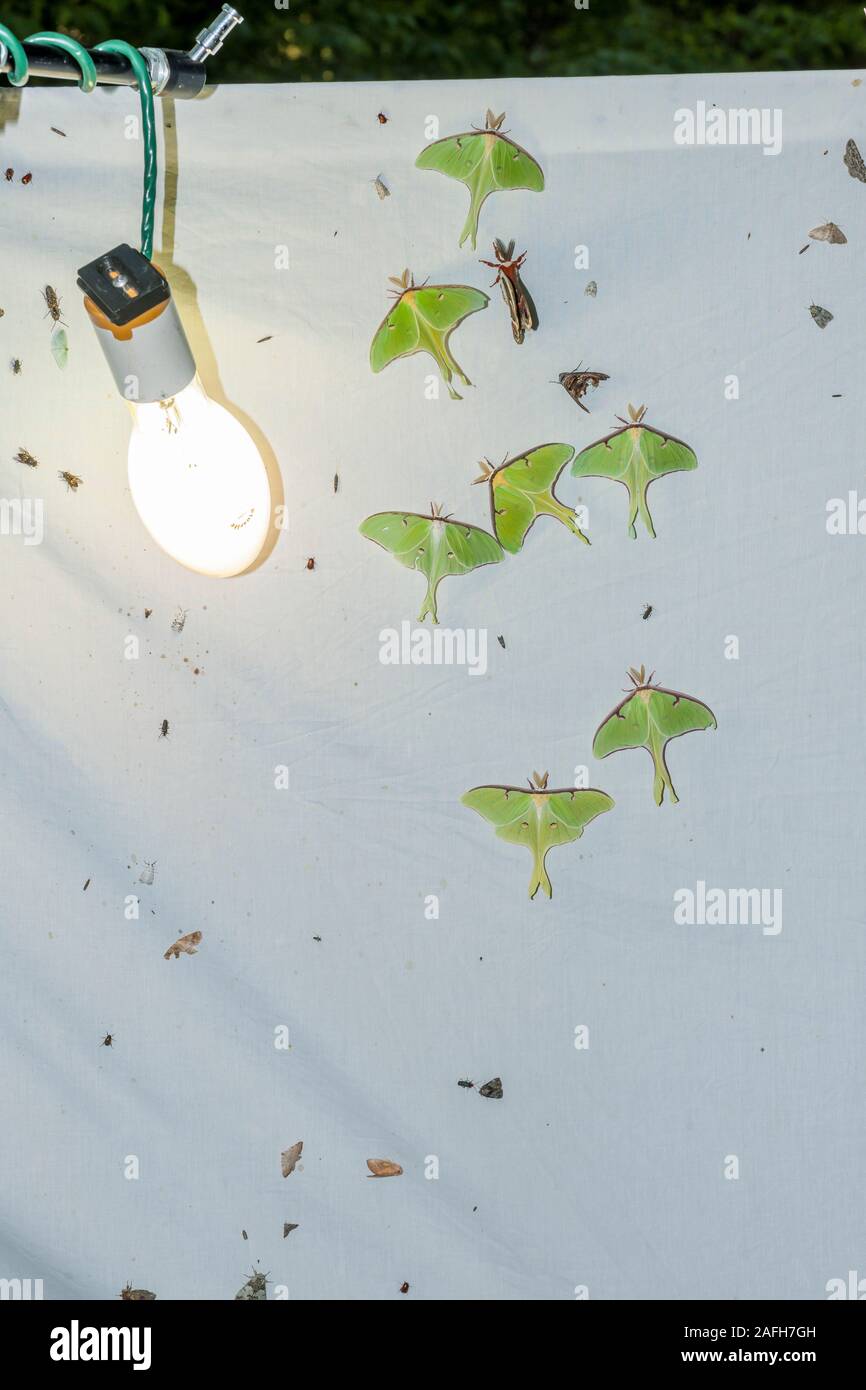 Large number of Luna Moths on sheet during a spring mercury vapor night lighting session near Congaree River, South Carolina. Also note the Cecropia M Stock Photohttps://www.alamy.com/image-license-details/?v=1https://www.alamy.com/large-number-of-luna-moths-on-sheet-during-a-spring-mercury-vapor-night-lighting-session-near-congaree-river-south-carolina-also-note-the-cecropia-m-image336595969.html
Large number of Luna Moths on sheet during a spring mercury vapor night lighting session near Congaree River, South Carolina. Also note the Cecropia M Stock Photohttps://www.alamy.com/image-license-details/?v=1https://www.alamy.com/large-number-of-luna-moths-on-sheet-during-a-spring-mercury-vapor-night-lighting-session-near-congaree-river-south-carolina-also-note-the-cecropia-m-image336595969.htmlRM2AFH7GH–Large number of Luna Moths on sheet during a spring mercury vapor night lighting session near Congaree River, South Carolina. Also note the Cecropia M
 Koeln, symbol phototaxis Stock Photohttps://www.alamy.com/image-license-details/?v=1https://www.alamy.com/stock-photo-koeln-symbol-phototaxis-49285169.html
Koeln, symbol phototaxis Stock Photohttps://www.alamy.com/image-license-details/?v=1https://www.alamy.com/stock-photo-koeln-symbol-phototaxis-49285169.htmlRMCT53MH–Koeln, symbol phototaxis
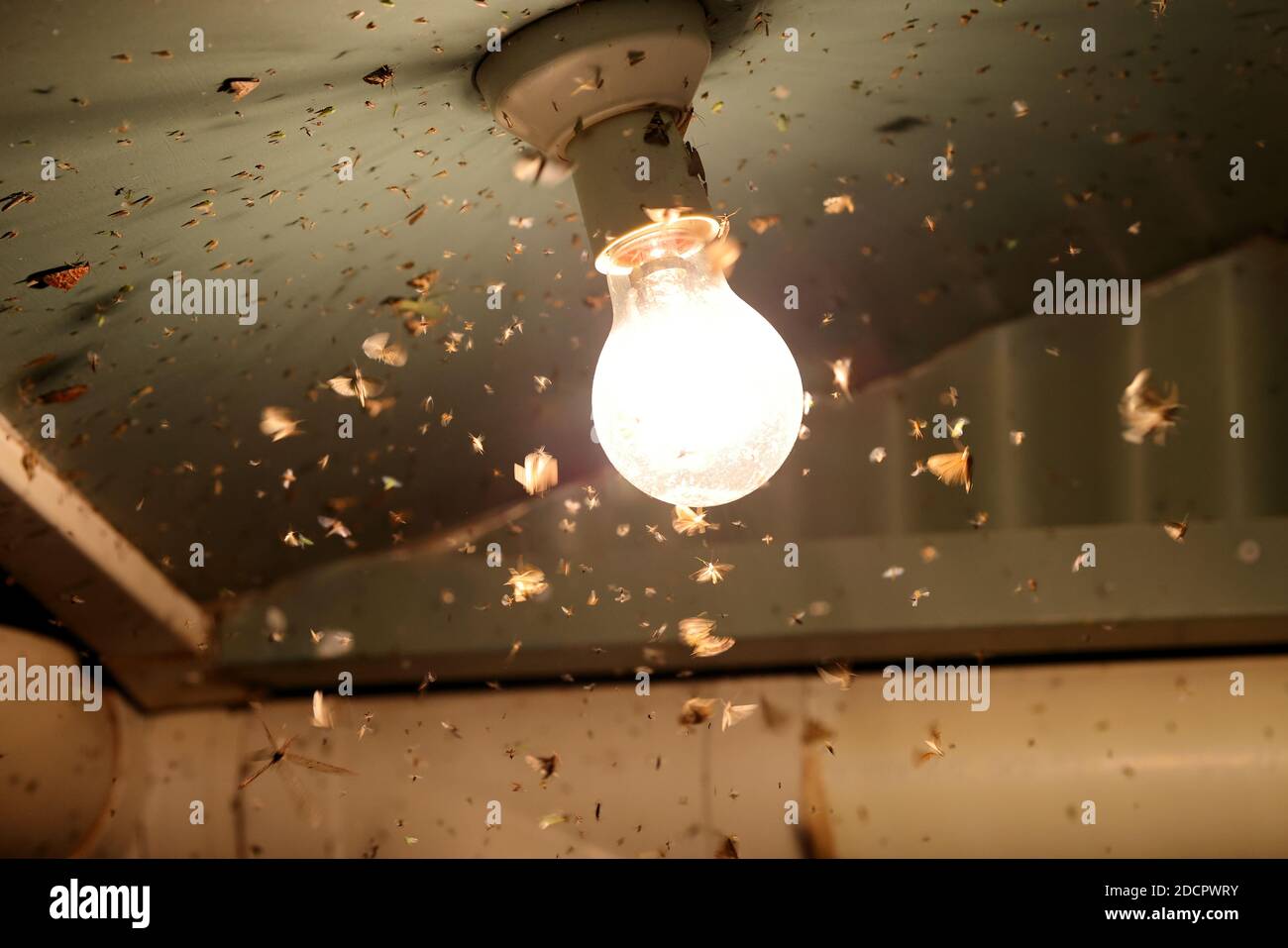 Moths and insects flying around a light globe Stock Photohttps://www.alamy.com/image-license-details/?v=1https://www.alamy.com/moths-and-insects-flying-around-a-light-globe-image386507183.html
Moths and insects flying around a light globe Stock Photohttps://www.alamy.com/image-license-details/?v=1https://www.alamy.com/moths-and-insects-flying-around-a-light-globe-image386507183.htmlRF2DCPWRY–Moths and insects flying around a light globe
 butterfly on plant with some parts in focus Stock Photohttps://www.alamy.com/image-license-details/?v=1https://www.alamy.com/butterfly-on-plant-with-some-parts-in-focus-image362118052.html
butterfly on plant with some parts in focus Stock Photohttps://www.alamy.com/image-license-details/?v=1https://www.alamy.com/butterfly-on-plant-with-some-parts-in-focus-image362118052.htmlRF2C13W7G–butterfly on plant with some parts in focus
 Wasp on a lamp Stock Photohttps://www.alamy.com/image-license-details/?v=1https://www.alamy.com/wasp-on-a-lamp-image543792420.html
Wasp on a lamp Stock Photohttps://www.alamy.com/image-license-details/?v=1https://www.alamy.com/wasp-on-a-lamp-image543792420.htmlRF2PGKTNT–Wasp on a lamp
 Phototaxis moth to light ©mak Stock Photohttps://www.alamy.com/image-license-details/?v=1https://www.alamy.com/phototaxis-moth-to-light-mak-image421271.html
Phototaxis moth to light ©mak Stock Photohttps://www.alamy.com/image-license-details/?v=1https://www.alamy.com/phototaxis-moth-to-light-mak-image421271.htmlRMA66D97–Phototaxis moth to light ©mak
 Mayfly are flying, playing around the fluorescent lights. Stock Photohttps://www.alamy.com/image-license-details/?v=1https://www.alamy.com/mayfly-are-flying-playing-around-the-fluorescent-lights-image359104324.html
Mayfly are flying, playing around the fluorescent lights. Stock Photohttps://www.alamy.com/image-license-details/?v=1https://www.alamy.com/mayfly-are-flying-playing-around-the-fluorescent-lights-image359104324.htmlRF2BT6H6C–Mayfly are flying, playing around the fluorescent lights.
 General physiology; an outline of the science of life . se researchesof Strasburger comes awhole series of observationsby other investigators, whohave been able to findphototactic phenomena inall sorts of micro-organisms.Thus, Stahl (84) investi-gated the phototaxis ofplasmodia of Myxomycetes,previously observed by Hof-meister and Baranetzky, andfound that young plasmodiaof Acthalium septiatm are positively phototactic in half-darkness, and creep upon the surfaceof tan, but with stronger illumination they become negatively photo-tactic, and flow back again into the interior of the mass. Furthe Stock Photohttps://www.alamy.com/image-license-details/?v=1https://www.alamy.com/general-physiology-an-outline-of-the-science-of-life-se-researchesof-strasburger-comes-awhole-series-of-observationsby-other-investigators-whohave-been-able-to-findphototactic-phenomena-inall-sorts-of-micro-organismsthus-stahl-84-investi-gated-the-phototaxis-ofplasmodia-of-myxomycetespreviously-observed-by-hof-meister-and-baranetzky-andfound-that-young-plasmodiaof-acthalium-septiatm-are-positively-phototactic-in-half-darkness-and-creep-upon-the-surfaceof-tan-but-with-stronger-illumination-they-become-negatively-photo-tactic-and-flow-back-again-into-the-interior-of-the-mass-furthe-image338492938.html
General physiology; an outline of the science of life . se researchesof Strasburger comes awhole series of observationsby other investigators, whohave been able to findphototactic phenomena inall sorts of micro-organisms.Thus, Stahl (84) investi-gated the phototaxis ofplasmodia of Myxomycetes,previously observed by Hof-meister and Baranetzky, andfound that young plasmodiaof Acthalium septiatm are positively phototactic in half-darkness, and creep upon the surfaceof tan, but with stronger illumination they become negatively photo-tactic, and flow back again into the interior of the mass. Furthe Stock Photohttps://www.alamy.com/image-license-details/?v=1https://www.alamy.com/general-physiology-an-outline-of-the-science-of-life-se-researchesof-strasburger-comes-awhole-series-of-observationsby-other-investigators-whohave-been-able-to-findphototactic-phenomena-inall-sorts-of-micro-organismsthus-stahl-84-investi-gated-the-phototaxis-ofplasmodia-of-myxomycetespreviously-observed-by-hof-meister-and-baranetzky-andfound-that-young-plasmodiaof-acthalium-septiatm-are-positively-phototactic-in-half-darkness-and-creep-upon-the-surfaceof-tan-but-with-stronger-illumination-they-become-negatively-photo-tactic-and-flow-back-again-into-the-interior-of-the-mass-furthe-image338492938.htmlRM2AJKK5E–General physiology; an outline of the science of life . se researchesof Strasburger comes awhole series of observationsby other investigators, whohave been able to findphototactic phenomena inall sorts of micro-organisms.Thus, Stahl (84) investi-gated the phototaxis ofplasmodia of Myxomycetes,previously observed by Hof-meister and Baranetzky, andfound that young plasmodiaof Acthalium septiatm are positively phototactic in half-darkness, and creep upon the surfaceof tan, but with stronger illumination they become negatively photo-tactic, and flow back again into the interior of the mass. Furthe
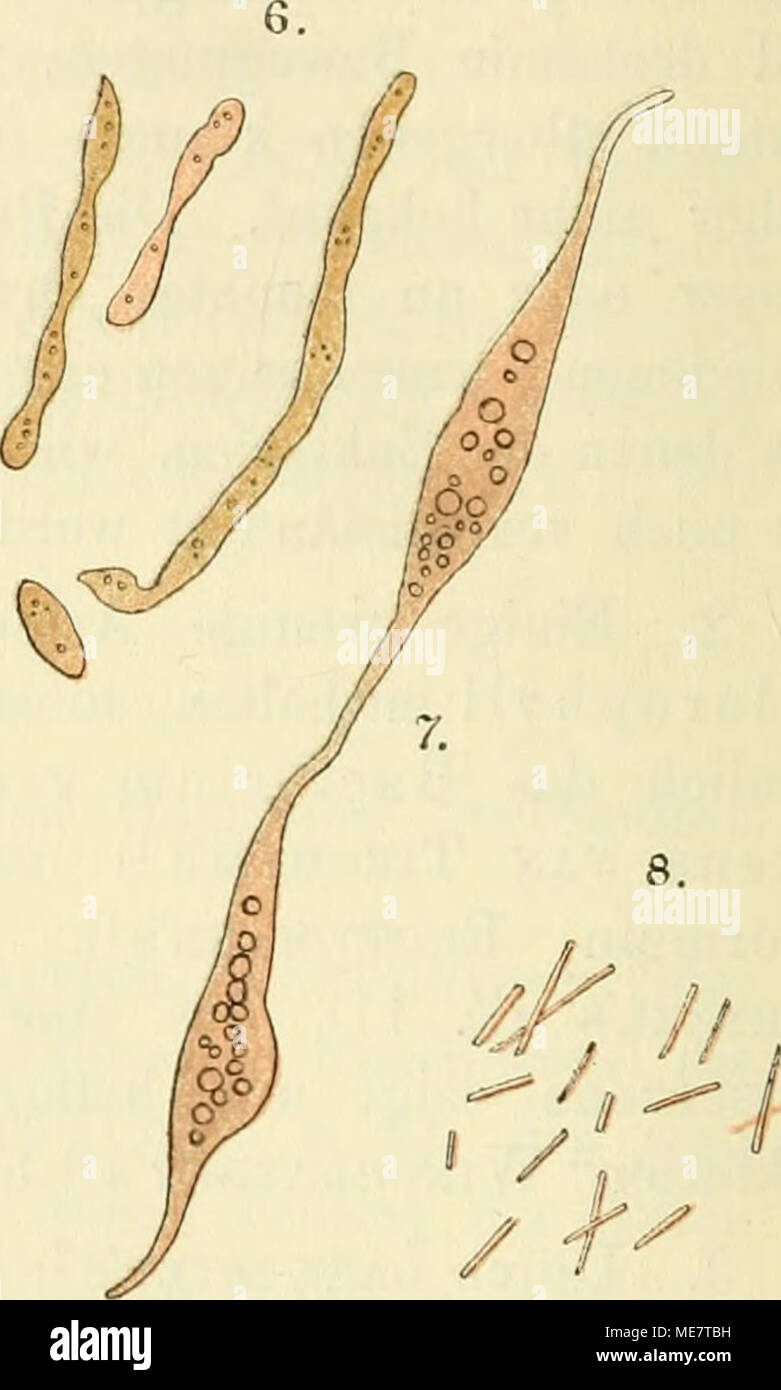 . Die mikroorganismen. Mit besonderer berücksichtigung der ätiologie der infektionskrankheiten . Einfluss auf die Purpurbakterien (Phototaxis). Ohne Sauerstoff zu leben vermögen die Purpurbakterien nicht, es genügen dazu aber ausserordentlich geringe Mengen, wie sie z. B. im Lichte von den „grünen Bakterien", die in ihrer Gemeinschaft selten fehlen, produziert werden; jeder Sauerstoffüberschuss wirkt schädlich. Ausser der Auf- deckung der physiologischen Verhältnisse dieser merkwürdigen Mikro- organismen gebührt Winogradsky das Verdienst, ihre Entwicklungs- geschichte gegenüber den ältere Stock Photohttps://www.alamy.com/image-license-details/?v=1https://www.alamy.com/die-mikroorganismen-mit-besonderer-bercksichtigung-der-tiologie-der-infektionskrankheiten-einfluss-auf-die-purpurbakterien-phototaxis-ohne-sauerstoff-zu-leben-vermgen-die-purpurbakterien-nicht-es-gengen-dazu-aber-ausserordentlich-geringe-mengen-wie-sie-z-b-im-lichte-von-den-grnen-bakterienquot-die-in-ihrer-gemeinschaft-selten-fehlen-produziert-werden-jeder-sauerstoffberschuss-wirkt-schdlich-ausser-der-auf-deckung-der-physiologischen-verhltnisse-dieser-merkwrdigen-mikro-organismen-gebhrt-winogradsky-das-verdienst-ihre-entwicklungs-geschichte-gegenber-den-ltere-image180881669.html
. Die mikroorganismen. Mit besonderer berücksichtigung der ätiologie der infektionskrankheiten . Einfluss auf die Purpurbakterien (Phototaxis). Ohne Sauerstoff zu leben vermögen die Purpurbakterien nicht, es genügen dazu aber ausserordentlich geringe Mengen, wie sie z. B. im Lichte von den „grünen Bakterien", die in ihrer Gemeinschaft selten fehlen, produziert werden; jeder Sauerstoffüberschuss wirkt schädlich. Ausser der Auf- deckung der physiologischen Verhältnisse dieser merkwürdigen Mikro- organismen gebührt Winogradsky das Verdienst, ihre Entwicklungs- geschichte gegenüber den ältere Stock Photohttps://www.alamy.com/image-license-details/?v=1https://www.alamy.com/die-mikroorganismen-mit-besonderer-bercksichtigung-der-tiologie-der-infektionskrankheiten-einfluss-auf-die-purpurbakterien-phototaxis-ohne-sauerstoff-zu-leben-vermgen-die-purpurbakterien-nicht-es-gengen-dazu-aber-ausserordentlich-geringe-mengen-wie-sie-z-b-im-lichte-von-den-grnen-bakterienquot-die-in-ihrer-gemeinschaft-selten-fehlen-produziert-werden-jeder-sauerstoffberschuss-wirkt-schdlich-ausser-der-auf-deckung-der-physiologischen-verhltnisse-dieser-merkwrdigen-mikro-organismen-gebhrt-winogradsky-das-verdienst-ihre-entwicklungs-geschichte-gegenber-den-ltere-image180881669.htmlRMME7TBH–. Die mikroorganismen. Mit besonderer berücksichtigung der ätiologie der infektionskrankheiten . Einfluss auf die Purpurbakterien (Phototaxis). Ohne Sauerstoff zu leben vermögen die Purpurbakterien nicht, es genügen dazu aber ausserordentlich geringe Mengen, wie sie z. B. im Lichte von den „grünen Bakterien", die in ihrer Gemeinschaft selten fehlen, produziert werden; jeder Sauerstoffüberschuss wirkt schädlich. Ausser der Auf- deckung der physiologischen Verhältnisse dieser merkwürdigen Mikro- organismen gebührt Winogradsky das Verdienst, ihre Entwicklungs- geschichte gegenüber den ältere
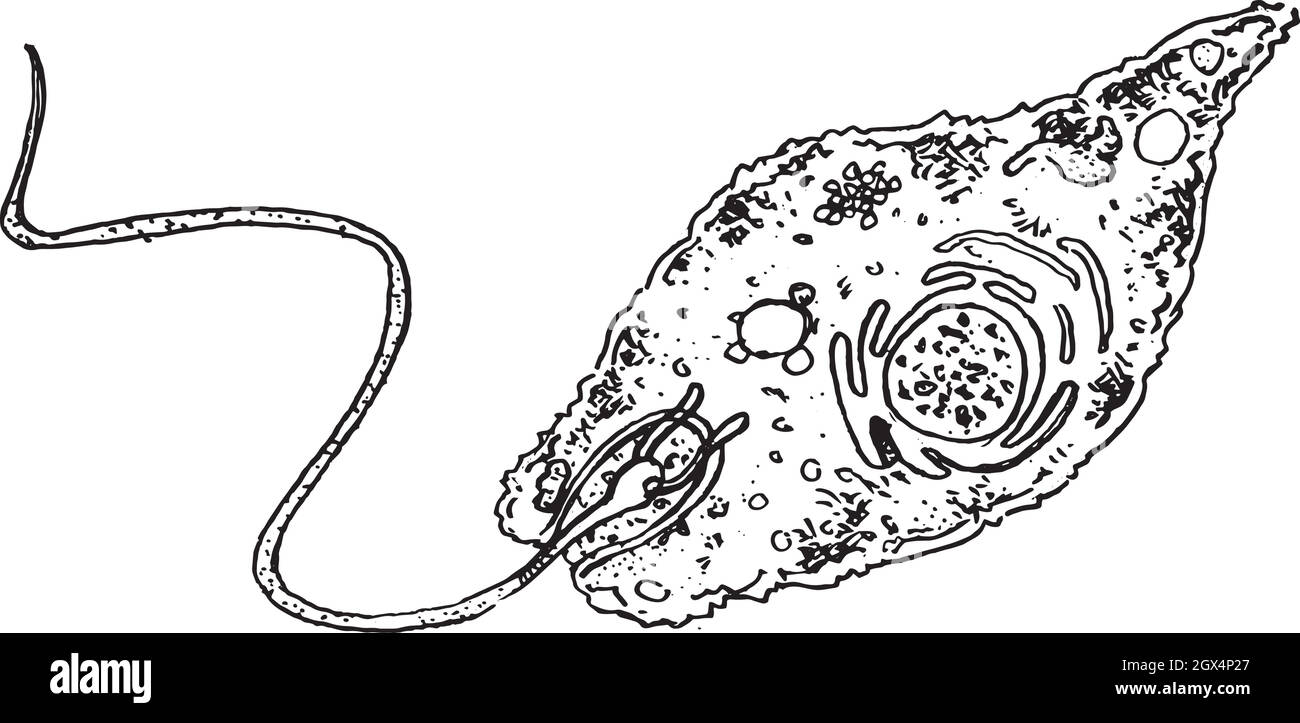 Euglena Stock Vectorhttps://www.alamy.com/image-license-details/?v=1https://www.alamy.com/euglena-image446345375.html
Euglena Stock Vectorhttps://www.alamy.com/image-license-details/?v=1https://www.alamy.com/euglena-image446345375.htmlRF2GX4P27–Euglena
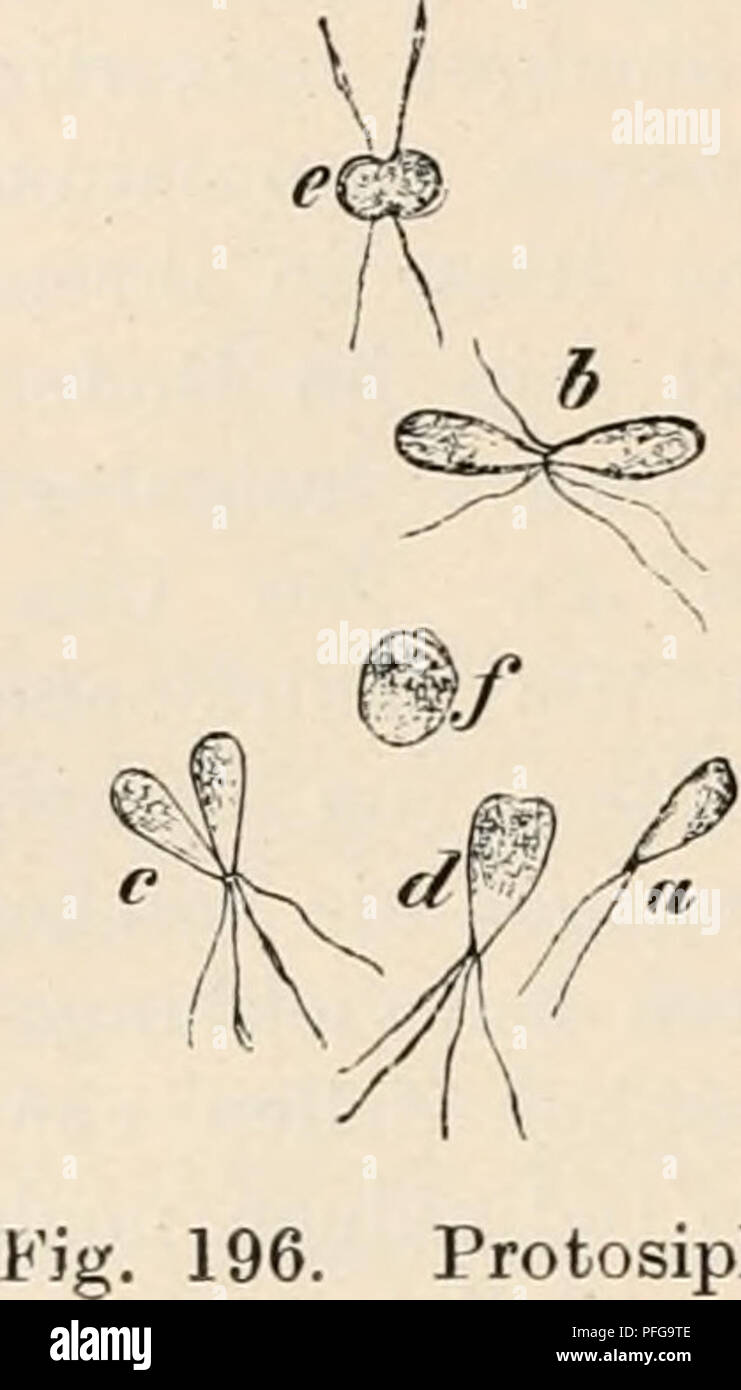 . Das botanische praktikum, anleitung zum selbststudium der mikroskopischen botanik für anfänger und geübtere, zugleich ein handbuch der mikroskopischen technik. Plant physiology; Botany; Microscopy. 486 XXII. Gameten von Protosiphon: Phototaxis, Photometrie, Kopulation. Tropfens an ^j, d. h. an dem Band, der dem Fenster zugekehrt ist. Drehen wir das Präparat um 180", so sehen wir alle Gameten sofort in gerader Rich- tung nach dem nunmehrigen Lichtrand des Tropfens hineilen. Diese Grameten sind somit positiv phototaktisch, denn sie werden in bestimmter Weise durch den Lichtstrahl gerichte Stock Photohttps://www.alamy.com/image-license-details/?v=1https://www.alamy.com/das-botanische-praktikum-anleitung-zum-selbststudium-der-mikroskopischen-botanik-fr-anfnger-und-gebtere-zugleich-ein-handbuch-der-mikroskopischen-technik-plant-physiology-botany-microscopy-486-xxii-gameten-von-protosiphon-phototaxis-photometrie-kopulation-tropfens-an-j-d-h-an-dem-band-der-dem-fenster-zugekehrt-ist-drehen-wir-das-prparat-um-180quot-so-sehen-wir-alle-gameten-sofort-in-gerader-rich-tung-nach-dem-nunmehrigen-lichtrand-des-tropfens-hineilen-diese-grameten-sind-somit-positiv-phototaktisch-denn-sie-werden-in-bestimmter-weise-durch-den-lichtstrahl-gerichte-image216103230.html
. Das botanische praktikum, anleitung zum selbststudium der mikroskopischen botanik für anfänger und geübtere, zugleich ein handbuch der mikroskopischen technik. Plant physiology; Botany; Microscopy. 486 XXII. Gameten von Protosiphon: Phototaxis, Photometrie, Kopulation. Tropfens an ^j, d. h. an dem Band, der dem Fenster zugekehrt ist. Drehen wir das Präparat um 180", so sehen wir alle Gameten sofort in gerader Rich- tung nach dem nunmehrigen Lichtrand des Tropfens hineilen. Diese Grameten sind somit positiv phototaktisch, denn sie werden in bestimmter Weise durch den Lichtstrahl gerichte Stock Photohttps://www.alamy.com/image-license-details/?v=1https://www.alamy.com/das-botanische-praktikum-anleitung-zum-selbststudium-der-mikroskopischen-botanik-fr-anfnger-und-gebtere-zugleich-ein-handbuch-der-mikroskopischen-technik-plant-physiology-botany-microscopy-486-xxii-gameten-von-protosiphon-phototaxis-photometrie-kopulation-tropfens-an-j-d-h-an-dem-band-der-dem-fenster-zugekehrt-ist-drehen-wir-das-prparat-um-180quot-so-sehen-wir-alle-gameten-sofort-in-gerader-rich-tung-nach-dem-nunmehrigen-lichtrand-des-tropfens-hineilen-diese-grameten-sind-somit-positiv-phototaktisch-denn-sie-werden-in-bestimmter-weise-durch-den-lichtstrahl-gerichte-image216103230.htmlRMPFG9TE–. Das botanische praktikum, anleitung zum selbststudium der mikroskopischen botanik für anfänger und geübtere, zugleich ein handbuch der mikroskopischen technik. Plant physiology; Botany; Microscopy. 486 XXII. Gameten von Protosiphon: Phototaxis, Photometrie, Kopulation. Tropfens an ^j, d. h. an dem Band, der dem Fenster zugekehrt ist. Drehen wir das Präparat um 180", so sehen wir alle Gameten sofort in gerader Rich- tung nach dem nunmehrigen Lichtrand des Tropfens hineilen. Diese Grameten sind somit positiv phototaktisch, denn sie werden in bestimmter Weise durch den Lichtstrahl gerichte
 Archive image from page 513 of Das botanische praktikum, anleitung zum. Das botanische praktikum, anleitung zum selbststudium der mikroskopischen botanik für anfänger und geübtere, zugleich ein handbuch der mikroskopischen technik dasbotanischepra00stra Year: 1923 486 XXII. Gameten von Protosiphon: Phototaxis, Photometrie, Kopulation. Tropfens an j, d. h. an dem Band, der dem Fenster zugekehrt ist. Drehen wir das Präparat um 180', so sehen wir alle Gameten sofort in gerader Rich- tung nach dem nunmehrigen Lichtrand des Tropfens hineilen. Diese Grameten sind somit positiv phototaktisch, denn s Stock Photohttps://www.alamy.com/image-license-details/?v=1https://www.alamy.com/archive-image-from-page-513-of-das-botanische-praktikum-anleitung-zum-das-botanische-praktikum-anleitung-zum-selbststudium-der-mikroskopischen-botanik-fr-anfnger-und-gebtere-zugleich-ein-handbuch-der-mikroskopischen-technik-dasbotanischepra00stra-year-1923-486-xxii-gameten-von-protosiphon-phototaxis-photometrie-kopulation-tropfens-an-j-d-h-an-dem-band-der-dem-fenster-zugekehrt-ist-drehen-wir-das-prparat-um-180-so-sehen-wir-alle-gameten-sofort-in-gerader-rich-tung-nach-dem-nunmehrigen-lichtrand-des-tropfens-hineilen-diese-grameten-sind-somit-positiv-phototaktisch-denn-s-image259316699.html
Archive image from page 513 of Das botanische praktikum, anleitung zum. Das botanische praktikum, anleitung zum selbststudium der mikroskopischen botanik für anfänger und geübtere, zugleich ein handbuch der mikroskopischen technik dasbotanischepra00stra Year: 1923 486 XXII. Gameten von Protosiphon: Phototaxis, Photometrie, Kopulation. Tropfens an j, d. h. an dem Band, der dem Fenster zugekehrt ist. Drehen wir das Präparat um 180', so sehen wir alle Gameten sofort in gerader Rich- tung nach dem nunmehrigen Lichtrand des Tropfens hineilen. Diese Grameten sind somit positiv phototaktisch, denn s Stock Photohttps://www.alamy.com/image-license-details/?v=1https://www.alamy.com/archive-image-from-page-513-of-das-botanische-praktikum-anleitung-zum-das-botanische-praktikum-anleitung-zum-selbststudium-der-mikroskopischen-botanik-fr-anfnger-und-gebtere-zugleich-ein-handbuch-der-mikroskopischen-technik-dasbotanischepra00stra-year-1923-486-xxii-gameten-von-protosiphon-phototaxis-photometrie-kopulation-tropfens-an-j-d-h-an-dem-band-der-dem-fenster-zugekehrt-ist-drehen-wir-das-prparat-um-180-so-sehen-wir-alle-gameten-sofort-in-gerader-rich-tung-nach-dem-nunmehrigen-lichtrand-des-tropfens-hineilen-diese-grameten-sind-somit-positiv-phototaktisch-denn-s-image259316699.htmlRMW1TW2K–Archive image from page 513 of Das botanische praktikum, anleitung zum. Das botanische praktikum, anleitung zum selbststudium der mikroskopischen botanik für anfänger und geübtere, zugleich ein handbuch der mikroskopischen technik dasbotanischepra00stra Year: 1923 486 XXII. Gameten von Protosiphon: Phototaxis, Photometrie, Kopulation. Tropfens an j, d. h. an dem Band, der dem Fenster zugekehrt ist. Drehen wir das Präparat um 180', so sehen wir alle Gameten sofort in gerader Rich- tung nach dem nunmehrigen Lichtrand des Tropfens hineilen. Diese Grameten sind somit positiv phototaktisch, denn s
RMDH990D–3D chamber for tracking swimming of individual cell organisms via phototaxis, in biofuel energy & ecological research
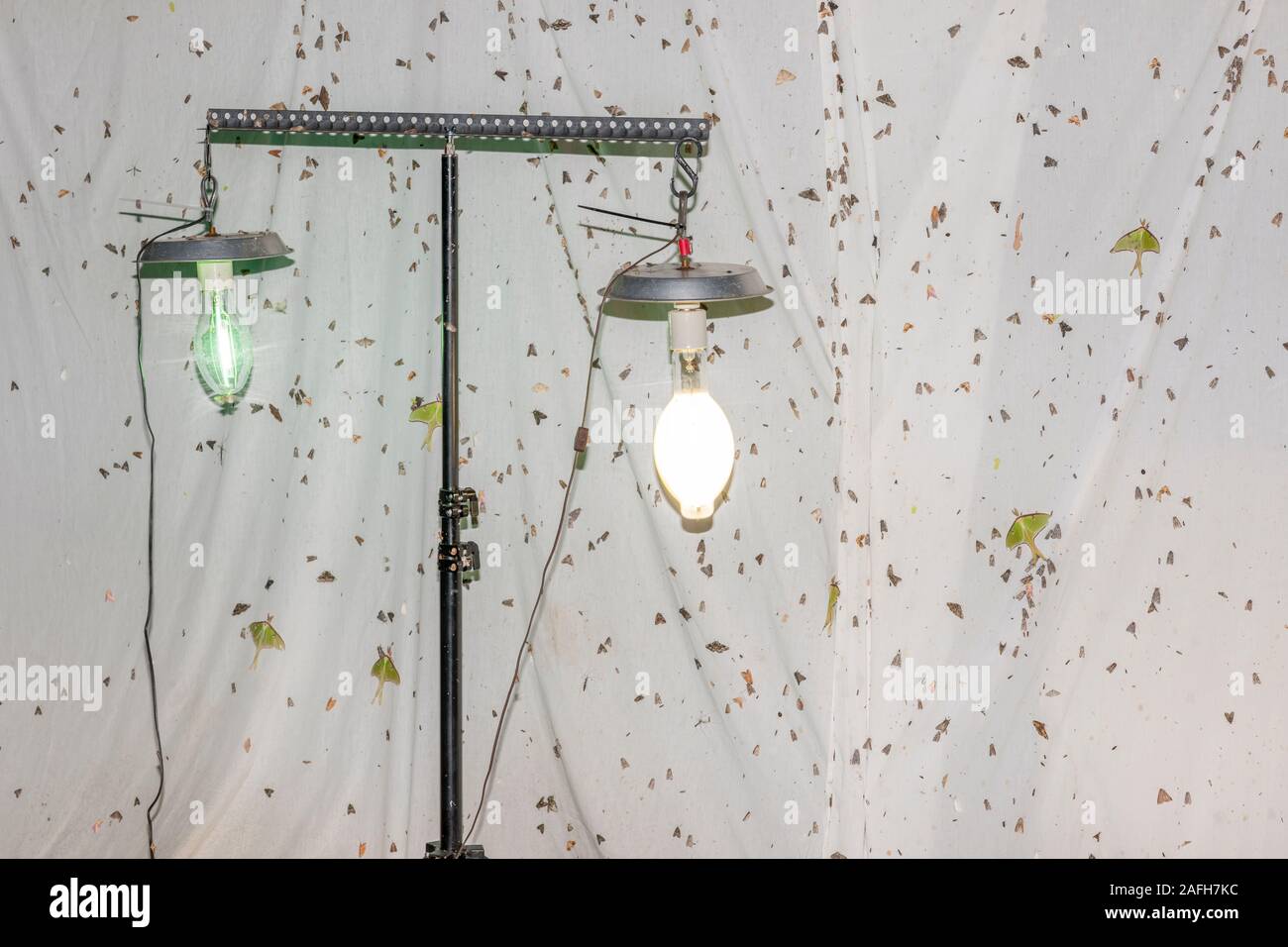 Diversity of moths, including many Luna moths cover sheet after spring nightlighting in northern Dauphin County, Pennsylvania. Genera represented incl Stock Photohttps://www.alamy.com/image-license-details/?v=1https://www.alamy.com/diversity-of-moths-including-many-luna-moths-cover-sheet-after-spring-nightlighting-in-northern-dauphin-county-pennsylvania-genera-represented-incl-image336596048.html
Diversity of moths, including many Luna moths cover sheet after spring nightlighting in northern Dauphin County, Pennsylvania. Genera represented incl Stock Photohttps://www.alamy.com/image-license-details/?v=1https://www.alamy.com/diversity-of-moths-including-many-luna-moths-cover-sheet-after-spring-nightlighting-in-northern-dauphin-county-pennsylvania-genera-represented-incl-image336596048.htmlRM2AFH7KC–Diversity of moths, including many Luna moths cover sheet after spring nightlighting in northern Dauphin County, Pennsylvania. Genera represented incl
 butterfly on plant with some parts in focus Stock Photohttps://www.alamy.com/image-license-details/?v=1https://www.alamy.com/butterfly-on-plant-with-some-parts-in-focus-image362118051.html
butterfly on plant with some parts in focus Stock Photohttps://www.alamy.com/image-license-details/?v=1https://www.alamy.com/butterfly-on-plant-with-some-parts-in-focus-image362118051.htmlRF2C13W7F–butterfly on plant with some parts in focus
 Mayfly are flying, playing around the fluorescent lights. Stock Photohttps://www.alamy.com/image-license-details/?v=1https://www.alamy.com/mayfly-are-flying-playing-around-the-fluorescent-lights-image359104372.html
Mayfly are flying, playing around the fluorescent lights. Stock Photohttps://www.alamy.com/image-license-details/?v=1https://www.alamy.com/mayfly-are-flying-playing-around-the-fluorescent-lights-image359104372.htmlRF2BT6H84–Mayfly are flying, playing around the fluorescent lights.
 Annual report of the Commissioners of Inland Fisheries made to the General Assembly . F/G. 5. Platk XXXIX.—Showing the effect produced when opportunity is given for both rheotactic andphototactic responses. Phototaxis is dominant. REPORT OF COMMISSIONERS OF INLAND FISHERIES. 251 II. The Influence of Light on the Rate of Development. Insomuch as the writer has treated this subject in more detail inanother paper* the present consideration will be brief. The questionof the influence of light upon the rate of growth is, however, one ofno little importance to the general problems of the artificial Stock Photohttps://www.alamy.com/image-license-details/?v=1https://www.alamy.com/annual-report-of-the-commissioners-of-inland-fisheries-made-to-the-general-assembly-fg-5-platk-xxxixshowing-the-effect-produced-when-opportunity-is-given-for-both-rheotactic-andphototactic-responses-phototaxis-is-dominant-report-of-commissioners-of-inland-fisheries-251-ii-the-influence-of-light-on-the-rate-of-development-insomuch-as-the-writer-has-treated-this-subject-in-more-detail-inanother-paper-the-present-consideration-will-be-brief-the-questionof-the-influence-of-light-upon-the-rate-of-growth-is-however-one-ofno-little-importance-to-the-general-problems-of-the-artificial-image338334251.html
Annual report of the Commissioners of Inland Fisheries made to the General Assembly . F/G. 5. Platk XXXIX.—Showing the effect produced when opportunity is given for both rheotactic andphototactic responses. Phototaxis is dominant. REPORT OF COMMISSIONERS OF INLAND FISHERIES. 251 II. The Influence of Light on the Rate of Development. Insomuch as the writer has treated this subject in more detail inanother paper* the present consideration will be brief. The questionof the influence of light upon the rate of growth is, however, one ofno little importance to the general problems of the artificial Stock Photohttps://www.alamy.com/image-license-details/?v=1https://www.alamy.com/annual-report-of-the-commissioners-of-inland-fisheries-made-to-the-general-assembly-fg-5-platk-xxxixshowing-the-effect-produced-when-opportunity-is-given-for-both-rheotactic-andphototactic-responses-phototaxis-is-dominant-report-of-commissioners-of-inland-fisheries-251-ii-the-influence-of-light-on-the-rate-of-development-insomuch-as-the-writer-has-treated-this-subject-in-more-detail-inanother-paper-the-present-consideration-will-be-brief-the-questionof-the-influence-of-light-upon-the-rate-of-growth-is-however-one-ofno-little-importance-to-the-general-problems-of-the-artificial-image338334251.htmlRM2AJCCP3–Annual report of the Commissioners of Inland Fisheries made to the General Assembly . F/G. 5. Platk XXXIX.—Showing the effect produced when opportunity is given for both rheotactic andphototactic responses. Phototaxis is dominant. REPORT OF COMMISSIONERS OF INLAND FISHERIES. 251 II. The Influence of Light on the Rate of Development. Insomuch as the writer has treated this subject in more detail inanother paper* the present consideration will be brief. The questionof the influence of light upon the rate of growth is, however, one ofno little importance to the general problems of the artificial
 Elements of ecology (1954) Elements of ecology elementsofecolog00clar Year: 1954 214 Light displaying a negative geotaxis, a positive phototaxis, or both. Ex- periments can be devised that distinguish between the responses of which the animal is capable. An example of such an experiment is given in Fig. 6.16 in which the response of a negatively geotactic and a negatively phototactic Agriolimax is shown. When light is allowed to act at right angles to gravity, this lowly garden slug can resolve the forces with more alacrity than is displayed by some col- lege students! The first trial indicat Stock Photohttps://www.alamy.com/image-license-details/?v=1https://www.alamy.com/elements-of-ecology-1954-elements-of-ecology-elementsofecolog00clar-year-1954-214-light-displaying-a-negative-geotaxis-a-positive-phototaxis-or-both-ex-periments-can-be-devised-that-distinguish-between-the-responses-of-which-the-animal-is-capable-an-example-of-such-an-experiment-is-given-in-fig-616-in-which-the-response-of-a-negatively-geotactic-and-a-negatively-phototactic-agriolimax-is-shown-when-light-is-allowed-to-act-at-right-angles-to-gravity-this-lowly-garden-slug-can-resolve-the-forces-with-more-alacrity-than-is-displayed-by-some-col-lege-students!-the-first-trial-indicat-image239619500.html
Elements of ecology (1954) Elements of ecology elementsofecolog00clar Year: 1954 214 Light displaying a negative geotaxis, a positive phototaxis, or both. Ex- periments can be devised that distinguish between the responses of which the animal is capable. An example of such an experiment is given in Fig. 6.16 in which the response of a negatively geotactic and a negatively phototactic Agriolimax is shown. When light is allowed to act at right angles to gravity, this lowly garden slug can resolve the forces with more alacrity than is displayed by some col- lege students! The first trial indicat Stock Photohttps://www.alamy.com/image-license-details/?v=1https://www.alamy.com/elements-of-ecology-1954-elements-of-ecology-elementsofecolog00clar-year-1954-214-light-displaying-a-negative-geotaxis-a-positive-phototaxis-or-both-ex-periments-can-be-devised-that-distinguish-between-the-responses-of-which-the-animal-is-capable-an-example-of-such-an-experiment-is-given-in-fig-616-in-which-the-response-of-a-negatively-geotactic-and-a-negatively-phototactic-agriolimax-is-shown-when-light-is-allowed-to-act-at-right-angles-to-gravity-this-lowly-garden-slug-can-resolve-the-forces-with-more-alacrity-than-is-displayed-by-some-col-lege-students!-the-first-trial-indicat-image239619500.htmlRMRWRH38–Elements of ecology (1954) Elements of ecology elementsofecolog00clar Year: 1954 214 Light displaying a negative geotaxis, a positive phototaxis, or both. Ex- periments can be devised that distinguish between the responses of which the animal is capable. An example of such an experiment is given in Fig. 6.16 in which the response of a negatively geotactic and a negatively phototactic Agriolimax is shown. When light is allowed to act at right angles to gravity, this lowly garden slug can resolve the forces with more alacrity than is displayed by some col- lege students! The first trial indicat
RMDH8G23–Close up of inner chamber for tracking swimming of individual cell organisms such as algae in red light. Bio Fuel Energy and Ecology Research
 Imperial Moths (Eacles imperialis) Covering sheet in early AM after incredible night of nightlighting for moths in northern Dauphin County, Pennsylvan Stock Photohttps://www.alamy.com/image-license-details/?v=1https://www.alamy.com/imperial-moths-eacles-imperialis-covering-sheet-in-early-am-after-incredible-night-of-nightlighting-for-moths-in-northern-dauphin-county-pennsylvan-image336595841.html
Imperial Moths (Eacles imperialis) Covering sheet in early AM after incredible night of nightlighting for moths in northern Dauphin County, Pennsylvan Stock Photohttps://www.alamy.com/image-license-details/?v=1https://www.alamy.com/imperial-moths-eacles-imperialis-covering-sheet-in-early-am-after-incredible-night-of-nightlighting-for-moths-in-northern-dauphin-county-pennsylvan-image336595841.htmlRM2AFH7C1–Imperial Moths (Eacles imperialis) Covering sheet in early AM after incredible night of nightlighting for moths in northern Dauphin County, Pennsylvan
 General physiology; an outline of the science of life . ong axis parallel to thelight-rays, and in this position, by the extrusion of their secretion,move along the bottom in their peculiar manner toward thesource of light, or with greater intensity away from the source(Fig. 224). In a preparation containing living Closteria x or Pleuro-tamice all individuals place themselves with their long axis parallelto one another and to the direction of the incident light-rays.Thus, we find that among unicellular organisms, so far as they areirritable at all to light, phototaxis is a wide-spread phenomen Stock Photohttps://www.alamy.com/image-license-details/?v=1https://www.alamy.com/general-physiology-an-outline-of-the-science-of-life-ong-axis-parallel-to-thelight-rays-and-in-this-position-by-the-extrusion-of-their-secretionmove-along-the-bottom-in-their-peculiar-manner-toward-thesource-of-light-or-with-greater-intensity-away-from-the-sourcefig-224-in-a-preparation-containing-living-closteria-x-or-pleuro-tamice-all-individuals-place-themselves-with-their-long-axis-parallelto-one-another-and-to-the-direction-of-the-incident-light-raysthus-we-find-that-among-unicellular-organisms-so-far-as-they-areirritable-at-all-to-light-phototaxis-is-a-wide-spread-phenomen-image338492628.html
General physiology; an outline of the science of life . ong axis parallel to thelight-rays, and in this position, by the extrusion of their secretion,move along the bottom in their peculiar manner toward thesource of light, or with greater intensity away from the source(Fig. 224). In a preparation containing living Closteria x or Pleuro-tamice all individuals place themselves with their long axis parallelto one another and to the direction of the incident light-rays.Thus, we find that among unicellular organisms, so far as they areirritable at all to light, phototaxis is a wide-spread phenomen Stock Photohttps://www.alamy.com/image-license-details/?v=1https://www.alamy.com/general-physiology-an-outline-of-the-science-of-life-ong-axis-parallel-to-thelight-rays-and-in-this-position-by-the-extrusion-of-their-secretionmove-along-the-bottom-in-their-peculiar-manner-toward-thesource-of-light-or-with-greater-intensity-away-from-the-sourcefig-224-in-a-preparation-containing-living-closteria-x-or-pleuro-tamice-all-individuals-place-themselves-with-their-long-axis-parallelto-one-another-and-to-the-direction-of-the-incident-light-raysthus-we-find-that-among-unicellular-organisms-so-far-as-they-areirritable-at-all-to-light-phototaxis-is-a-wide-spread-phenomen-image338492628.htmlRM2AJKJPC–General physiology; an outline of the science of life . ong axis parallel to thelight-rays, and in this position, by the extrusion of their secretion,move along the bottom in their peculiar manner toward thesource of light, or with greater intensity away from the source(Fig. 224). In a preparation containing living Closteria x or Pleuro-tamice all individuals place themselves with their long axis parallelto one another and to the direction of the incident light-rays.Thus, we find that among unicellular organisms, so far as they areirritable at all to light, phototaxis is a wide-spread phenomen
RMDH8FYG–Air bubbles in chamber used for tracking the swimming of individual organisms in red light in biofuel energy & ecology research
 Large number of Luna Moths on sheet during a spring mercury vapor night lighting session near Congaree River, South Carolina. Also note the Cecropia M Stock Photohttps://www.alamy.com/image-license-details/?v=1https://www.alamy.com/large-number-of-luna-moths-on-sheet-during-a-spring-mercury-vapor-night-lighting-session-near-congaree-river-south-carolina-also-note-the-cecropia-m-image336595916.html
Large number of Luna Moths on sheet during a spring mercury vapor night lighting session near Congaree River, South Carolina. Also note the Cecropia M Stock Photohttps://www.alamy.com/image-license-details/?v=1https://www.alamy.com/large-number-of-luna-moths-on-sheet-during-a-spring-mercury-vapor-night-lighting-session-near-congaree-river-south-carolina-also-note-the-cecropia-m-image336595916.htmlRM2AFH7EM–Large number of Luna Moths on sheet during a spring mercury vapor night lighting session near Congaree River, South Carolina. Also note the Cecropia M
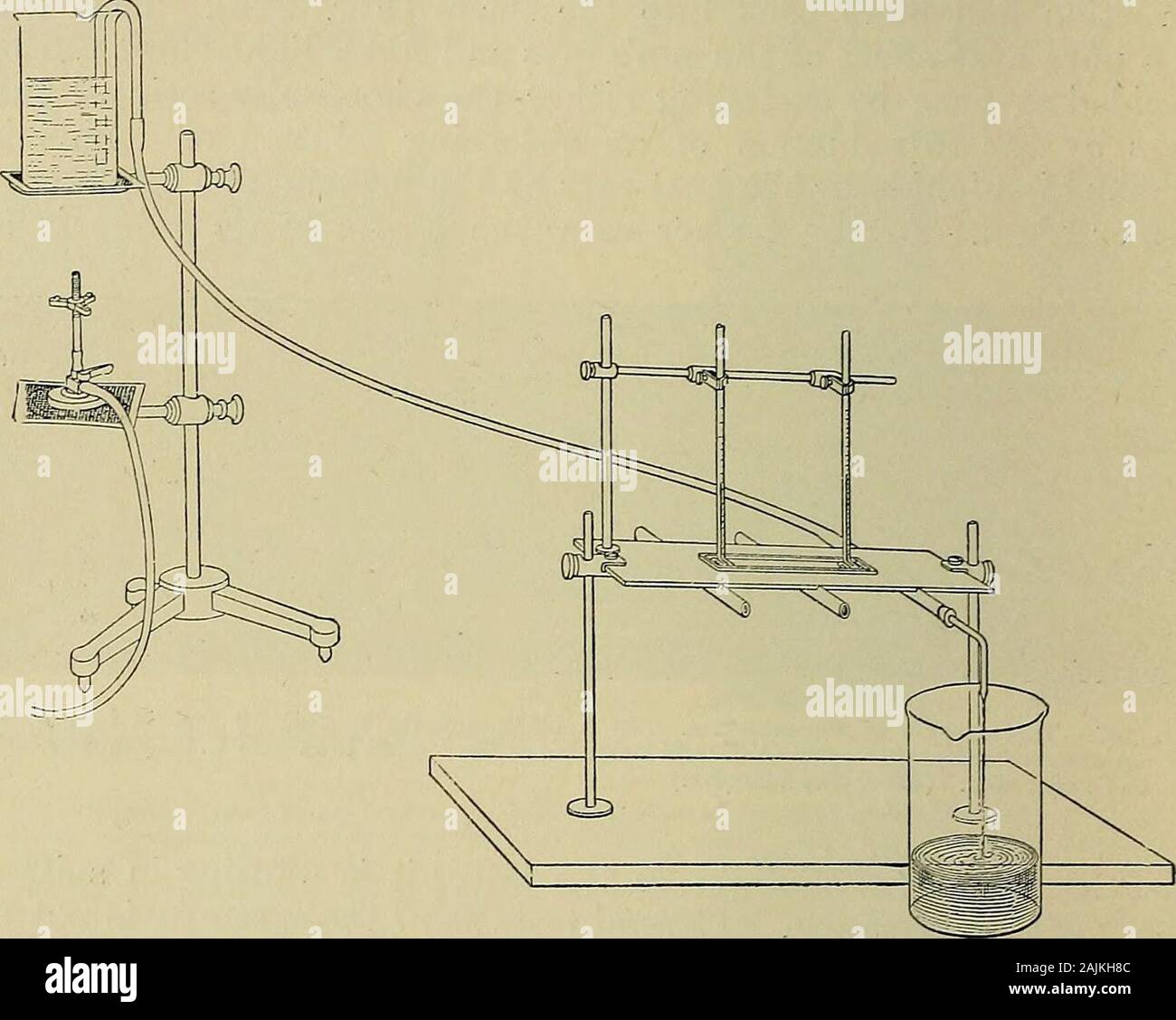 General physiology; an outline of the science of life . r Mendelssohn (95), allows heating or cooling with hot or coldwater (Fig. 228). With this it is shown that Paramcecia attemperatures of more than 24° C. to 28° C. are negatively thermo- 454 GENERAL PHYSIOLOGY tactic, i.e., swim in crowds away from the warmer side, while withtemperatures below this limit they show positive thermotaxis, sincethey leave the cooler side. There is here a phenomenon com-pletely analogous to chemotaxis and phototaxis, in which theorganisms likewise turn from both sides toward a certain degree ofintensity of the Stock Photohttps://www.alamy.com/image-license-details/?v=1https://www.alamy.com/general-physiology-an-outline-of-the-science-of-life-r-mendelssohn-95-allows-heating-or-cooling-with-hot-or-coldwater-fig-228-with-this-it-is-shown-that-paramcecia-attemperatures-of-more-than-24-c-to-28-c-are-negatively-thermo-454-general-physiology-tactic-ie-swim-in-crowds-away-from-the-warmer-side-while-withtemperatures-below-this-limit-they-show-positive-thermotaxis-sincethey-leave-the-cooler-side-there-is-here-a-phenomenon-com-pletely-analogous-to-chemotaxis-and-phototaxis-in-which-theorganisms-likewise-turn-from-both-sides-toward-a-certain-degree-ofintensity-of-the-image338491452.html
General physiology; an outline of the science of life . r Mendelssohn (95), allows heating or cooling with hot or coldwater (Fig. 228). With this it is shown that Paramcecia attemperatures of more than 24° C. to 28° C. are negatively thermo- 454 GENERAL PHYSIOLOGY tactic, i.e., swim in crowds away from the warmer side, while withtemperatures below this limit they show positive thermotaxis, sincethey leave the cooler side. There is here a phenomenon com-pletely analogous to chemotaxis and phototaxis, in which theorganisms likewise turn from both sides toward a certain degree ofintensity of the Stock Photohttps://www.alamy.com/image-license-details/?v=1https://www.alamy.com/general-physiology-an-outline-of-the-science-of-life-r-mendelssohn-95-allows-heating-or-cooling-with-hot-or-coldwater-fig-228-with-this-it-is-shown-that-paramcecia-attemperatures-of-more-than-24-c-to-28-c-are-negatively-thermo-454-general-physiology-tactic-ie-swim-in-crowds-away-from-the-warmer-side-while-withtemperatures-below-this-limit-they-show-positive-thermotaxis-sincethey-leave-the-cooler-side-there-is-here-a-phenomenon-com-pletely-analogous-to-chemotaxis-and-phototaxis-in-which-theorganisms-likewise-turn-from-both-sides-toward-a-certain-degree-ofintensity-of-the-image338491452.htmlRM2AJKH8C–General physiology; an outline of the science of life . r Mendelssohn (95), allows heating or cooling with hot or coldwater (Fig. 228). With this it is shown that Paramcecia attemperatures of more than 24° C. to 28° C. are negatively thermo- 454 GENERAL PHYSIOLOGY tactic, i.e., swim in crowds away from the warmer side, while withtemperatures below this limit they show positive thermotaxis, sincethey leave the cooler side. There is here a phenomenon com-pletely analogous to chemotaxis and phototaxis, in which theorganisms likewise turn from both sides toward a certain degree ofintensity of the
RMDH8G11–Scientist and 3D chamber for tracking swimming of individual cell organisms via phototaxis in biofuel energy & ecology research
 Large number of Luna Moths on sheet during a spring mercury vapor night lighting session near Congaree River, South Carolina. Also note the Cecropia M Stock Photohttps://www.alamy.com/image-license-details/?v=1https://www.alamy.com/large-number-of-luna-moths-on-sheet-during-a-spring-mercury-vapor-night-lighting-session-near-congaree-river-south-carolina-also-note-the-cecropia-m-image336595919.html
Large number of Luna Moths on sheet during a spring mercury vapor night lighting session near Congaree River, South Carolina. Also note the Cecropia M Stock Photohttps://www.alamy.com/image-license-details/?v=1https://www.alamy.com/large-number-of-luna-moths-on-sheet-during-a-spring-mercury-vapor-night-lighting-session-near-congaree-river-south-carolina-also-note-the-cecropia-m-image336595919.htmlRM2AFH7ER–Large number of Luna Moths on sheet during a spring mercury vapor night lighting session near Congaree River, South Carolina. Also note the Cecropia M
 . The Biological bulletin. Biology; Zoology; Biology; Marine Biology. PHOTIC REGULATION IN GYRODINIUM 155 III. The action spectrum of the stop-response If the stop-response is indeed the result of the same photo-machinery responsi- ble for the phototaxis, then both phenomena should have similar characteristics with respect to wavelength sensitivities. To test this, an action spectrum deter- mination was conducted on the stop-response and compared to that previously obtained for the phototactic response. The action spectrum for the stop-response was also obtained using a threshold determination Stock Photohttps://www.alamy.com/image-license-details/?v=1https://www.alamy.com/the-biological-bulletin-biology-zoology-biology-marine-biology-photic-regulation-in-gyrodinium-155-iii-the-action-spectrum-of-the-stop-response-if-the-stop-response-is-indeed-the-result-of-the-same-photo-machinery-responsi-ble-for-the-phototaxis-then-both-phenomena-should-have-similar-characteristics-with-respect-to-wavelength-sensitivities-to-test-this-an-action-spectrum-deter-mination-was-conducted-on-the-stop-response-and-compared-to-that-previously-obtained-for-the-phototactic-response-the-action-spectrum-for-the-stop-response-was-also-obtained-using-a-threshold-determination-image234663873.html
. The Biological bulletin. Biology; Zoology; Biology; Marine Biology. PHOTIC REGULATION IN GYRODINIUM 155 III. The action spectrum of the stop-response If the stop-response is indeed the result of the same photo-machinery responsi- ble for the phototaxis, then both phenomena should have similar characteristics with respect to wavelength sensitivities. To test this, an action spectrum deter- mination was conducted on the stop-response and compared to that previously obtained for the phototactic response. The action spectrum for the stop-response was also obtained using a threshold determination Stock Photohttps://www.alamy.com/image-license-details/?v=1https://www.alamy.com/the-biological-bulletin-biology-zoology-biology-marine-biology-photic-regulation-in-gyrodinium-155-iii-the-action-spectrum-of-the-stop-response-if-the-stop-response-is-indeed-the-result-of-the-same-photo-machinery-responsi-ble-for-the-phototaxis-then-both-phenomena-should-have-similar-characteristics-with-respect-to-wavelength-sensitivities-to-test-this-an-action-spectrum-deter-mination-was-conducted-on-the-stop-response-and-compared-to-that-previously-obtained-for-the-phototactic-response-the-action-spectrum-for-the-stop-response-was-also-obtained-using-a-threshold-determination-image234663873.htmlRMRHNT4H–. The Biological bulletin. Biology; Zoology; Biology; Marine Biology. PHOTIC REGULATION IN GYRODINIUM 155 III. The action spectrum of the stop-response If the stop-response is indeed the result of the same photo-machinery responsi- ble for the phototaxis, then both phenomena should have similar characteristics with respect to wavelength sensitivities. To test this, an action spectrum deter- mination was conducted on the stop-response and compared to that previously obtained for the phototactic response. The action spectrum for the stop-response was also obtained using a threshold determination
RMDH98MW–Scientist and 3D chamber for tracking swimming of individual cell organisms via phototaxis in biofuel energy & ecology research
 Diversity of moths cover sheet after spring nightlighting in northern Dauphin County, Pennsylvania. Genera represented include Acronicta, Deprana, Cha Stock Photohttps://www.alamy.com/image-license-details/?v=1https://www.alamy.com/diversity-of-moths-cover-sheet-after-spring-nightlighting-in-northern-dauphin-county-pennsylvania-genera-represented-include-acronicta-deprana-cha-image336595999.html
Diversity of moths cover sheet after spring nightlighting in northern Dauphin County, Pennsylvania. Genera represented include Acronicta, Deprana, Cha Stock Photohttps://www.alamy.com/image-license-details/?v=1https://www.alamy.com/diversity-of-moths-cover-sheet-after-spring-nightlighting-in-northern-dauphin-county-pennsylvania-genera-represented-include-acronicta-deprana-cha-image336595999.htmlRM2AFH7HK–Diversity of moths cover sheet after spring nightlighting in northern Dauphin County, Pennsylvania. Genera represented include Acronicta, Deprana, Cha
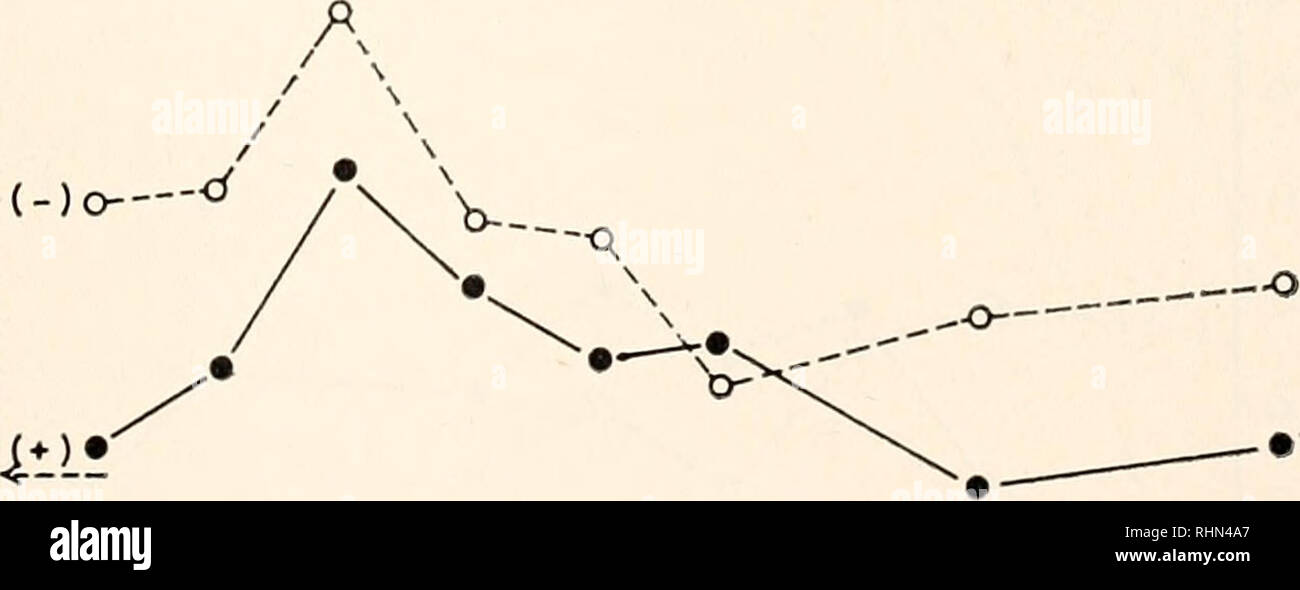 . The Biological bulletin. Biology; Zoology; Biology; Marine Biology. PHOTOTAXIS OF UNIONICOLA 601 ent) were stimulated for 60 sec, while those tested under conditions eliciting negative phototaxis (host homogenate present) were exposed to the light for 90 sec, since negative phototaxis took longer to be expressed. At the end of each test the partitions were reinserted and the number of mites in each section was recorded. Two series of experiments were conducted. Spectral sensitivity was established for light- and dark-adapted mites by determining phototactic responsiveness upon stimulation wi Stock Photohttps://www.alamy.com/image-license-details/?v=1https://www.alamy.com/the-biological-bulletin-biology-zoology-biology-marine-biology-phototaxis-of-unionicola-601-ent-were-stimulated-for-60-sec-while-those-tested-under-conditions-eliciting-negative-phototaxis-host-homogenate-present-were-exposed-to-the-light-for-90-sec-since-negative-phototaxis-took-longer-to-be-expressed-at-the-end-of-each-test-the-partitions-were-reinserted-and-the-number-of-mites-in-each-section-was-recorded-two-series-of-experiments-were-conducted-spectral-sensitivity-was-established-for-light-and-dark-adapted-mites-by-determining-phototactic-responsiveness-upon-stimulation-wi-image234648351.html
. The Biological bulletin. Biology; Zoology; Biology; Marine Biology. PHOTOTAXIS OF UNIONICOLA 601 ent) were stimulated for 60 sec, while those tested under conditions eliciting negative phototaxis (host homogenate present) were exposed to the light for 90 sec, since negative phototaxis took longer to be expressed. At the end of each test the partitions were reinserted and the number of mites in each section was recorded. Two series of experiments were conducted. Spectral sensitivity was established for light- and dark-adapted mites by determining phototactic responsiveness upon stimulation wi Stock Photohttps://www.alamy.com/image-license-details/?v=1https://www.alamy.com/the-biological-bulletin-biology-zoology-biology-marine-biology-phototaxis-of-unionicola-601-ent-were-stimulated-for-60-sec-while-those-tested-under-conditions-eliciting-negative-phototaxis-host-homogenate-present-were-exposed-to-the-light-for-90-sec-since-negative-phototaxis-took-longer-to-be-expressed-at-the-end-of-each-test-the-partitions-were-reinserted-and-the-number-of-mites-in-each-section-was-recorded-two-series-of-experiments-were-conducted-spectral-sensitivity-was-established-for-light-and-dark-adapted-mites-by-determining-phototactic-responsiveness-upon-stimulation-wi-image234648351.htmlRMRHN4A7–. The Biological bulletin. Biology; Zoology; Biology; Marine Biology. PHOTOTAXIS OF UNIONICOLA 601 ent) were stimulated for 60 sec, while those tested under conditions eliciting negative phototaxis (host homogenate present) were exposed to the light for 90 sec, since negative phototaxis took longer to be expressed. At the end of each test the partitions were reinserted and the number of mites in each section was recorded. Two series of experiments were conducted. Spectral sensitivity was established for light- and dark-adapted mites by determining phototactic responsiveness upon stimulation wi
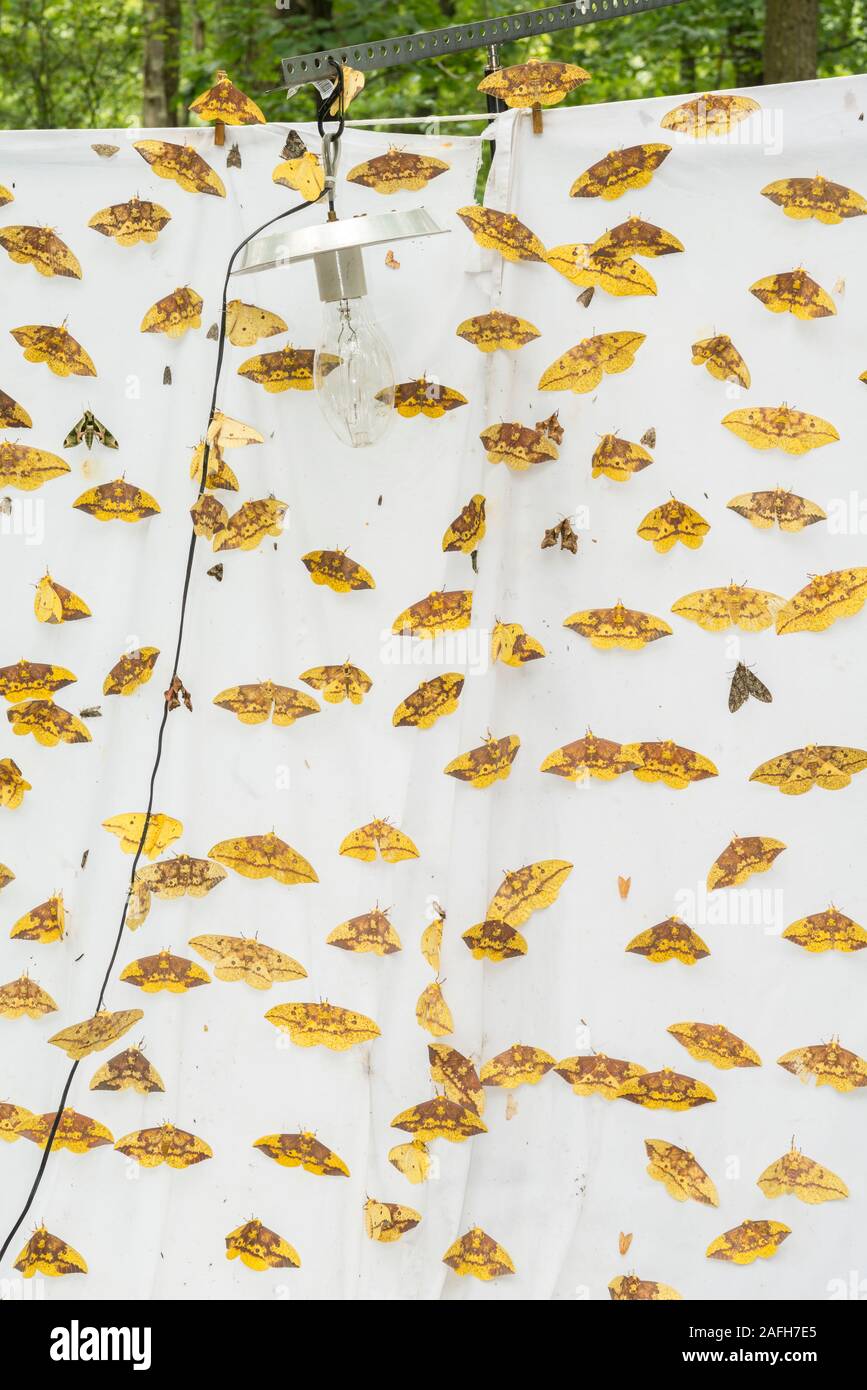 Imperial Moths (Eacles imperialis) Covering sheet in early AM after incredible night of nightlighting for moths in northern Dauphin County, Pennsylvan Stock Photohttps://www.alamy.com/image-license-details/?v=1https://www.alamy.com/imperial-moths-eacles-imperialis-covering-sheet-in-early-am-after-incredible-night-of-nightlighting-for-moths-in-northern-dauphin-county-pennsylvan-image336595901.html
Imperial Moths (Eacles imperialis) Covering sheet in early AM after incredible night of nightlighting for moths in northern Dauphin County, Pennsylvan Stock Photohttps://www.alamy.com/image-license-details/?v=1https://www.alamy.com/imperial-moths-eacles-imperialis-covering-sheet-in-early-am-after-incredible-night-of-nightlighting-for-moths-in-northern-dauphin-county-pennsylvan-image336595901.htmlRM2AFH7E5–Imperial Moths (Eacles imperialis) Covering sheet in early AM after incredible night of nightlighting for moths in northern Dauphin County, Pennsylvan
 . Annotationes zoologicae japonenses / Nihon do?butsugaku iho?. NEGATIVE PHOTOTAXIS ETC. OF Littori na. 5 Thus the half of the plate tamed toward the land which appeared naturally darker on account of bushes, grasses etc, had nearly three times as many individuals as the half turned toward the sea. When it is recollected that the sun was at the time shining from the zenith, the reaction must be considered as very decided. It was evident that whether these molluscs have other means or not, the property of negative phototaxis alone must induce them to crawl landward and to make them behave as if Stock Photohttps://www.alamy.com/image-license-details/?v=1https://www.alamy.com/annotationes-zoologicae-japonenses-nihon-dobutsugaku-iho-negative-phototaxis-etc-of-littori-na-5-thus-the-half-of-the-plate-tamed-toward-the-land-which-appeared-naturally-darker-on-account-of-bushes-grasses-etc-had-nearly-three-times-as-many-individuals-as-the-half-turned-toward-the-sea-when-it-is-recollected-that-the-sun-was-at-the-time-shining-from-the-zenith-the-reaction-must-be-considered-as-very-decided-it-was-evident-that-whether-these-molluscs-have-other-means-or-not-the-property-of-negative-phototaxis-alone-must-induce-them-to-crawl-landward-and-to-make-them-behave-as-if-image236393256.html
. Annotationes zoologicae japonenses / Nihon do?butsugaku iho?. NEGATIVE PHOTOTAXIS ETC. OF Littori na. 5 Thus the half of the plate tamed toward the land which appeared naturally darker on account of bushes, grasses etc, had nearly three times as many individuals as the half turned toward the sea. When it is recollected that the sun was at the time shining from the zenith, the reaction must be considered as very decided. It was evident that whether these molluscs have other means or not, the property of negative phototaxis alone must induce them to crawl landward and to make them behave as if Stock Photohttps://www.alamy.com/image-license-details/?v=1https://www.alamy.com/annotationes-zoologicae-japonenses-nihon-dobutsugaku-iho-negative-phototaxis-etc-of-littori-na-5-thus-the-half-of-the-plate-tamed-toward-the-land-which-appeared-naturally-darker-on-account-of-bushes-grasses-etc-had-nearly-three-times-as-many-individuals-as-the-half-turned-toward-the-sea-when-it-is-recollected-that-the-sun-was-at-the-time-shining-from-the-zenith-the-reaction-must-be-considered-as-very-decided-it-was-evident-that-whether-these-molluscs-have-other-means-or-not-the-property-of-negative-phototaxis-alone-must-induce-them-to-crawl-landward-and-to-make-them-behave-as-if-image236393256.htmlRMRMGJ08–. Annotationes zoologicae japonenses / Nihon do?butsugaku iho?. NEGATIVE PHOTOTAXIS ETC. OF Littori na. 5 Thus the half of the plate tamed toward the land which appeared naturally darker on account of bushes, grasses etc, had nearly three times as many individuals as the half turned toward the sea. When it is recollected that the sun was at the time shining from the zenith, the reaction must be considered as very decided. It was evident that whether these molluscs have other means or not, the property of negative phototaxis alone must induce them to crawl landward and to make them behave as if
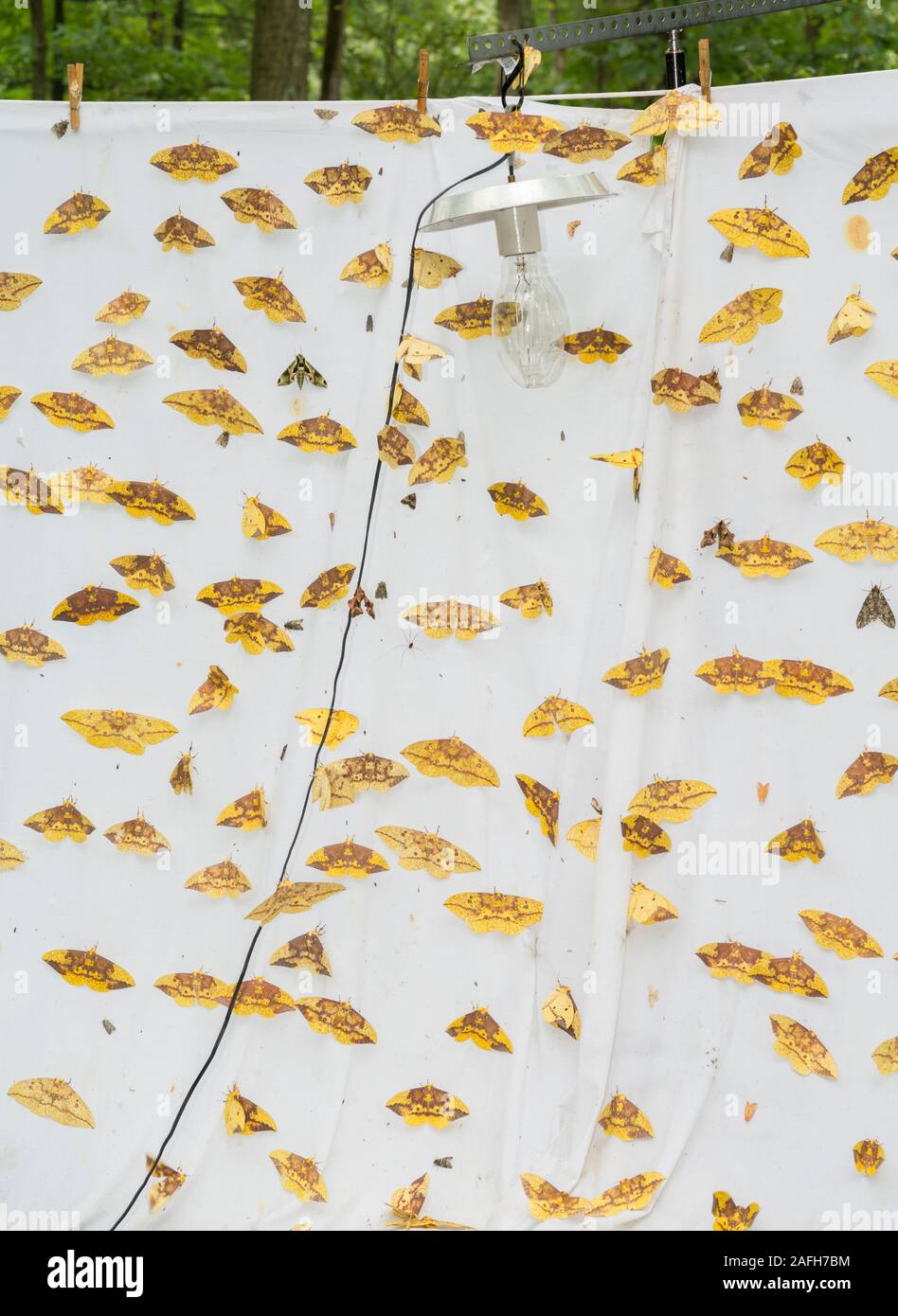 Imperial Moths (Eacles imperialis) Covering sheet in early AM after incredible night of nightlighting for moths in northern Dauphin County, Pennsylvan Stock Photohttps://www.alamy.com/image-license-details/?v=1https://www.alamy.com/imperial-moths-eacles-imperialis-covering-sheet-in-early-am-after-incredible-night-of-nightlighting-for-moths-in-northern-dauphin-county-pennsylvan-image336595832.html
Imperial Moths (Eacles imperialis) Covering sheet in early AM after incredible night of nightlighting for moths in northern Dauphin County, Pennsylvan Stock Photohttps://www.alamy.com/image-license-details/?v=1https://www.alamy.com/imperial-moths-eacles-imperialis-covering-sheet-in-early-am-after-incredible-night-of-nightlighting-for-moths-in-northern-dauphin-county-pennsylvan-image336595832.htmlRM2AFH7BM–Imperial Moths (Eacles imperialis) Covering sheet in early AM after incredible night of nightlighting for moths in northern Dauphin County, Pennsylvan
![. Experimental morphology. Protoplasm; Growth. §4] PHOTOTAXIS AND PHOTOPATHY 193 we find this capacity for rearrangement of pigment granules, as ExNKR ('89 and '91, p. 104), Stepanowska ('90), SzczA- â wiNSKA ('91), Paekbb ('95), and others have shown. In the higher Crustacea, for example, the pigment granules of the pigment cells surrounding the rhabdome (or "spindle") are, in the dark, below the level of the spindle. Upon illumination, however, these granules migrate (or are carried) upwards, and partly envelop the rhabdomes. I believe it has not been deter- mined what rays are in Stock Photo . Experimental morphology. Protoplasm; Growth. §4] PHOTOTAXIS AND PHOTOPATHY 193 we find this capacity for rearrangement of pigment granules, as ExNKR ('89 and '91, p. 104), Stepanowska ('90), SzczA- â wiNSKA ('91), Paekbb ('95), and others have shown. In the higher Crustacea, for example, the pigment granules of the pigment cells surrounding the rhabdome (or "spindle") are, in the dark, below the level of the spindle. Upon illumination, however, these granules migrate (or are carried) upwards, and partly envelop the rhabdomes. I believe it has not been deter- mined what rays are in Stock Photo](https://c8.alamy.com/comp/RE0C4M/experimental-morphology-protoplasm-growth-4-phototaxis-and-photopathy-193-we-find-this-capacity-for-rearrangement-of-pigment-granules-as-exnkr-89-and-91-p-104-stepanowska-90-szcza-winska-91-paekbb-95-and-others-have-shown-in-the-higher-crustacea-for-example-the-pigment-granules-of-the-pigment-cells-surrounding-the-rhabdome-or-quotspindlequot-are-in-the-dark-below-the-level-of-the-spindle-upon-illumination-however-these-granules-migrate-or-are-carried-upwards-and-partly-envelop-the-rhabdomes-i-believe-it-has-not-been-deter-mined-what-rays-are-in-RE0C4M.jpg) . Experimental morphology. Protoplasm; Growth. §4] PHOTOTAXIS AND PHOTOPATHY 193 we find this capacity for rearrangement of pigment granules, as ExNKR ('89 and '91, p. 104), Stepanowska ('90), SzczA- â wiNSKA ('91), Paekbb ('95), and others have shown. In the higher Crustacea, for example, the pigment granules of the pigment cells surrounding the rhabdome (or "spindle") are, in the dark, below the level of the spindle. Upon illumination, however, these granules migrate (or are carried) upwards, and partly envelop the rhabdomes. I believe it has not been deter- mined what rays are in Stock Photohttps://www.alamy.com/image-license-details/?v=1https://www.alamy.com/experimental-morphology-protoplasm-growth-4-phototaxis-and-photopathy-193-we-find-this-capacity-for-rearrangement-of-pigment-granules-as-exnkr-89-and-91-p-104-stepanowska-90-szcza-winska-91-paekbb-95-and-others-have-shown-in-the-higher-crustacea-for-example-the-pigment-granules-of-the-pigment-cells-surrounding-the-rhabdome-or-quotspindlequot-are-in-the-dark-below-the-level-of-the-spindle-upon-illumination-however-these-granules-migrate-or-are-carried-upwards-and-partly-envelop-the-rhabdomes-i-believe-it-has-not-been-deter-mined-what-rays-are-in-image232349508.html
. Experimental morphology. Protoplasm; Growth. §4] PHOTOTAXIS AND PHOTOPATHY 193 we find this capacity for rearrangement of pigment granules, as ExNKR ('89 and '91, p. 104), Stepanowska ('90), SzczA- â wiNSKA ('91), Paekbb ('95), and others have shown. In the higher Crustacea, for example, the pigment granules of the pigment cells surrounding the rhabdome (or "spindle") are, in the dark, below the level of the spindle. Upon illumination, however, these granules migrate (or are carried) upwards, and partly envelop the rhabdomes. I believe it has not been deter- mined what rays are in Stock Photohttps://www.alamy.com/image-license-details/?v=1https://www.alamy.com/experimental-morphology-protoplasm-growth-4-phototaxis-and-photopathy-193-we-find-this-capacity-for-rearrangement-of-pigment-granules-as-exnkr-89-and-91-p-104-stepanowska-90-szcza-winska-91-paekbb-95-and-others-have-shown-in-the-higher-crustacea-for-example-the-pigment-granules-of-the-pigment-cells-surrounding-the-rhabdome-or-quotspindlequot-are-in-the-dark-below-the-level-of-the-spindle-upon-illumination-however-these-granules-migrate-or-are-carried-upwards-and-partly-envelop-the-rhabdomes-i-believe-it-has-not-been-deter-mined-what-rays-are-in-image232349508.htmlRMRE0C4M–. Experimental morphology. Protoplasm; Growth. §4] PHOTOTAXIS AND PHOTOPATHY 193 we find this capacity for rearrangement of pigment granules, as ExNKR ('89 and '91, p. 104), Stepanowska ('90), SzczA- â wiNSKA ('91), Paekbb ('95), and others have shown. In the higher Crustacea, for example, the pigment granules of the pigment cells surrounding the rhabdome (or "spindle") are, in the dark, below the level of the spindle. Upon illumination, however, these granules migrate (or are carried) upwards, and partly envelop the rhabdomes. I believe it has not been deter- mined what rays are in
 Imperial Moths (Eacles imperialis) Covering sheet in early AM after incredible night of nightlighting for moths in northern Dauphin County, Pennsylvan Stock Photohttps://www.alamy.com/image-license-details/?v=1https://www.alamy.com/imperial-moths-eacles-imperialis-covering-sheet-in-early-am-after-incredible-night-of-nightlighting-for-moths-in-northern-dauphin-county-pennsylvan-image336595908.html
Imperial Moths (Eacles imperialis) Covering sheet in early AM after incredible night of nightlighting for moths in northern Dauphin County, Pennsylvan Stock Photohttps://www.alamy.com/image-license-details/?v=1https://www.alamy.com/imperial-moths-eacles-imperialis-covering-sheet-in-early-am-after-incredible-night-of-nightlighting-for-moths-in-northern-dauphin-county-pennsylvan-image336595908.htmlRM2AFH7EC–Imperial Moths (Eacles imperialis) Covering sheet in early AM after incredible night of nightlighting for moths in northern Dauphin County, Pennsylvan
 . The biology of marine animals. Marine animals; Physiology, Comparative. SENSORY ORGANS AND RECEPTION 323 Again, if the light is coming from the side while the animal is held in its normal position, it makes pushing movements with its legs on the side opposite the light; these movements would tend to turn the animal on its side. In the absence of statocysts, therefore, Palaemon orientates itself solely by phototaxis. Another prawn, Processa, which lacks statocysts, "^ -¥ V a ^Ea lb *TJb. Please note that these images are extracted from scanned page images that may have been digitally enh Stock Photohttps://www.alamy.com/image-license-details/?v=1https://www.alamy.com/the-biology-of-marine-animals-marine-animals-physiology-comparative-sensory-organs-and-reception-323-again-if-the-light-is-coming-from-the-side-while-the-animal-is-held-in-its-normal-position-it-makes-pushing-movements-with-its-legs-on-the-side-opposite-the-light-these-movements-would-tend-to-turn-the-animal-on-its-side-in-the-absence-of-statocysts-therefore-palaemon-orientates-itself-solely-by-phototaxis-another-prawn-processa-which-lacks-statocysts-quot-v-a-ea-lb-tjb-please-note-that-these-images-are-extracted-from-scanned-page-images-that-may-have-been-digitally-enh-image234603455.html
. The biology of marine animals. Marine animals; Physiology, Comparative. SENSORY ORGANS AND RECEPTION 323 Again, if the light is coming from the side while the animal is held in its normal position, it makes pushing movements with its legs on the side opposite the light; these movements would tend to turn the animal on its side. In the absence of statocysts, therefore, Palaemon orientates itself solely by phototaxis. Another prawn, Processa, which lacks statocysts, "^ -¥ V a ^Ea lb *TJb. Please note that these images are extracted from scanned page images that may have been digitally enh Stock Photohttps://www.alamy.com/image-license-details/?v=1https://www.alamy.com/the-biology-of-marine-animals-marine-animals-physiology-comparative-sensory-organs-and-reception-323-again-if-the-light-is-coming-from-the-side-while-the-animal-is-held-in-its-normal-position-it-makes-pushing-movements-with-its-legs-on-the-side-opposite-the-light-these-movements-would-tend-to-turn-the-animal-on-its-side-in-the-absence-of-statocysts-therefore-palaemon-orientates-itself-solely-by-phototaxis-another-prawn-processa-which-lacks-statocysts-quot-v-a-ea-lb-tjb-please-note-that-these-images-are-extracted-from-scanned-page-images-that-may-have-been-digitally-enh-image234603455.htmlRMRHK32R–. The biology of marine animals. Marine animals; Physiology, Comparative. SENSORY ORGANS AND RECEPTION 323 Again, if the light is coming from the side while the animal is held in its normal position, it makes pushing movements with its legs on the side opposite the light; these movements would tend to turn the animal on its side. In the absence of statocysts, therefore, Palaemon orientates itself solely by phototaxis. Another prawn, Processa, which lacks statocysts, "^ -¥ V a ^Ea lb *TJb. Please note that these images are extracted from scanned page images that may have been digitally enh
 Imperial Moths (Eacles imperialis) Covering sheet in early AM after incredible night of nightlighting for moths in northern Dauphin County, Pennsylvan Stock Photohttps://www.alamy.com/image-license-details/?v=1https://www.alamy.com/imperial-moths-eacles-imperialis-covering-sheet-in-early-am-after-incredible-night-of-nightlighting-for-moths-in-northern-dauphin-county-pennsylvan-image336595838.html
Imperial Moths (Eacles imperialis) Covering sheet in early AM after incredible night of nightlighting for moths in northern Dauphin County, Pennsylvan Stock Photohttps://www.alamy.com/image-license-details/?v=1https://www.alamy.com/imperial-moths-eacles-imperialis-covering-sheet-in-early-am-after-incredible-night-of-nightlighting-for-moths-in-northern-dauphin-county-pennsylvan-image336595838.htmlRM2AFH7BX–Imperial Moths (Eacles imperialis) Covering sheet in early AM after incredible night of nightlighting for moths in northern Dauphin County, Pennsylvan
 . Experimental morphology. Protoplasm; Growth. 442 EFFECT OF LIGHT [Ch. XVII must conclude, with Rothert, that here, as in animals, stimu- lation is a process distinct from perception. 2. Animals. — Phototropism among animals will naturally be limited to elongated, sessile forms. It has hitherto been detected only among hydroids and worms of the family Serpu- lidse. a. Serpulidm. — A type of response to light intermediate between phototaxis and phototropism is described by Loeb ('90) for Spirographis spallanzanii. This worm (Fig. 127). Fig. 127. — Persistent phototropic curvature in Spirograph Stock Photohttps://www.alamy.com/image-license-details/?v=1https://www.alamy.com/experimental-morphology-protoplasm-growth-442-effect-of-light-ch-xvii-must-conclude-with-rothert-that-here-as-in-animals-stimu-lation-is-a-process-distinct-from-perception-2-animals-phototropism-among-animals-will-naturally-be-limited-to-elongated-sessile-forms-it-has-hitherto-been-detected-only-among-hydroids-and-worms-of-the-family-serpu-lidse-a-serpulidm-a-type-of-response-to-light-intermediate-between-phototaxis-and-phototropism-is-described-by-loeb-90-for-spirographis-spallanzanii-this-worm-fig-127-fig-127-persistent-phototropic-curvature-in-spirograph-image232349588.html
. Experimental morphology. Protoplasm; Growth. 442 EFFECT OF LIGHT [Ch. XVII must conclude, with Rothert, that here, as in animals, stimu- lation is a process distinct from perception. 2. Animals. — Phototropism among animals will naturally be limited to elongated, sessile forms. It has hitherto been detected only among hydroids and worms of the family Serpu- lidse. a. Serpulidm. — A type of response to light intermediate between phototaxis and phototropism is described by Loeb ('90) for Spirographis spallanzanii. This worm (Fig. 127). Fig. 127. — Persistent phototropic curvature in Spirograph Stock Photohttps://www.alamy.com/image-license-details/?v=1https://www.alamy.com/experimental-morphology-protoplasm-growth-442-effect-of-light-ch-xvii-must-conclude-with-rothert-that-here-as-in-animals-stimu-lation-is-a-process-distinct-from-perception-2-animals-phototropism-among-animals-will-naturally-be-limited-to-elongated-sessile-forms-it-has-hitherto-been-detected-only-among-hydroids-and-worms-of-the-family-serpu-lidse-a-serpulidm-a-type-of-response-to-light-intermediate-between-phototaxis-and-phototropism-is-described-by-loeb-90-for-spirographis-spallanzanii-this-worm-fig-127-fig-127-persistent-phototropic-curvature-in-spirograph-image232349588.htmlRMRE0C7G–. Experimental morphology. Protoplasm; Growth. 442 EFFECT OF LIGHT [Ch. XVII must conclude, with Rothert, that here, as in animals, stimu- lation is a process distinct from perception. 2. Animals. — Phototropism among animals will naturally be limited to elongated, sessile forms. It has hitherto been detected only among hydroids and worms of the family Serpu- lidse. a. Serpulidm. — A type of response to light intermediate between phototaxis and phototropism is described by Loeb ('90) for Spirographis spallanzanii. This worm (Fig. 127). Fig. 127. — Persistent phototropic curvature in Spirograph
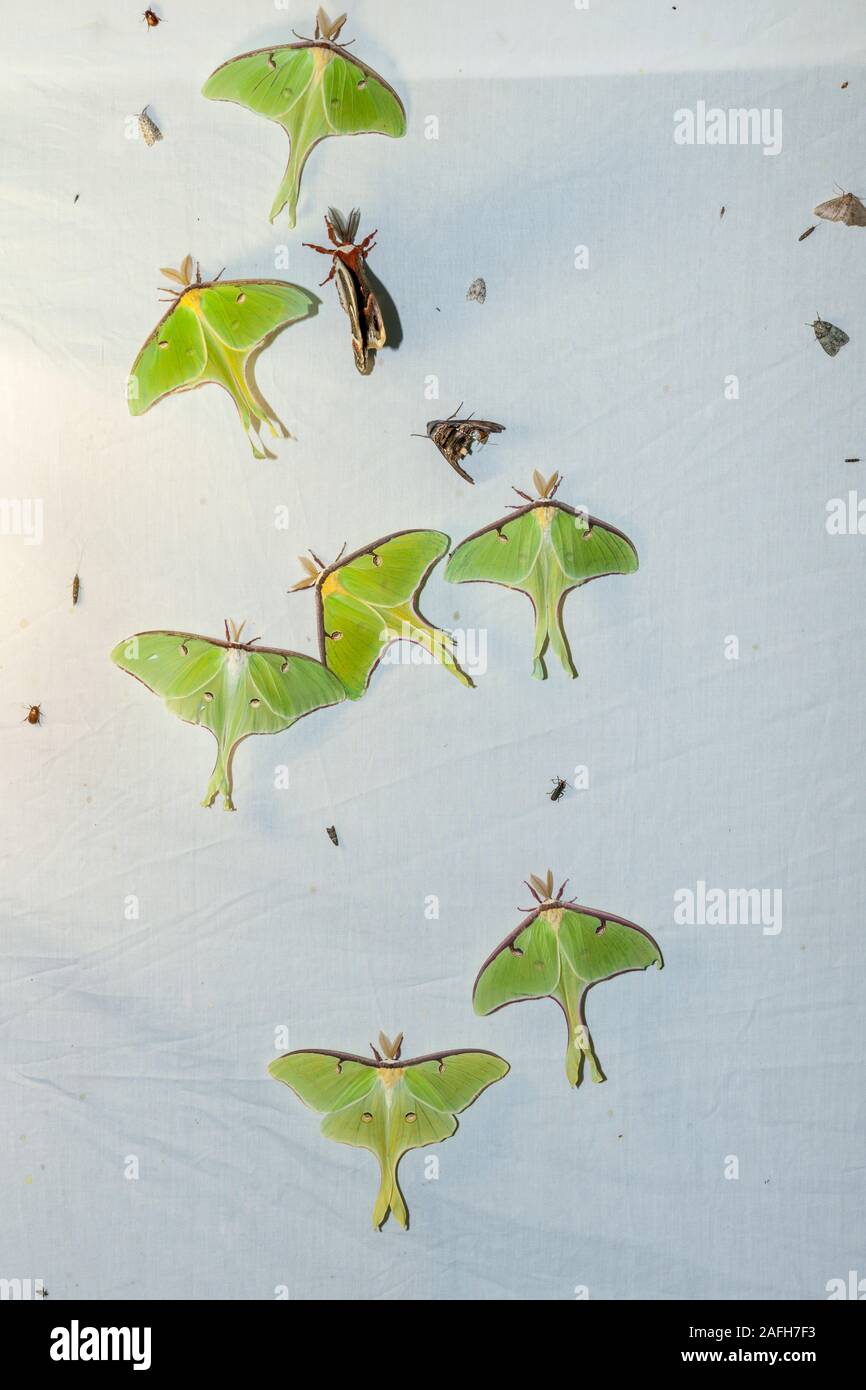 Large number of Luna Moths on sheet during a spring mercury vapor night lighting session near Congaree River, South Carolina. Also note the Cecropia M Stock Photohttps://www.alamy.com/image-license-details/?v=1https://www.alamy.com/large-number-of-luna-moths-on-sheet-during-a-spring-mercury-vapor-night-lighting-session-near-congaree-river-south-carolina-also-note-the-cecropia-m-image336595927.html
Large number of Luna Moths on sheet during a spring mercury vapor night lighting session near Congaree River, South Carolina. Also note the Cecropia M Stock Photohttps://www.alamy.com/image-license-details/?v=1https://www.alamy.com/large-number-of-luna-moths-on-sheet-during-a-spring-mercury-vapor-night-lighting-session-near-congaree-river-south-carolina-also-note-the-cecropia-m-image336595927.htmlRM2AFH7F3–Large number of Luna Moths on sheet during a spring mercury vapor night lighting session near Congaree River, South Carolina. Also note the Cecropia M
 . The Biological bulletin. Biology; Zoology; Biology; Marine Biology. 34 A. J. SWEATT AND R. B. FORWARD. JR. stimulus strengths employed, the animals would exhibit both saturated and control level phototactic responses. The stimulus-response function for positive phototaxis was determined at 15 wavelengths spaced at 20 nm intervals over the region 400-680 nm. The data were used to determine an action spectrum for phototaxis. Details of the calculation of the action spectrum are given with the results. RESULTS S. hispida displayed only positive phototaxis in these experiments. Negative pho- tot Stock Photohttps://www.alamy.com/image-license-details/?v=1https://www.alamy.com/the-biological-bulletin-biology-zoology-biology-marine-biology-34-a-j-sweatt-and-r-b-forward-jr-stimulus-strengths-employed-the-animals-would-exhibit-both-saturated-and-control-level-phototactic-responses-the-stimulus-response-function-for-positive-phototaxis-was-determined-at-15-wavelengths-spaced-at-20-nm-intervals-over-the-region-400-680-nm-the-data-were-used-to-determine-an-action-spectrum-for-phototaxis-details-of-the-calculation-of-the-action-spectrum-are-given-with-the-results-results-s-hispida-displayed-only-positive-phototaxis-in-these-experiments-negative-pho-tot-image234647868.html
. The Biological bulletin. Biology; Zoology; Biology; Marine Biology. 34 A. J. SWEATT AND R. B. FORWARD. JR. stimulus strengths employed, the animals would exhibit both saturated and control level phototactic responses. The stimulus-response function for positive phototaxis was determined at 15 wavelengths spaced at 20 nm intervals over the region 400-680 nm. The data were used to determine an action spectrum for phototaxis. Details of the calculation of the action spectrum are given with the results. RESULTS S. hispida displayed only positive phototaxis in these experiments. Negative pho- tot Stock Photohttps://www.alamy.com/image-license-details/?v=1https://www.alamy.com/the-biological-bulletin-biology-zoology-biology-marine-biology-34-a-j-sweatt-and-r-b-forward-jr-stimulus-strengths-employed-the-animals-would-exhibit-both-saturated-and-control-level-phototactic-responses-the-stimulus-response-function-for-positive-phototaxis-was-determined-at-15-wavelengths-spaced-at-20-nm-intervals-over-the-region-400-680-nm-the-data-were-used-to-determine-an-action-spectrum-for-phototaxis-details-of-the-calculation-of-the-action-spectrum-are-given-with-the-results-results-s-hispida-displayed-only-positive-phototaxis-in-these-experiments-negative-pho-tot-image234647868.htmlRMRHN3N0–. The Biological bulletin. Biology; Zoology; Biology; Marine Biology. 34 A. J. SWEATT AND R. B. FORWARD. JR. stimulus strengths employed, the animals would exhibit both saturated and control level phototactic responses. The stimulus-response function for positive phototaxis was determined at 15 wavelengths spaced at 20 nm intervals over the region 400-680 nm. The data were used to determine an action spectrum for phototaxis. Details of the calculation of the action spectrum are given with the results. RESULTS S. hispida displayed only positive phototaxis in these experiments. Negative pho- tot
 Large number of Luna Moths on sheet during a spring mercury vapor night lighting session near Congaree River, South Carolina. Also note the Cecropia M Stock Photohttps://www.alamy.com/image-license-details/?v=1https://www.alamy.com/large-number-of-luna-moths-on-sheet-during-a-spring-mercury-vapor-night-lighting-session-near-congaree-river-south-carolina-also-note-the-cecropia-m-image336595989.html
Large number of Luna Moths on sheet during a spring mercury vapor night lighting session near Congaree River, South Carolina. Also note the Cecropia M Stock Photohttps://www.alamy.com/image-license-details/?v=1https://www.alamy.com/large-number-of-luna-moths-on-sheet-during-a-spring-mercury-vapor-night-lighting-session-near-congaree-river-south-carolina-also-note-the-cecropia-m-image336595989.htmlRM2AFH7H9–Large number of Luna Moths on sheet during a spring mercury vapor night lighting session near Congaree River, South Carolina. Also note the Cecropia M
 . The Biological bulletin. Biology; Zoology; Biology; Marine Biology. 298 R. B. FORWARD, JR. AND T. W. CRONIN of most larvae to stage IV zoeae which swim faster than stage III (Forward and Costlow, 1974). Even with this molt, the rhythm continues under constant con- ditions for at least 54 hr. There is no indication of a diel component of the rhythm. Phototaxis Generally the larvae respond positively to high light intensities and negatively to low (Fig. 2), which is the typical pattern (Forward and Costlow, 1974). The curves of responsiveness to different light intensities suggest that photo- Stock Photohttps://www.alamy.com/image-license-details/?v=1https://www.alamy.com/the-biological-bulletin-biology-zoology-biology-marine-biology-298-r-b-forward-jr-and-t-w-cronin-of-most-larvae-to-stage-iv-zoeae-which-swim-faster-than-stage-iii-forward-and-costlow-1974-even-with-this-molt-the-rhythm-continues-under-constant-con-ditions-for-at-least-54-hr-there-is-no-indication-of-a-diel-component-of-the-rhythm-phototaxis-generally-the-larvae-respond-positively-to-high-light-intensities-and-negatively-to-low-fig-2-which-is-the-typical-pattern-forward-and-costlow-1974-the-curves-of-responsiveness-to-different-light-intensities-suggest-that-photo-image234619592.html
. The Biological bulletin. Biology; Zoology; Biology; Marine Biology. 298 R. B. FORWARD, JR. AND T. W. CRONIN of most larvae to stage IV zoeae which swim faster than stage III (Forward and Costlow, 1974). Even with this molt, the rhythm continues under constant con- ditions for at least 54 hr. There is no indication of a diel component of the rhythm. Phototaxis Generally the larvae respond positively to high light intensities and negatively to low (Fig. 2), which is the typical pattern (Forward and Costlow, 1974). The curves of responsiveness to different light intensities suggest that photo- Stock Photohttps://www.alamy.com/image-license-details/?v=1https://www.alamy.com/the-biological-bulletin-biology-zoology-biology-marine-biology-298-r-b-forward-jr-and-t-w-cronin-of-most-larvae-to-stage-iv-zoeae-which-swim-faster-than-stage-iii-forward-and-costlow-1974-even-with-this-molt-the-rhythm-continues-under-constant-con-ditions-for-at-least-54-hr-there-is-no-indication-of-a-diel-component-of-the-rhythm-phototaxis-generally-the-larvae-respond-positively-to-high-light-intensities-and-negatively-to-low-fig-2-which-is-the-typical-pattern-forward-and-costlow-1974-the-curves-of-responsiveness-to-different-light-intensities-suggest-that-photo-image234619592.htmlRMRHKRK4–. The Biological bulletin. Biology; Zoology; Biology; Marine Biology. 298 R. B. FORWARD, JR. AND T. W. CRONIN of most larvae to stage IV zoeae which swim faster than stage III (Forward and Costlow, 1974). Even with this molt, the rhythm continues under constant con- ditions for at least 54 hr. There is no indication of a diel component of the rhythm. Phototaxis Generally the larvae respond positively to high light intensities and negatively to low (Fig. 2), which is the typical pattern (Forward and Costlow, 1974). The curves of responsiveness to different light intensities suggest that photo-
 Diversity of moths cover sheet after spring nightlighting in northern Dauphin County, Pennsylvania. Genera represented include Acronicta, Actias, Depr Stock Photohttps://www.alamy.com/image-license-details/?v=1https://www.alamy.com/diversity-of-moths-cover-sheet-after-spring-nightlighting-in-northern-dauphin-county-pennsylvania-genera-represented-include-acronicta-actias-depr-image336596008.html
Diversity of moths cover sheet after spring nightlighting in northern Dauphin County, Pennsylvania. Genera represented include Acronicta, Actias, Depr Stock Photohttps://www.alamy.com/image-license-details/?v=1https://www.alamy.com/diversity-of-moths-cover-sheet-after-spring-nightlighting-in-northern-dauphin-county-pennsylvania-genera-represented-include-acronicta-actias-depr-image336596008.htmlRM2AFH7J0–Diversity of moths cover sheet after spring nightlighting in northern Dauphin County, Pennsylvania. Genera represented include Acronicta, Actias, Depr
![. Experimental morphology. Protoplasm; Growth. §4] PHOTOTAXIS AND PHOTOPATHY 205 organisms is determined by the direction of the light rays. There is, then, such a thing as phototaxis. But is the direction of locomotion ever determined by a dif- ference of intensity of light in adjacent regions, without refer- ence to the direction of the light rays ? Whole series of obser- vations make this probable; for a migration to a definite part of the trough has followed unequal illumination by rays perpendicular to the trough. Thus Lubbock found that. Fig. 60.—Two test tubes a and &, containing Po Stock Photo . Experimental morphology. Protoplasm; Growth. §4] PHOTOTAXIS AND PHOTOPATHY 205 organisms is determined by the direction of the light rays. There is, then, such a thing as phototaxis. But is the direction of locomotion ever determined by a dif- ference of intensity of light in adjacent regions, without refer- ence to the direction of the light rays ? Whole series of obser- vations make this probable; for a migration to a definite part of the trough has followed unequal illumination by rays perpendicular to the trough. Thus Lubbock found that. Fig. 60.—Two test tubes a and &, containing Po Stock Photo](https://c8.alamy.com/comp/RE0C4H/experimental-morphology-protoplasm-growth-4-phototaxis-and-photopathy-205-organisms-is-determined-by-the-direction-of-the-light-rays-there-is-then-such-a-thing-as-phototaxis-but-is-the-direction-of-locomotion-ever-determined-by-a-dif-ference-of-intensity-of-light-in-adjacent-regions-without-refer-ence-to-the-direction-of-the-light-rays-whole-series-of-obser-vations-make-this-probable-for-a-migration-to-a-definite-part-of-the-trough-has-followed-unequal-illumination-by-rays-perpendicular-to-the-trough-thus-lubbock-found-that-fig-60two-test-tubes-a-and-amp-containing-po-RE0C4H.jpg) . Experimental morphology. Protoplasm; Growth. §4] PHOTOTAXIS AND PHOTOPATHY 205 organisms is determined by the direction of the light rays. There is, then, such a thing as phototaxis. But is the direction of locomotion ever determined by a dif- ference of intensity of light in adjacent regions, without refer- ence to the direction of the light rays ? Whole series of obser- vations make this probable; for a migration to a definite part of the trough has followed unequal illumination by rays perpendicular to the trough. Thus Lubbock found that. Fig. 60.—Two test tubes a and &, containing Po Stock Photohttps://www.alamy.com/image-license-details/?v=1https://www.alamy.com/experimental-morphology-protoplasm-growth-4-phototaxis-and-photopathy-205-organisms-is-determined-by-the-direction-of-the-light-rays-there-is-then-such-a-thing-as-phototaxis-but-is-the-direction-of-locomotion-ever-determined-by-a-dif-ference-of-intensity-of-light-in-adjacent-regions-without-refer-ence-to-the-direction-of-the-light-rays-whole-series-of-obser-vations-make-this-probable-for-a-migration-to-a-definite-part-of-the-trough-has-followed-unequal-illumination-by-rays-perpendicular-to-the-trough-thus-lubbock-found-that-fig-60two-test-tubes-a-and-amp-containing-po-image232349505.html
. Experimental morphology. Protoplasm; Growth. §4] PHOTOTAXIS AND PHOTOPATHY 205 organisms is determined by the direction of the light rays. There is, then, such a thing as phototaxis. But is the direction of locomotion ever determined by a dif- ference of intensity of light in adjacent regions, without refer- ence to the direction of the light rays ? Whole series of obser- vations make this probable; for a migration to a definite part of the trough has followed unequal illumination by rays perpendicular to the trough. Thus Lubbock found that. Fig. 60.—Two test tubes a and &, containing Po Stock Photohttps://www.alamy.com/image-license-details/?v=1https://www.alamy.com/experimental-morphology-protoplasm-growth-4-phototaxis-and-photopathy-205-organisms-is-determined-by-the-direction-of-the-light-rays-there-is-then-such-a-thing-as-phototaxis-but-is-the-direction-of-locomotion-ever-determined-by-a-dif-ference-of-intensity-of-light-in-adjacent-regions-without-refer-ence-to-the-direction-of-the-light-rays-whole-series-of-obser-vations-make-this-probable-for-a-migration-to-a-definite-part-of-the-trough-has-followed-unequal-illumination-by-rays-perpendicular-to-the-trough-thus-lubbock-found-that-fig-60two-test-tubes-a-and-amp-containing-po-image232349505.htmlRMRE0C4H–. Experimental morphology. Protoplasm; Growth. §4] PHOTOTAXIS AND PHOTOPATHY 205 organisms is determined by the direction of the light rays. There is, then, such a thing as phototaxis. But is the direction of locomotion ever determined by a dif- ference of intensity of light in adjacent regions, without refer- ence to the direction of the light rays ? Whole series of obser- vations make this probable; for a migration to a definite part of the trough has followed unequal illumination by rays perpendicular to the trough. Thus Lubbock found that. Fig. 60.—Two test tubes a and &, containing Po
 Large number of Luna Moths on sheet during a spring mercury vapor night lighting session near Congaree River, South Carolina. Also note the Cecropia M Stock Photohttps://www.alamy.com/image-license-details/?v=1https://www.alamy.com/large-number-of-luna-moths-on-sheet-during-a-spring-mercury-vapor-night-lighting-session-near-congaree-river-south-carolina-also-note-the-cecropia-m-image336595994.html
Large number of Luna Moths on sheet during a spring mercury vapor night lighting session near Congaree River, South Carolina. Also note the Cecropia M Stock Photohttps://www.alamy.com/image-license-details/?v=1https://www.alamy.com/large-number-of-luna-moths-on-sheet-during-a-spring-mercury-vapor-night-lighting-session-near-congaree-river-south-carolina-also-note-the-cecropia-m-image336595994.htmlRM2AFH7HE–Large number of Luna Moths on sheet during a spring mercury vapor night lighting session near Congaree River, South Carolina. Also note the Cecropia M
 . Annals of the South African Museum = Annale van die Suid-Afrikaanse Museum. Natural history. i86 ANNALS OF THE SOUTH AFRICAN MUSEUM vertical migration, a positive geotaxis and a negative phototaxis being induced under ultra-violet and violet light stimulation. The reversal of this behaviour may apply to the planktonic naupliosoma and young phyllosoma larvae of J. lalandii, ^vhich Gilchrist (191 '^a) found to be strongly attracted to the source of bright illumination, while older larvae persistently avoided light. (b) Compound eyes From examinations of serial sections it is apparent that the Stock Photohttps://www.alamy.com/image-license-details/?v=1https://www.alamy.com/annals-of-the-south-african-museum-=-annale-van-die-suid-afrikaanse-museum-natural-history-i86-annals-of-the-south-african-museum-vertical-migration-a-positive-geotaxis-and-a-negative-phototaxis-being-induced-under-ultra-violet-and-violet-light-stimulation-the-reversal-of-this-behaviour-may-apply-to-the-planktonic-naupliosoma-and-young-phyllosoma-larvae-of-j-lalandii-vhich-gilchrist-191-a-found-to-be-strongly-attracted-to-the-source-of-bright-illumination-while-older-larvae-persistently-avoided-light-b-compound-eyes-from-examinations-of-serial-sections-it-is-apparent-that-the-image236434104.html
. Annals of the South African Museum = Annale van die Suid-Afrikaanse Museum. Natural history. i86 ANNALS OF THE SOUTH AFRICAN MUSEUM vertical migration, a positive geotaxis and a negative phototaxis being induced under ultra-violet and violet light stimulation. The reversal of this behaviour may apply to the planktonic naupliosoma and young phyllosoma larvae of J. lalandii, ^vhich Gilchrist (191 '^a) found to be strongly attracted to the source of bright illumination, while older larvae persistently avoided light. (b) Compound eyes From examinations of serial sections it is apparent that the Stock Photohttps://www.alamy.com/image-license-details/?v=1https://www.alamy.com/annals-of-the-south-african-museum-=-annale-van-die-suid-afrikaanse-museum-natural-history-i86-annals-of-the-south-african-museum-vertical-migration-a-positive-geotaxis-and-a-negative-phototaxis-being-induced-under-ultra-violet-and-violet-light-stimulation-the-reversal-of-this-behaviour-may-apply-to-the-planktonic-naupliosoma-and-young-phyllosoma-larvae-of-j-lalandii-vhich-gilchrist-191-a-found-to-be-strongly-attracted-to-the-source-of-bright-illumination-while-older-larvae-persistently-avoided-light-b-compound-eyes-from-examinations-of-serial-sections-it-is-apparent-that-the-image236434104.htmlRMRMJE34–. Annals of the South African Museum = Annale van die Suid-Afrikaanse Museum. Natural history. i86 ANNALS OF THE SOUTH AFRICAN MUSEUM vertical migration, a positive geotaxis and a negative phototaxis being induced under ultra-violet and violet light stimulation. The reversal of this behaviour may apply to the planktonic naupliosoma and young phyllosoma larvae of J. lalandii, ^vhich Gilchrist (191 '^a) found to be strongly attracted to the source of bright illumination, while older larvae persistently avoided light. (b) Compound eyes From examinations of serial sections it is apparent that the
 Large number of Luna Moths on sheet during a spring mercury vapor night lighting session near Congaree River, South Carolina. Also note the Cecropia M Stock Photohttps://www.alamy.com/image-license-details/?v=1https://www.alamy.com/large-number-of-luna-moths-on-sheet-during-a-spring-mercury-vapor-night-lighting-session-near-congaree-river-south-carolina-also-note-the-cecropia-m-image336595975.html
Large number of Luna Moths on sheet during a spring mercury vapor night lighting session near Congaree River, South Carolina. Also note the Cecropia M Stock Photohttps://www.alamy.com/image-license-details/?v=1https://www.alamy.com/large-number-of-luna-moths-on-sheet-during-a-spring-mercury-vapor-night-lighting-session-near-congaree-river-south-carolina-also-note-the-cecropia-m-image336595975.htmlRM2AFH7GR–Large number of Luna Moths on sheet during a spring mercury vapor night lighting session near Congaree River, South Carolina. Also note the Cecropia M
 . General physiology; an outline of the science of life. 454 GENERAL PHYSIOLOGY tactic, i.e., swim in crowds away from the warmer side, while with temperatures below this limit they show positive thermotaxis, since they leave the cooler side. There is here a phenomenon com- pletely analogous to chemotaxis and phototaxis, in which the organisms likewise turn from both sides toward a certain degree of intensity of the stimulus. A simple calculation shows how small the difference in temperature can be at the two poles of the body of the Faramcccmm, and still produce a thermotactic effect. The len Stock Photohttps://www.alamy.com/image-license-details/?v=1https://www.alamy.com/general-physiology-an-outline-of-the-science-of-life-454-general-physiology-tactic-ie-swim-in-crowds-away-from-the-warmer-side-while-with-temperatures-below-this-limit-they-show-positive-thermotaxis-since-they-leave-the-cooler-side-there-is-here-a-phenomenon-com-pletely-analogous-to-chemotaxis-and-phototaxis-in-which-the-organisms-likewise-turn-from-both-sides-toward-a-certain-degree-of-intensity-of-the-stimulus-a-simple-calculation-shows-how-small-the-difference-in-temperature-can-be-at-the-two-poles-of-the-body-of-the-faramcccmm-and-still-produce-a-thermotactic-effect-the-len-image232352183.html
. General physiology; an outline of the science of life. 454 GENERAL PHYSIOLOGY tactic, i.e., swim in crowds away from the warmer side, while with temperatures below this limit they show positive thermotaxis, since they leave the cooler side. There is here a phenomenon com- pletely analogous to chemotaxis and phototaxis, in which the organisms likewise turn from both sides toward a certain degree of intensity of the stimulus. A simple calculation shows how small the difference in temperature can be at the two poles of the body of the Faramcccmm, and still produce a thermotactic effect. The len Stock Photohttps://www.alamy.com/image-license-details/?v=1https://www.alamy.com/general-physiology-an-outline-of-the-science-of-life-454-general-physiology-tactic-ie-swim-in-crowds-away-from-the-warmer-side-while-with-temperatures-below-this-limit-they-show-positive-thermotaxis-since-they-leave-the-cooler-side-there-is-here-a-phenomenon-com-pletely-analogous-to-chemotaxis-and-phototaxis-in-which-the-organisms-likewise-turn-from-both-sides-toward-a-certain-degree-of-intensity-of-the-stimulus-a-simple-calculation-shows-how-small-the-difference-in-temperature-can-be-at-the-two-poles-of-the-body-of-the-faramcccmm-and-still-produce-a-thermotactic-effect-the-len-image232352183.htmlRMRE0FG7–. General physiology; an outline of the science of life. 454 GENERAL PHYSIOLOGY tactic, i.e., swim in crowds away from the warmer side, while with temperatures below this limit they show positive thermotaxis, since they leave the cooler side. There is here a phenomenon com- pletely analogous to chemotaxis and phototaxis, in which the organisms likewise turn from both sides toward a certain degree of intensity of the stimulus. A simple calculation shows how small the difference in temperature can be at the two poles of the body of the Faramcccmm, and still produce a thermotactic effect. The len
 Large number of Luna Moths on sheet during a spring mercury vapor night lighting session near Congaree River, South Carolina. Also note the Cecropia M Stock Photohttps://www.alamy.com/image-license-details/?v=1https://www.alamy.com/large-number-of-luna-moths-on-sheet-during-a-spring-mercury-vapor-night-lighting-session-near-congaree-river-south-carolina-also-note-the-cecropia-m-image336595913.html
Large number of Luna Moths on sheet during a spring mercury vapor night lighting session near Congaree River, South Carolina. Also note the Cecropia M Stock Photohttps://www.alamy.com/image-license-details/?v=1https://www.alamy.com/large-number-of-luna-moths-on-sheet-during-a-spring-mercury-vapor-night-lighting-session-near-congaree-river-south-carolina-also-note-the-cecropia-m-image336595913.htmlRM2AFH7EH–Large number of Luna Moths on sheet during a spring mercury vapor night lighting session near Congaree River, South Carolina. Also note the Cecropia M
 . Annotationes zoologicae japonenses / Nihon do?butsugaku iho?. 4 K. MITSTJKUBI. of negative phototaxis shown hy these molluscs must necessarily lead them to move landward instead of sea-ward in their native habitat, and must lead them to act as if they had a notion as to which way lay the land and which way the water. Accordingly I walked along the shore- line, carefully observing how light struck my eyes. There could be no question as to which gave out more light : wherever 1 might put myself along the shore, (except on detached rocks) there was always more light facing the sea than when fac Stock Photohttps://www.alamy.com/image-license-details/?v=1https://www.alamy.com/annotationes-zoologicae-japonenses-nihon-dobutsugaku-iho-4-k-mitstjkubi-of-negative-phototaxis-shown-hy-these-molluscs-must-necessarily-lead-them-to-move-landward-instead-of-sea-ward-in-their-native-habitat-and-must-lead-them-to-act-as-if-they-had-a-notion-as-to-which-way-lay-the-land-and-which-way-the-water-accordingly-i-walked-along-the-shore-line-carefully-observing-how-light-struck-my-eyes-there-could-be-no-question-as-to-which-gave-out-more-light-wherever-1-might-put-myself-along-the-shore-except-on-detached-rocks-there-was-always-more-light-facing-the-sea-than-when-fac-image236393275.html
. Annotationes zoologicae japonenses / Nihon do?butsugaku iho?. 4 K. MITSTJKUBI. of negative phototaxis shown hy these molluscs must necessarily lead them to move landward instead of sea-ward in their native habitat, and must lead them to act as if they had a notion as to which way lay the land and which way the water. Accordingly I walked along the shore- line, carefully observing how light struck my eyes. There could be no question as to which gave out more light : wherever 1 might put myself along the shore, (except on detached rocks) there was always more light facing the sea than when fac Stock Photohttps://www.alamy.com/image-license-details/?v=1https://www.alamy.com/annotationes-zoologicae-japonenses-nihon-dobutsugaku-iho-4-k-mitstjkubi-of-negative-phototaxis-shown-hy-these-molluscs-must-necessarily-lead-them-to-move-landward-instead-of-sea-ward-in-their-native-habitat-and-must-lead-them-to-act-as-if-they-had-a-notion-as-to-which-way-lay-the-land-and-which-way-the-water-accordingly-i-walked-along-the-shore-line-carefully-observing-how-light-struck-my-eyes-there-could-be-no-question-as-to-which-gave-out-more-light-wherever-1-might-put-myself-along-the-shore-except-on-detached-rocks-there-was-always-more-light-facing-the-sea-than-when-fac-image236393275.htmlRMRMGJ0Y–. Annotationes zoologicae japonenses / Nihon do?butsugaku iho?. 4 K. MITSTJKUBI. of negative phototaxis shown hy these molluscs must necessarily lead them to move landward instead of sea-ward in their native habitat, and must lead them to act as if they had a notion as to which way lay the land and which way the water. Accordingly I walked along the shore- line, carefully observing how light struck my eyes. There could be no question as to which gave out more light : wherever 1 might put myself along the shore, (except on detached rocks) there was always more light facing the sea than when fac
 Imperial Moths (Eacles imperialis) Covering sheet in early AM after incredible night of nightlighting for moths in northern Dauphin County, Pennsylvan Stock Photohttps://www.alamy.com/image-license-details/?v=1https://www.alamy.com/imperial-moths-eacles-imperialis-covering-sheet-in-early-am-after-incredible-night-of-nightlighting-for-moths-in-northern-dauphin-county-pennsylvan-image336595845.html
Imperial Moths (Eacles imperialis) Covering sheet in early AM after incredible night of nightlighting for moths in northern Dauphin County, Pennsylvan Stock Photohttps://www.alamy.com/image-license-details/?v=1https://www.alamy.com/imperial-moths-eacles-imperialis-covering-sheet-in-early-am-after-incredible-night-of-nightlighting-for-moths-in-northern-dauphin-county-pennsylvan-image336595845.htmlRM2AFH7C5–Imperial Moths (Eacles imperialis) Covering sheet in early AM after incredible night of nightlighting for moths in northern Dauphin County, Pennsylvan
 . The Biological bulletin. Biology; Zoology; Biology; Marine Biology. Negative Phototaxis. Please note that these images are extracted from scanned page images that may have been digitally enhanced for readability - coloration and appearance of these illustrations may not perfectly resemble the original work.. Marine Biological Laboratory (Woods Hole, Mass. ); Marine Biological Laboratory (Woods Hole, Mass. ). Annual report 1907/08-1952; Lillie, Frank Rattray, 1870-1947; Moore, Carl Richard, 1892-; Redfield, Alfred Clarence, 1890-1983. Woods Hole, Mass. : Marine Biological Laboratory Stock Photohttps://www.alamy.com/image-license-details/?v=1https://www.alamy.com/the-biological-bulletin-biology-zoology-biology-marine-biology-negative-phototaxis-please-note-that-these-images-are-extracted-from-scanned-page-images-that-may-have-been-digitally-enhanced-for-readability-coloration-and-appearance-of-these-illustrations-may-not-perfectly-resemble-the-original-work-marine-biological-laboratory-woods-hole-mass-marine-biological-laboratory-woods-hole-mass-annual-report-190708-1952-lillie-frank-rattray-1870-1947-moore-carl-richard-1892-redfield-alfred-clarence-1890-1983-woods-hole-mass-marine-biological-laboratory-image234619650.html
. The Biological bulletin. Biology; Zoology; Biology; Marine Biology. Negative Phototaxis. Please note that these images are extracted from scanned page images that may have been digitally enhanced for readability - coloration and appearance of these illustrations may not perfectly resemble the original work.. Marine Biological Laboratory (Woods Hole, Mass. ); Marine Biological Laboratory (Woods Hole, Mass. ). Annual report 1907/08-1952; Lillie, Frank Rattray, 1870-1947; Moore, Carl Richard, 1892-; Redfield, Alfred Clarence, 1890-1983. Woods Hole, Mass. : Marine Biological Laboratory Stock Photohttps://www.alamy.com/image-license-details/?v=1https://www.alamy.com/the-biological-bulletin-biology-zoology-biology-marine-biology-negative-phototaxis-please-note-that-these-images-are-extracted-from-scanned-page-images-that-may-have-been-digitally-enhanced-for-readability-coloration-and-appearance-of-these-illustrations-may-not-perfectly-resemble-the-original-work-marine-biological-laboratory-woods-hole-mass-marine-biological-laboratory-woods-hole-mass-annual-report-190708-1952-lillie-frank-rattray-1870-1947-moore-carl-richard-1892-redfield-alfred-clarence-1890-1983-woods-hole-mass-marine-biological-laboratory-image234619650.htmlRMRHKRN6–. The Biological bulletin. Biology; Zoology; Biology; Marine Biology. Negative Phototaxis. Please note that these images are extracted from scanned page images that may have been digitally enhanced for readability - coloration and appearance of these illustrations may not perfectly resemble the original work.. Marine Biological Laboratory (Woods Hole, Mass. ); Marine Biological Laboratory (Woods Hole, Mass. ). Annual report 1907/08-1952; Lillie, Frank Rattray, 1870-1947; Moore, Carl Richard, 1892-; Redfield, Alfred Clarence, 1890-1983. Woods Hole, Mass. : Marine Biological Laboratory
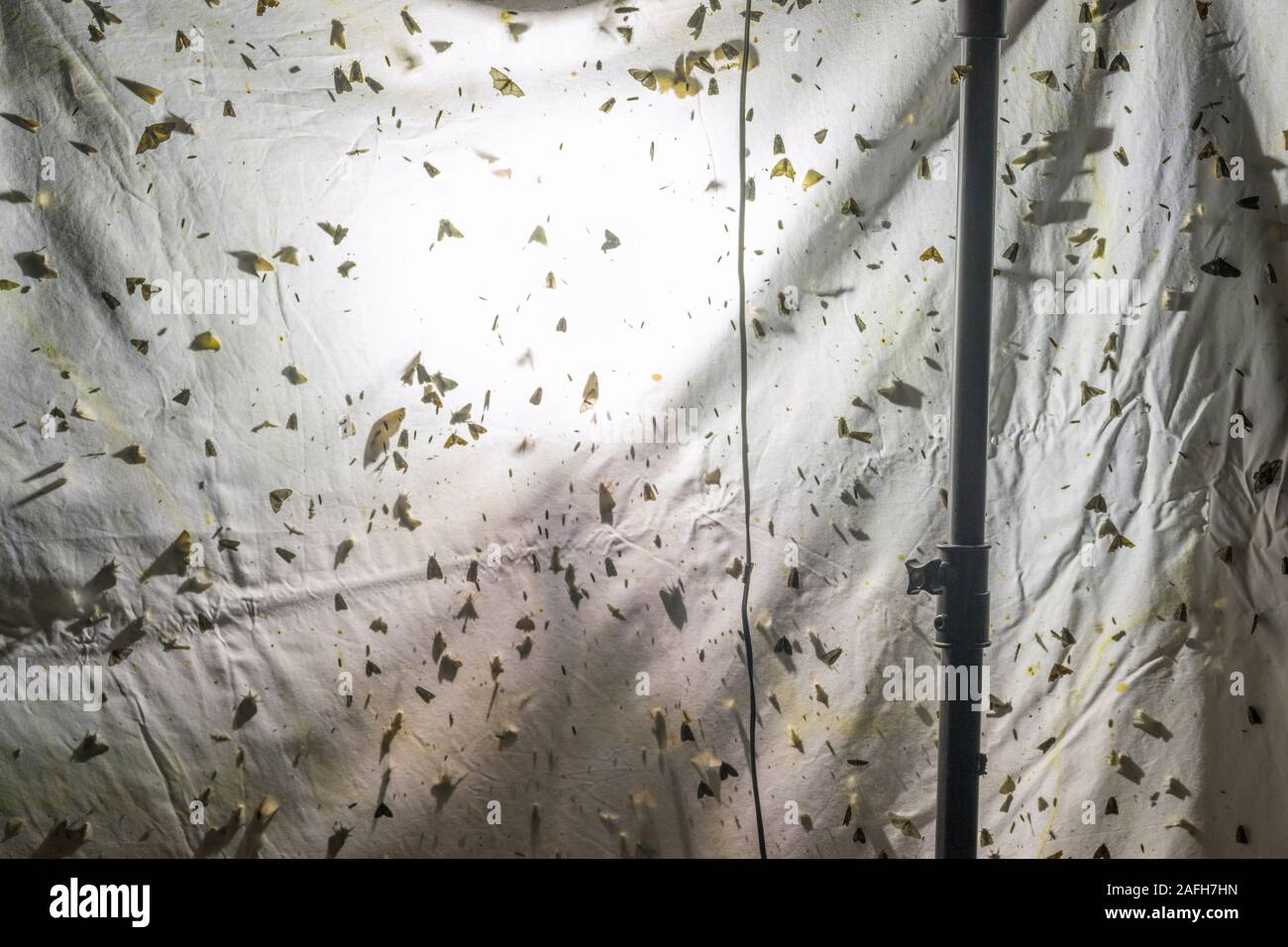 Diversity of moths cover sheet after spring nightlighting in northern Dauphin County, Pennsylvania. Genera represented include Acronicta, Deprana, Cha Stock Photohttps://www.alamy.com/image-license-details/?v=1https://www.alamy.com/diversity-of-moths-cover-sheet-after-spring-nightlighting-in-northern-dauphin-county-pennsylvania-genera-represented-include-acronicta-deprana-cha-image336596001.html
Diversity of moths cover sheet after spring nightlighting in northern Dauphin County, Pennsylvania. Genera represented include Acronicta, Deprana, Cha Stock Photohttps://www.alamy.com/image-license-details/?v=1https://www.alamy.com/diversity-of-moths-cover-sheet-after-spring-nightlighting-in-northern-dauphin-county-pennsylvania-genera-represented-include-acronicta-deprana-cha-image336596001.htmlRM2AFH7HN–Diversity of moths cover sheet after spring nightlighting in northern Dauphin County, Pennsylvania. Genera represented include Acronicta, Deprana, Cha
 Nightlighting for spring moths in central Pennsylvania. Portion of the sheet showing diveristy of moth species. Stock Photohttps://www.alamy.com/image-license-details/?v=1https://www.alamy.com/stock-photo-nightlighting-for-spring-moths-in-central-pennsylvania-portion-of-171071003.html
Nightlighting for spring moths in central Pennsylvania. Portion of the sheet showing diveristy of moth species. Stock Photohttps://www.alamy.com/image-license-details/?v=1https://www.alamy.com/stock-photo-nightlighting-for-spring-moths-in-central-pennsylvania-portion-of-171071003.htmlRMKX8XPK–Nightlighting for spring moths in central Pennsylvania. Portion of the sheet showing diveristy of moth species.
 . The Biological bulletin. Biology; Zoology; Biology; Marine Biology. Positive Phototaxis. Negative Phototaxis. Please note that these images are extracted from scanned page images that may have been digitally enhanced for readability - coloration and appearance of these illustrations may not perfectly resemble the original work.. Marine Biological Laboratory (Woods Hole, Mass. ); Marine Biological Laboratory (Woods Hole, Mass. ). Annual report 1907/08-1952; Lillie, Frank Rattray, 1870-1947; Moore, Carl Richard, 1892-; Redfield, Alfred Clarence, 1890-1983. Woods Hole, Mass. : Marine Biological Stock Photohttps://www.alamy.com/image-license-details/?v=1https://www.alamy.com/the-biological-bulletin-biology-zoology-biology-marine-biology-positive-phototaxis-negative-phototaxis-please-note-that-these-images-are-extracted-from-scanned-page-images-that-may-have-been-digitally-enhanced-for-readability-coloration-and-appearance-of-these-illustrations-may-not-perfectly-resemble-the-original-work-marine-biological-laboratory-woods-hole-mass-marine-biological-laboratory-woods-hole-mass-annual-report-190708-1952-lillie-frank-rattray-1870-1947-moore-carl-richard-1892-redfield-alfred-clarence-1890-1983-woods-hole-mass-marine-biological-image234619663.html
. The Biological bulletin. Biology; Zoology; Biology; Marine Biology. Positive Phototaxis. Negative Phototaxis. Please note that these images are extracted from scanned page images that may have been digitally enhanced for readability - coloration and appearance of these illustrations may not perfectly resemble the original work.. Marine Biological Laboratory (Woods Hole, Mass. ); Marine Biological Laboratory (Woods Hole, Mass. ). Annual report 1907/08-1952; Lillie, Frank Rattray, 1870-1947; Moore, Carl Richard, 1892-; Redfield, Alfred Clarence, 1890-1983. Woods Hole, Mass. : Marine Biological Stock Photohttps://www.alamy.com/image-license-details/?v=1https://www.alamy.com/the-biological-bulletin-biology-zoology-biology-marine-biology-positive-phototaxis-negative-phototaxis-please-note-that-these-images-are-extracted-from-scanned-page-images-that-may-have-been-digitally-enhanced-for-readability-coloration-and-appearance-of-these-illustrations-may-not-perfectly-resemble-the-original-work-marine-biological-laboratory-woods-hole-mass-marine-biological-laboratory-woods-hole-mass-annual-report-190708-1952-lillie-frank-rattray-1870-1947-moore-carl-richard-1892-redfield-alfred-clarence-1890-1983-woods-hole-mass-marine-biological-image234619663.htmlRMRHKRNK–. The Biological bulletin. Biology; Zoology; Biology; Marine Biology. Positive Phototaxis. Negative Phototaxis. Please note that these images are extracted from scanned page images that may have been digitally enhanced for readability - coloration and appearance of these illustrations may not perfectly resemble the original work.. Marine Biological Laboratory (Woods Hole, Mass. ); Marine Biological Laboratory (Woods Hole, Mass. ). Annual report 1907/08-1952; Lillie, Frank Rattray, 1870-1947; Moore, Carl Richard, 1892-; Redfield, Alfred Clarence, 1890-1983. Woods Hole, Mass. : Marine Biological
 Nightlighting for moths in spring. Luna, Polyphemus and Promethea moths are all clearly visible. Stock Photohttps://www.alamy.com/image-license-details/?v=1https://www.alamy.com/stock-photo-nightlighting-for-moths-in-spring-luna-polyphemus-and-promethea-moths-171070910.html
Nightlighting for moths in spring. Luna, Polyphemus and Promethea moths are all clearly visible. Stock Photohttps://www.alamy.com/image-license-details/?v=1https://www.alamy.com/stock-photo-nightlighting-for-moths-in-spring-luna-polyphemus-and-promethea-moths-171070910.htmlRMKX8XKA–Nightlighting for moths in spring. Luna, Polyphemus and Promethea moths are all clearly visible.
 . The Biological bulletin. Biology; Zoology; Biology; Marine Biology. ARROW WORM PHOTOTAXIS 421. Please note that these images are extracted from scanned page images that may have been digitally enhanced for readability - coloration and appearance of these illustrations may not perfectly resemble the original work.. Marine Biological Laboratory (Woods Hole, Mass. ); Marine Biological Laboratory (Woods Hole, Mass. ). Annual report 1907/08-1952; Lillie, Frank Rattray, 1870-1947; Moore, Carl Richard, 1892-; Redfield, Alfred Clarence, 1890-1983. Woods Hole, Mass. : Marine Biological Laboratory Stock Photohttps://www.alamy.com/image-license-details/?v=1https://www.alamy.com/the-biological-bulletin-biology-zoology-biology-marine-biology-arrow-worm-phototaxis-421-please-note-that-these-images-are-extracted-from-scanned-page-images-that-may-have-been-digitally-enhanced-for-readability-coloration-and-appearance-of-these-illustrations-may-not-perfectly-resemble-the-original-work-marine-biological-laboratory-woods-hole-mass-marine-biological-laboratory-woods-hole-mass-annual-report-190708-1952-lillie-frank-rattray-1870-1947-moore-carl-richard-1892-redfield-alfred-clarence-1890-1983-woods-hole-mass-marine-biological-laboratory-image234646751.html
. The Biological bulletin. Biology; Zoology; Biology; Marine Biology. ARROW WORM PHOTOTAXIS 421. Please note that these images are extracted from scanned page images that may have been digitally enhanced for readability - coloration and appearance of these illustrations may not perfectly resemble the original work.. Marine Biological Laboratory (Woods Hole, Mass. ); Marine Biological Laboratory (Woods Hole, Mass. ). Annual report 1907/08-1952; Lillie, Frank Rattray, 1870-1947; Moore, Carl Richard, 1892-; Redfield, Alfred Clarence, 1890-1983. Woods Hole, Mass. : Marine Biological Laboratory Stock Photohttps://www.alamy.com/image-license-details/?v=1https://www.alamy.com/the-biological-bulletin-biology-zoology-biology-marine-biology-arrow-worm-phototaxis-421-please-note-that-these-images-are-extracted-from-scanned-page-images-that-may-have-been-digitally-enhanced-for-readability-coloration-and-appearance-of-these-illustrations-may-not-perfectly-resemble-the-original-work-marine-biological-laboratory-woods-hole-mass-marine-biological-laboratory-woods-hole-mass-annual-report-190708-1952-lillie-frank-rattray-1870-1947-moore-carl-richard-1892-redfield-alfred-clarence-1890-1983-woods-hole-mass-marine-biological-laboratory-image234646751.htmlRMRHN293–. The Biological bulletin. Biology; Zoology; Biology; Marine Biology. ARROW WORM PHOTOTAXIS 421. Please note that these images are extracted from scanned page images that may have been digitally enhanced for readability - coloration and appearance of these illustrations may not perfectly resemble the original work.. Marine Biological Laboratory (Woods Hole, Mass. ); Marine Biological Laboratory (Woods Hole, Mass. ). Annual report 1907/08-1952; Lillie, Frank Rattray, 1870-1947; Moore, Carl Richard, 1892-; Redfield, Alfred Clarence, 1890-1983. Woods Hole, Mass. : Marine Biological Laboratory
 Nightlighting for moths in spring. Silhouettes of the many species attracted. Note the definitive shape of the Luna moths. Stock Photohttps://www.alamy.com/image-license-details/?v=1https://www.alamy.com/stock-photo-nightlighting-for-moths-in-spring-silhouettes-of-the-many-species-171070869.html
Nightlighting for moths in spring. Silhouettes of the many species attracted. Note the definitive shape of the Luna moths. Stock Photohttps://www.alamy.com/image-license-details/?v=1https://www.alamy.com/stock-photo-nightlighting-for-moths-in-spring-silhouettes-of-the-many-species-171070869.htmlRMKX8XHW–Nightlighting for moths in spring. Silhouettes of the many species attracted. Note the definitive shape of the Luna moths.
 . The Biological bulletin. Biology; Zoology; Biology; Marine Biology. MONOAMINES MODULATE PHOTOTAXIS 405. Figure 3. Scanning electron micrograph ofBugula nmiimi larva taken from lateral view. The meta- chronal waves of cilia mark the locations of the strap-like elongated coronal cells that together form the larval locomotory organ. Depressions in which the two pigmented eyespots (E) are situated are visible on the posterior lateral surface. The opening of the metasomal sac marks the oral pole (O) of the larva, and the ciliated apical disc (AD) is located at theaboral pole (A). -200 Figure 4. L Stock Photohttps://www.alamy.com/image-license-details/?v=1https://www.alamy.com/the-biological-bulletin-biology-zoology-biology-marine-biology-monoamines-modulate-phototaxis-405-figure-3-scanning-electron-micrograph-ofbugula-nmiimi-larva-taken-from-lateral-view-the-meta-chronal-waves-of-cilia-mark-the-locations-of-the-strap-like-elongated-coronal-cells-that-together-form-the-larval-locomotory-organ-depressions-in-which-the-two-pigmented-eyespots-e-are-situated-are-visible-on-the-posterior-lateral-surface-the-opening-of-the-metasomal-sac-marks-the-oral-pole-o-of-the-larva-and-the-ciliated-apical-disc-ad-is-located-at-theaboral-pole-a-200-figure-4-l-image234617083.html
. The Biological bulletin. Biology; Zoology; Biology; Marine Biology. MONOAMINES MODULATE PHOTOTAXIS 405. Figure 3. Scanning electron micrograph ofBugula nmiimi larva taken from lateral view. The meta- chronal waves of cilia mark the locations of the strap-like elongated coronal cells that together form the larval locomotory organ. Depressions in which the two pigmented eyespots (E) are situated are visible on the posterior lateral surface. The opening of the metasomal sac marks the oral pole (O) of the larva, and the ciliated apical disc (AD) is located at theaboral pole (A). -200 Figure 4. L Stock Photohttps://www.alamy.com/image-license-details/?v=1https://www.alamy.com/the-biological-bulletin-biology-zoology-biology-marine-biology-monoamines-modulate-phototaxis-405-figure-3-scanning-electron-micrograph-ofbugula-nmiimi-larva-taken-from-lateral-view-the-meta-chronal-waves-of-cilia-mark-the-locations-of-the-strap-like-elongated-coronal-cells-that-together-form-the-larval-locomotory-organ-depressions-in-which-the-two-pigmented-eyespots-e-are-situated-are-visible-on-the-posterior-lateral-surface-the-opening-of-the-metasomal-sac-marks-the-oral-pole-o-of-the-larva-and-the-ciliated-apical-disc-ad-is-located-at-theaboral-pole-a-200-figure-4-l-image234617083.htmlRMRHKMDF–. The Biological bulletin. Biology; Zoology; Biology; Marine Biology. MONOAMINES MODULATE PHOTOTAXIS 405. Figure 3. Scanning electron micrograph ofBugula nmiimi larva taken from lateral view. The meta- chronal waves of cilia mark the locations of the strap-like elongated coronal cells that together form the larval locomotory organ. Depressions in which the two pigmented eyespots (E) are situated are visible on the posterior lateral surface. The opening of the metasomal sac marks the oral pole (O) of the larva, and the ciliated apical disc (AD) is located at theaboral pole (A). -200 Figure 4. L
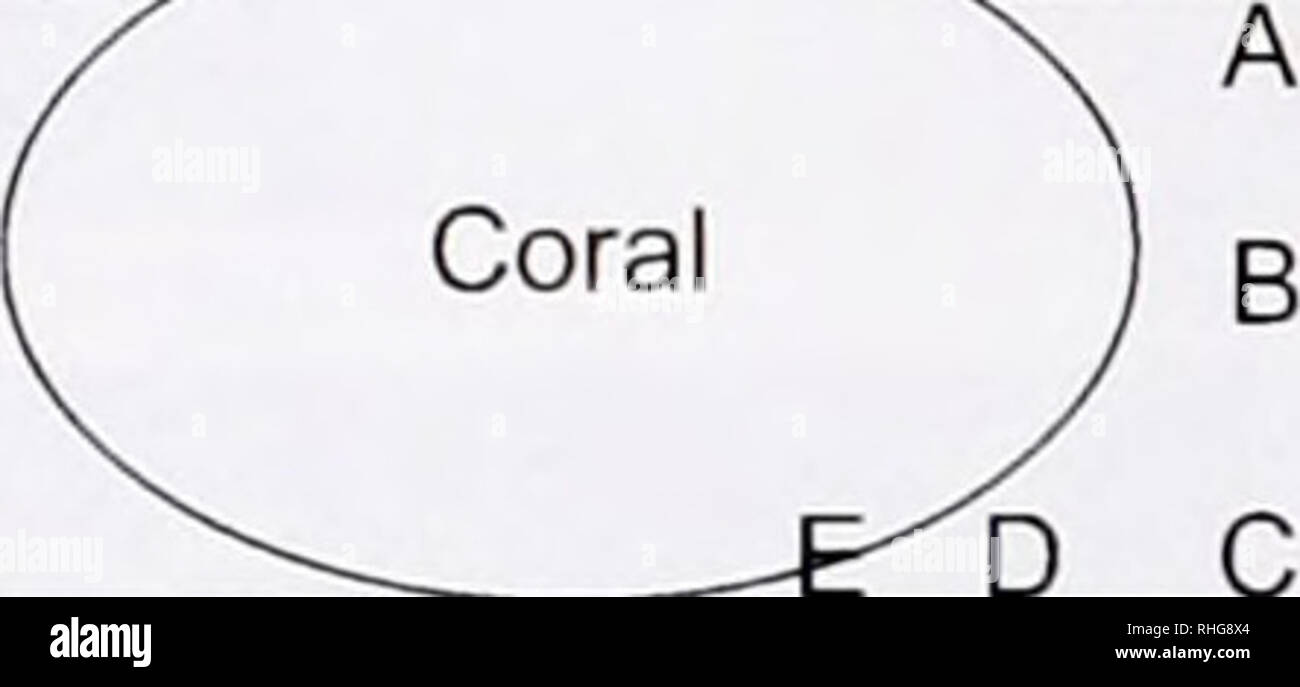 . The Biological bulletin. Biology; Zoology; Biology; Marine Biology. 30cm. Figure 2. (a) The experimental apparatus for measuring the phototaxis of individual larvae in response to horizontal light from a cold light source shining through a diffuser of acrylic plastic. A test chamber containing tillered seawater is immersed in seawater contained in an outer chamber, which is blackened on all sides except that facing the light source. Larvae were dropped by pipette into the inner test chamber in which there was a gradient of light in the horizontal direction (left to right in the diagram) of 9 Stock Photohttps://www.alamy.com/image-license-details/?v=1https://www.alamy.com/the-biological-bulletin-biology-zoology-biology-marine-biology-30cm-figure-2-a-the-experimental-apparatus-for-measuring-the-phototaxis-of-individual-larvae-in-response-to-horizontal-light-from-a-cold-light-source-shining-through-a-diffuser-of-acrylic-plastic-a-test-chamber-containing-tillered-seawater-is-immersed-in-seawater-contained-in-an-outer-chamber-which-is-blackened-on-all-sides-except-that-facing-the-light-source-larvae-were-dropped-by-pipette-into-the-inner-test-chamber-in-which-there-was-a-gradient-of-light-in-the-horizontal-direction-left-to-right-in-the-diagram-of-9-image234542172.html
. The Biological bulletin. Biology; Zoology; Biology; Marine Biology. 30cm. Figure 2. (a) The experimental apparatus for measuring the phototaxis of individual larvae in response to horizontal light from a cold light source shining through a diffuser of acrylic plastic. A test chamber containing tillered seawater is immersed in seawater contained in an outer chamber, which is blackened on all sides except that facing the light source. Larvae were dropped by pipette into the inner test chamber in which there was a gradient of light in the horizontal direction (left to right in the diagram) of 9 Stock Photohttps://www.alamy.com/image-license-details/?v=1https://www.alamy.com/the-biological-bulletin-biology-zoology-biology-marine-biology-30cm-figure-2-a-the-experimental-apparatus-for-measuring-the-phototaxis-of-individual-larvae-in-response-to-horizontal-light-from-a-cold-light-source-shining-through-a-diffuser-of-acrylic-plastic-a-test-chamber-containing-tillered-seawater-is-immersed-in-seawater-contained-in-an-outer-chamber-which-is-blackened-on-all-sides-except-that-facing-the-light-source-larvae-were-dropped-by-pipette-into-the-inner-test-chamber-in-which-there-was-a-gradient-of-light-in-the-horizontal-direction-left-to-right-in-the-diagram-of-9-image234542172.htmlRMRHG8X4–. The Biological bulletin. Biology; Zoology; Biology; Marine Biology. 30cm. Figure 2. (a) The experimental apparatus for measuring the phototaxis of individual larvae in response to horizontal light from a cold light source shining through a diffuser of acrylic plastic. A test chamber containing tillered seawater is immersed in seawater contained in an outer chamber, which is blackened on all sides except that facing the light source. Larvae were dropped by pipette into the inner test chamber in which there was a gradient of light in the horizontal direction (left to right in the diagram) of 9
 . The Biological bulletin. Biology; Zoology; Biology; Marine Biology. Positive Phototaxis Starved. Negative Phototaxis. Please note that these images are extracted from scanned page images that may have been digitally enhanced for readability - coloration and appearance of these illustrations may not perfectly resemble the original work.. Marine Biological Laboratory (Woods Hole, Mass. ); Marine Biological Laboratory (Woods Hole, Mass. ). Annual report 1907/08-1952; Lillie, Frank Rattray, 1870-1947; Moore, Carl Richard, 1892-; Redfield, Alfred Clarence, 1890-1983. Woods Hole, Mass. : Marine Bi Stock Photohttps://www.alamy.com/image-license-details/?v=1https://www.alamy.com/the-biological-bulletin-biology-zoology-biology-marine-biology-positive-phototaxis-starved-negative-phototaxis-please-note-that-these-images-are-extracted-from-scanned-page-images-that-may-have-been-digitally-enhanced-for-readability-coloration-and-appearance-of-these-illustrations-may-not-perfectly-resemble-the-original-work-marine-biological-laboratory-woods-hole-mass-marine-biological-laboratory-woods-hole-mass-annual-report-190708-1952-lillie-frank-rattray-1870-1947-moore-carl-richard-1892-redfield-alfred-clarence-1890-1983-woods-hole-mass-marine-bi-image234619720.html
. The Biological bulletin. Biology; Zoology; Biology; Marine Biology. Positive Phototaxis Starved. Negative Phototaxis. Please note that these images are extracted from scanned page images that may have been digitally enhanced for readability - coloration and appearance of these illustrations may not perfectly resemble the original work.. Marine Biological Laboratory (Woods Hole, Mass. ); Marine Biological Laboratory (Woods Hole, Mass. ). Annual report 1907/08-1952; Lillie, Frank Rattray, 1870-1947; Moore, Carl Richard, 1892-; Redfield, Alfred Clarence, 1890-1983. Woods Hole, Mass. : Marine Bi Stock Photohttps://www.alamy.com/image-license-details/?v=1https://www.alamy.com/the-biological-bulletin-biology-zoology-biology-marine-biology-positive-phototaxis-starved-negative-phototaxis-please-note-that-these-images-are-extracted-from-scanned-page-images-that-may-have-been-digitally-enhanced-for-readability-coloration-and-appearance-of-these-illustrations-may-not-perfectly-resemble-the-original-work-marine-biological-laboratory-woods-hole-mass-marine-biological-laboratory-woods-hole-mass-annual-report-190708-1952-lillie-frank-rattray-1870-1947-moore-carl-richard-1892-redfield-alfred-clarence-1890-1983-woods-hole-mass-marine-bi-image234619720.htmlRMRHKRRM–. The Biological bulletin. Biology; Zoology; Biology; Marine Biology. Positive Phototaxis Starved. Negative Phototaxis. Please note that these images are extracted from scanned page images that may have been digitally enhanced for readability - coloration and appearance of these illustrations may not perfectly resemble the original work.. Marine Biological Laboratory (Woods Hole, Mass. ); Marine Biological Laboratory (Woods Hole, Mass. ). Annual report 1907/08-1952; Lillie, Frank Rattray, 1870-1947; Moore, Carl Richard, 1892-; Redfield, Alfred Clarence, 1890-1983. Woods Hole, Mass. : Marine Bi
 . Annotationes zoologicae japonenses / Nihon do?butsugaku iho?. NEGATIVE PHOTOTAXIS ETC. Of LÜtorillCl 9. Fig. 5, B. imI i.i diminution observed in the number of individuals is due to two causes : one was that a wet roll of paper was kept at the junction of the glass-plates A and B with the glass-plate C and many reaching there hid themselves in the folds of the roll and could not be observed. Secondly, many slid off the glass-plates at the sides and went to the vertical back- wall c. This experiment seemed to answer the first of the two questions given above. It was evident that the reason wh Stock Photohttps://www.alamy.com/image-license-details/?v=1https://www.alamy.com/annotationes-zoologicae-japonenses-nihon-dobutsugaku-iho-negative-phototaxis-etc-of-ltorillcl-9-fig-5-b-imi-ii-diminution-observed-in-the-number-of-individuals-is-due-to-two-causes-one-was-that-a-wet-roll-of-paper-was-kept-at-the-junction-of-the-glass-plates-a-and-b-with-the-glass-plate-c-and-many-reaching-there-hid-themselves-in-the-folds-of-the-roll-and-could-not-be-observed-secondly-many-slid-off-the-glass-plates-at-the-sides-and-went-to-the-vertical-back-wall-c-this-experiment-seemed-to-answer-the-first-of-the-two-questions-given-above-it-was-evident-that-the-reason-wh-image236393224.html
. Annotationes zoologicae japonenses / Nihon do?butsugaku iho?. NEGATIVE PHOTOTAXIS ETC. Of LÜtorillCl 9. Fig. 5, B. imI i.i diminution observed in the number of individuals is due to two causes : one was that a wet roll of paper was kept at the junction of the glass-plates A and B with the glass-plate C and many reaching there hid themselves in the folds of the roll and could not be observed. Secondly, many slid off the glass-plates at the sides and went to the vertical back- wall c. This experiment seemed to answer the first of the two questions given above. It was evident that the reason wh Stock Photohttps://www.alamy.com/image-license-details/?v=1https://www.alamy.com/annotationes-zoologicae-japonenses-nihon-dobutsugaku-iho-negative-phototaxis-etc-of-ltorillcl-9-fig-5-b-imi-ii-diminution-observed-in-the-number-of-individuals-is-due-to-two-causes-one-was-that-a-wet-roll-of-paper-was-kept-at-the-junction-of-the-glass-plates-a-and-b-with-the-glass-plate-c-and-many-reaching-there-hid-themselves-in-the-folds-of-the-roll-and-could-not-be-observed-secondly-many-slid-off-the-glass-plates-at-the-sides-and-went-to-the-vertical-back-wall-c-this-experiment-seemed-to-answer-the-first-of-the-two-questions-given-above-it-was-evident-that-the-reason-wh-image236393224.htmlRMRMGHY4–. Annotationes zoologicae japonenses / Nihon do?butsugaku iho?. NEGATIVE PHOTOTAXIS ETC. Of LÜtorillCl 9. Fig. 5, B. imI i.i diminution observed in the number of individuals is due to two causes : one was that a wet roll of paper was kept at the junction of the glass-plates A and B with the glass-plate C and many reaching there hid themselves in the folds of the roll and could not be observed. Secondly, many slid off the glass-plates at the sides and went to the vertical back- wall c. This experiment seemed to answer the first of the two questions given above. It was evident that the reason wh
 . The Biological bulletin. Biology; Zoology; Biology; Marine Biology. MONOAMINES MODULATE PHOTOTAX1S 403 that the addition of exogenous 5HT at 10 5 M concen- tration brought about an immediate transformation from positive to negative phototaxis in newly released larvae of B. neritina. At that time, stocks of adult colo- nies were insufficient to provide the quantities of larvae needed for a full experimental analysis, but the response was reconfirmed in Hawaiian B. neritina during May 1993. The effects of 5HT and, subsequently, DA on photo- taxis were evaluated in detail in February and March Stock Photohttps://www.alamy.com/image-license-details/?v=1https://www.alamy.com/the-biological-bulletin-biology-zoology-biology-marine-biology-monoamines-modulate-phototax1s-403-that-the-addition-of-exogenous-5ht-at-10-5-m-concen-tration-brought-about-an-immediate-transformation-from-positive-to-negative-phototaxis-in-newly-released-larvae-of-b-neritina-at-that-time-stocks-of-adult-colo-nies-were-insufficient-to-provide-the-quantities-of-larvae-needed-for-a-full-experimental-analysis-but-the-response-was-reconfirmed-in-hawaiian-b-neritina-during-may-1993-the-effects-of-5ht-and-subsequently-da-on-photo-taxis-were-evaluated-in-detail-in-february-and-march-image234617156.html
. The Biological bulletin. Biology; Zoology; Biology; Marine Biology. MONOAMINES MODULATE PHOTOTAX1S 403 that the addition of exogenous 5HT at 10 5 M concen- tration brought about an immediate transformation from positive to negative phototaxis in newly released larvae of B. neritina. At that time, stocks of adult colo- nies were insufficient to provide the quantities of larvae needed for a full experimental analysis, but the response was reconfirmed in Hawaiian B. neritina during May 1993. The effects of 5HT and, subsequently, DA on photo- taxis were evaluated in detail in February and March Stock Photohttps://www.alamy.com/image-license-details/?v=1https://www.alamy.com/the-biological-bulletin-biology-zoology-biology-marine-biology-monoamines-modulate-phototax1s-403-that-the-addition-of-exogenous-5ht-at-10-5-m-concen-tration-brought-about-an-immediate-transformation-from-positive-to-negative-phototaxis-in-newly-released-larvae-of-b-neritina-at-that-time-stocks-of-adult-colo-nies-were-insufficient-to-provide-the-quantities-of-larvae-needed-for-a-full-experimental-analysis-but-the-response-was-reconfirmed-in-hawaiian-b-neritina-during-may-1993-the-effects-of-5ht-and-subsequently-da-on-photo-taxis-were-evaluated-in-detail-in-february-and-march-image234617156.htmlRMRHKMG4–. The Biological bulletin. Biology; Zoology; Biology; Marine Biology. MONOAMINES MODULATE PHOTOTAX1S 403 that the addition of exogenous 5HT at 10 5 M concen- tration brought about an immediate transformation from positive to negative phototaxis in newly released larvae of B. neritina. At that time, stocks of adult colo- nies were insufficient to provide the quantities of larvae needed for a full experimental analysis, but the response was reconfirmed in Hawaiian B. neritina during May 1993. The effects of 5HT and, subsequently, DA on photo- taxis were evaluated in detail in February and March
 . The Biological bulletin. Biology; Zoology; Biology; Marine Biology. EYE AND CNS IN SAGITTA PHOTOTAXIS 91. b. Please note that these images are extracted from scanned page images that may have been digitally enhanced for readability - coloration and appearance of these illustrations may not perfectly resemble the original work.. Marine Biological Laboratory (Woods Hole, Mass. ); Marine Biological Laboratory (Woods Hole, Mass. ). Annual report 1907/08-1952; Lillie, Frank Rattray, 1870-1947; Moore, Carl Richard, 1892-; Redfield, Alfred Clarence, 1890-1983. Woods Hole, Mass. : Marine Biological Stock Photohttps://www.alamy.com/image-license-details/?v=1https://www.alamy.com/the-biological-bulletin-biology-zoology-biology-marine-biology-eye-and-cns-in-sagitta-phototaxis-91-b-please-note-that-these-images-are-extracted-from-scanned-page-images-that-may-have-been-digitally-enhanced-for-readability-coloration-and-appearance-of-these-illustrations-may-not-perfectly-resemble-the-original-work-marine-biological-laboratory-woods-hole-mass-marine-biological-laboratory-woods-hole-mass-annual-report-190708-1952-lillie-frank-rattray-1870-1947-moore-carl-richard-1892-redfield-alfred-clarence-1890-1983-woods-hole-mass-marine-biological-image234647819.html
. The Biological bulletin. Biology; Zoology; Biology; Marine Biology. EYE AND CNS IN SAGITTA PHOTOTAXIS 91. b. Please note that these images are extracted from scanned page images that may have been digitally enhanced for readability - coloration and appearance of these illustrations may not perfectly resemble the original work.. Marine Biological Laboratory (Woods Hole, Mass. ); Marine Biological Laboratory (Woods Hole, Mass. ). Annual report 1907/08-1952; Lillie, Frank Rattray, 1870-1947; Moore, Carl Richard, 1892-; Redfield, Alfred Clarence, 1890-1983. Woods Hole, Mass. : Marine Biological Stock Photohttps://www.alamy.com/image-license-details/?v=1https://www.alamy.com/the-biological-bulletin-biology-zoology-biology-marine-biology-eye-and-cns-in-sagitta-phototaxis-91-b-please-note-that-these-images-are-extracted-from-scanned-page-images-that-may-have-been-digitally-enhanced-for-readability-coloration-and-appearance-of-these-illustrations-may-not-perfectly-resemble-the-original-work-marine-biological-laboratory-woods-hole-mass-marine-biological-laboratory-woods-hole-mass-annual-report-190708-1952-lillie-frank-rattray-1870-1947-moore-carl-richard-1892-redfield-alfred-clarence-1890-1983-woods-hole-mass-marine-biological-image234647819.htmlRMRHN3K7–. The Biological bulletin. Biology; Zoology; Biology; Marine Biology. EYE AND CNS IN SAGITTA PHOTOTAXIS 91. b. Please note that these images are extracted from scanned page images that may have been digitally enhanced for readability - coloration and appearance of these illustrations may not perfectly resemble the original work.. Marine Biological Laboratory (Woods Hole, Mass. ); Marine Biological Laboratory (Woods Hole, Mass. ). Annual report 1907/08-1952; Lillie, Frank Rattray, 1870-1947; Moore, Carl Richard, 1892-; Redfield, Alfred Clarence, 1890-1983. Woods Hole, Mass. : Marine Biological
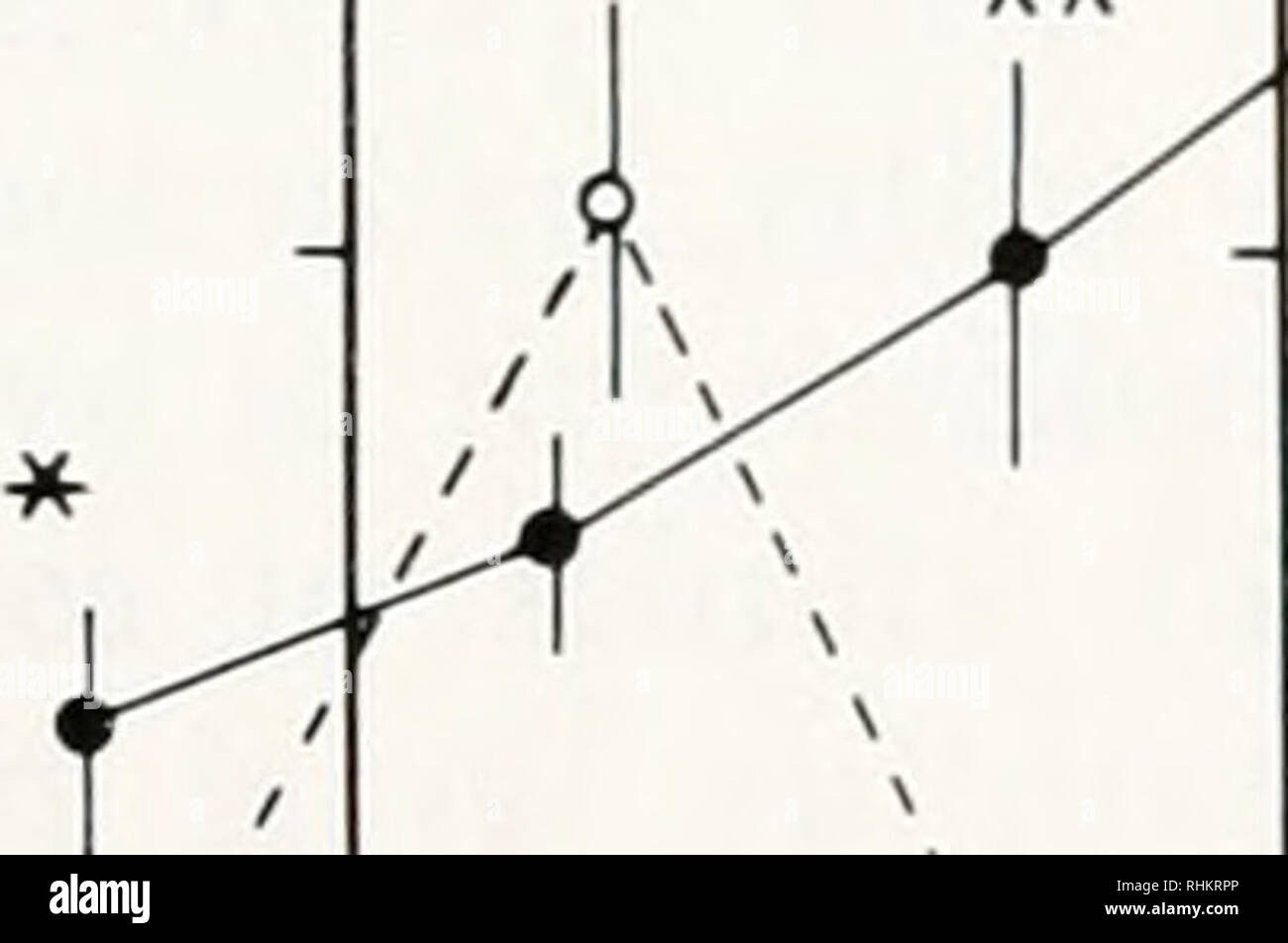 . The Biological bulletin. Biology; Zoology; Biology; Marine Biology. STARVATION AND CRAB LARVAL BEHAVIOR 289 experiment 1 ; this was probably because negative pbototaxis was measured at only one intensity; note in Figure 1 that negative phototaxis was reduced the most at high light intensities. Starvation and swimming speeds The results of experiment 2 were analyzed for swimming speeds as well as phototaxis (Fig. 4). When swimming in the dark was being measured, starved 0 E CD O> CL CT 10 *** B -c •** *-*. Random Swimming *-**. Please note that these images are extracted from scanned page Stock Photohttps://www.alamy.com/image-license-details/?v=1https://www.alamy.com/the-biological-bulletin-biology-zoology-biology-marine-biology-starvation-and-crab-larval-behavior-289-experiment-1-this-was-probably-because-negative-pbototaxis-was-measured-at-only-one-intensity-note-in-figure-1-that-negative-phototaxis-was-reduced-the-most-at-high-light-intensities-starvation-and-swimming-speeds-the-results-of-experiment-2-were-analyzed-for-swimming-speeds-as-well-as-phototaxis-fig-4-when-swimming-in-the-dark-was-being-measured-starved-0-e-cd-ogt-cl-ct-10-b-c-random-swimming-please-note-that-these-images-are-extracted-from-scanned-page-image234619694.html
. The Biological bulletin. Biology; Zoology; Biology; Marine Biology. STARVATION AND CRAB LARVAL BEHAVIOR 289 experiment 1 ; this was probably because negative pbototaxis was measured at only one intensity; note in Figure 1 that negative phototaxis was reduced the most at high light intensities. Starvation and swimming speeds The results of experiment 2 were analyzed for swimming speeds as well as phototaxis (Fig. 4). When swimming in the dark was being measured, starved 0 E CD O> CL CT 10 *** B -c •** *-*. Random Swimming *-**. Please note that these images are extracted from scanned page Stock Photohttps://www.alamy.com/image-license-details/?v=1https://www.alamy.com/the-biological-bulletin-biology-zoology-biology-marine-biology-starvation-and-crab-larval-behavior-289-experiment-1-this-was-probably-because-negative-pbototaxis-was-measured-at-only-one-intensity-note-in-figure-1-that-negative-phototaxis-was-reduced-the-most-at-high-light-intensities-starvation-and-swimming-speeds-the-results-of-experiment-2-were-analyzed-for-swimming-speeds-as-well-as-phototaxis-fig-4-when-swimming-in-the-dark-was-being-measured-starved-0-e-cd-ogt-cl-ct-10-b-c-random-swimming-please-note-that-these-images-are-extracted-from-scanned-page-image234619694.htmlRMRHKRPP–. The Biological bulletin. Biology; Zoology; Biology; Marine Biology. STARVATION AND CRAB LARVAL BEHAVIOR 289 experiment 1 ; this was probably because negative pbototaxis was measured at only one intensity; note in Figure 1 that negative phototaxis was reduced the most at high light intensities. Starvation and swimming speeds The results of experiment 2 were analyzed for swimming speeds as well as phototaxis (Fig. 4). When swimming in the dark was being measured, starved 0 E CD O> CL CT 10 *** B -c •** *-*. Random Swimming *-**. Please note that these images are extracted from scanned page
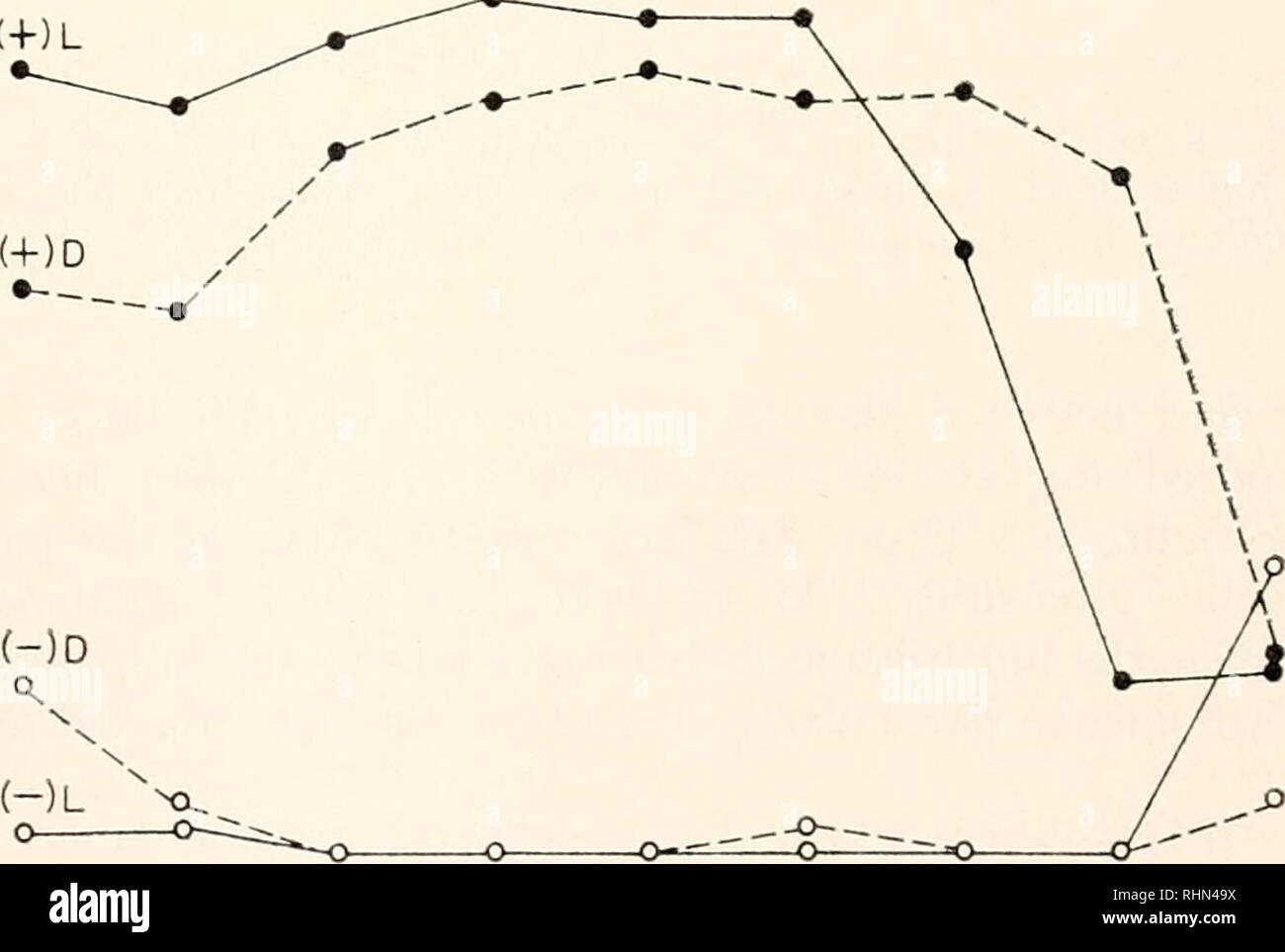 . The Biological bulletin. Biology; Zoology; Biology; Marine Biology. PHOTOTAXIS OF UNIONICOLA 603 animals probably represent the truer spectral sensitivity curves. Since 500 nm light evoked significant responses during all spectral sensitivity tests, this wave- length was used to determine the phototactic responses of mites to different intensities. Figure 3 depicts the intensity-dependent phototaxis to 500 nm of light- and dark-adapted animals tested in APW containing no host homogenate. No sig- nificant (P > 0.05) negative phototaxis occurred in any experiment in which host homogenate wa Stock Photohttps://www.alamy.com/image-license-details/?v=1https://www.alamy.com/the-biological-bulletin-biology-zoology-biology-marine-biology-phototaxis-of-unionicola-603-animals-probably-represent-the-truer-spectral-sensitivity-curves-since-500-nm-light-evoked-significant-responses-during-all-spectral-sensitivity-tests-this-wave-length-was-used-to-determine-the-phototactic-responses-of-mites-to-different-intensities-figure-3-depicts-the-intensity-dependent-phototaxis-to-500-nm-of-light-and-dark-adapted-animals-tested-in-apw-containing-no-host-homogenate-no-sig-nificant-p-gt-005-negative-phototaxis-occurred-in-any-experiment-in-which-host-homogenate-wa-image234648342.html
. The Biological bulletin. Biology; Zoology; Biology; Marine Biology. PHOTOTAXIS OF UNIONICOLA 603 animals probably represent the truer spectral sensitivity curves. Since 500 nm light evoked significant responses during all spectral sensitivity tests, this wave- length was used to determine the phototactic responses of mites to different intensities. Figure 3 depicts the intensity-dependent phototaxis to 500 nm of light- and dark-adapted animals tested in APW containing no host homogenate. No sig- nificant (P > 0.05) negative phototaxis occurred in any experiment in which host homogenate wa Stock Photohttps://www.alamy.com/image-license-details/?v=1https://www.alamy.com/the-biological-bulletin-biology-zoology-biology-marine-biology-phototaxis-of-unionicola-603-animals-probably-represent-the-truer-spectral-sensitivity-curves-since-500-nm-light-evoked-significant-responses-during-all-spectral-sensitivity-tests-this-wave-length-was-used-to-determine-the-phototactic-responses-of-mites-to-different-intensities-figure-3-depicts-the-intensity-dependent-phototaxis-to-500-nm-of-light-and-dark-adapted-animals-tested-in-apw-containing-no-host-homogenate-no-sig-nificant-p-gt-005-negative-phototaxis-occurred-in-any-experiment-in-which-host-homogenate-wa-image234648342.htmlRMRHN49X–. The Biological bulletin. Biology; Zoology; Biology; Marine Biology. PHOTOTAXIS OF UNIONICOLA 603 animals probably represent the truer spectral sensitivity curves. Since 500 nm light evoked significant responses during all spectral sensitivity tests, this wave- length was used to determine the phototactic responses of mites to different intensities. Figure 3 depicts the intensity-dependent phototaxis to 500 nm of light- and dark-adapted animals tested in APW containing no host homogenate. No sig- nificant (P > 0.05) negative phototaxis occurred in any experiment in which host homogenate wa
 . The Biological bulletin. Biology; Zoology; Biology; Marine Biology. EYE AND CNS IN SAGITTA PHOTOTAXIS 89. f. Please note that these images are extracted from scanned page images that may have been digitally enhanced for readability - coloration and appearance of these illustrations may not perfectly resemble the original work.. Marine Biological Laboratory (Woods Hole, Mass. ); Marine Biological Laboratory (Woods Hole, Mass. ). Annual report 1907/08-1952; Lillie, Frank Rattray, 1870-1947; Moore, Carl Richard, 1892-; Redfield, Alfred Clarence, 1890-1983. Woods Hole, Mass. : Marine Biological Stock Photohttps://www.alamy.com/image-license-details/?v=1https://www.alamy.com/the-biological-bulletin-biology-zoology-biology-marine-biology-eye-and-cns-in-sagitta-phototaxis-89-f-please-note-that-these-images-are-extracted-from-scanned-page-images-that-may-have-been-digitally-enhanced-for-readability-coloration-and-appearance-of-these-illustrations-may-not-perfectly-resemble-the-original-work-marine-biological-laboratory-woods-hole-mass-marine-biological-laboratory-woods-hole-mass-annual-report-190708-1952-lillie-frank-rattray-1870-1947-moore-carl-richard-1892-redfield-alfred-clarence-1890-1983-woods-hole-mass-marine-biological-image234647843.html
. The Biological bulletin. Biology; Zoology; Biology; Marine Biology. EYE AND CNS IN SAGITTA PHOTOTAXIS 89. f. Please note that these images are extracted from scanned page images that may have been digitally enhanced for readability - coloration and appearance of these illustrations may not perfectly resemble the original work.. Marine Biological Laboratory (Woods Hole, Mass. ); Marine Biological Laboratory (Woods Hole, Mass. ). Annual report 1907/08-1952; Lillie, Frank Rattray, 1870-1947; Moore, Carl Richard, 1892-; Redfield, Alfred Clarence, 1890-1983. Woods Hole, Mass. : Marine Biological Stock Photohttps://www.alamy.com/image-license-details/?v=1https://www.alamy.com/the-biological-bulletin-biology-zoology-biology-marine-biology-eye-and-cns-in-sagitta-phototaxis-89-f-please-note-that-these-images-are-extracted-from-scanned-page-images-that-may-have-been-digitally-enhanced-for-readability-coloration-and-appearance-of-these-illustrations-may-not-perfectly-resemble-the-original-work-marine-biological-laboratory-woods-hole-mass-marine-biological-laboratory-woods-hole-mass-annual-report-190708-1952-lillie-frank-rattray-1870-1947-moore-carl-richard-1892-redfield-alfred-clarence-1890-1983-woods-hole-mass-marine-biological-image234647843.htmlRMRHN3M3–. The Biological bulletin. Biology; Zoology; Biology; Marine Biology. EYE AND CNS IN SAGITTA PHOTOTAXIS 89. f. Please note that these images are extracted from scanned page images that may have been digitally enhanced for readability - coloration and appearance of these illustrations may not perfectly resemble the original work.. Marine Biological Laboratory (Woods Hole, Mass. ); Marine Biological Laboratory (Woods Hole, Mass. ). Annual report 1907/08-1952; Lillie, Frank Rattray, 1870-1947; Moore, Carl Richard, 1892-; Redfield, Alfred Clarence, 1890-1983. Woods Hole, Mass. : Marine Biological
 . The Biological bulletin. Biology; Zoology; Biology; Marine Biology. 204 COLE. [VOL. II. at first, it soon gets out of direct orientation and then turns around the shortest way, as in the first case. Pallene shows even a more marked positive phototaxis than Anoplodactylus. If the light comes in nearly horizontally, it usually tilts over to an angle of about ninety degrees, or until the body is nearly perpendicular to the bottom, and moves quickly towards the light by a rapid movement of the legs. Pallene is much the better swimmer of the two and seldom moves along the bottom in the manner des Stock Photohttps://www.alamy.com/image-license-details/?v=1https://www.alamy.com/the-biological-bulletin-biology-zoology-biology-marine-biology-204-cole-vol-ii-at-first-it-soon-gets-out-of-direct-orientation-and-then-turns-around-the-shortest-way-as-in-the-first-case-pallene-shows-even-a-more-marked-positive-phototaxis-than-anoplodactylus-if-the-light-comes-in-nearly-horizontally-it-usually-tilts-over-to-an-angle-of-about-ninety-degrees-or-until-the-body-is-nearly-perpendicular-to-the-bottom-and-moves-quickly-towards-the-light-by-a-rapid-movement-of-the-legs-pallene-is-much-the-better-swimmer-of-the-two-and-seldom-moves-along-the-bottom-in-the-manner-des-image234677339.html
. The Biological bulletin. Biology; Zoology; Biology; Marine Biology. 204 COLE. [VOL. II. at first, it soon gets out of direct orientation and then turns around the shortest way, as in the first case. Pallene shows even a more marked positive phototaxis than Anoplodactylus. If the light comes in nearly horizontally, it usually tilts over to an angle of about ninety degrees, or until the body is nearly perpendicular to the bottom, and moves quickly towards the light by a rapid movement of the legs. Pallene is much the better swimmer of the two and seldom moves along the bottom in the manner des Stock Photohttps://www.alamy.com/image-license-details/?v=1https://www.alamy.com/the-biological-bulletin-biology-zoology-biology-marine-biology-204-cole-vol-ii-at-first-it-soon-gets-out-of-direct-orientation-and-then-turns-around-the-shortest-way-as-in-the-first-case-pallene-shows-even-a-more-marked-positive-phototaxis-than-anoplodactylus-if-the-light-comes-in-nearly-horizontally-it-usually-tilts-over-to-an-angle-of-about-ninety-degrees-or-until-the-body-is-nearly-perpendicular-to-the-bottom-and-moves-quickly-towards-the-light-by-a-rapid-movement-of-the-legs-pallene-is-much-the-better-swimmer-of-the-two-and-seldom-moves-along-the-bottom-in-the-manner-des-image234677339.htmlRMRHPD9F–. The Biological bulletin. Biology; Zoology; Biology; Marine Biology. 204 COLE. [VOL. II. at first, it soon gets out of direct orientation and then turns around the shortest way, as in the first case. Pallene shows even a more marked positive phototaxis than Anoplodactylus. If the light comes in nearly horizontally, it usually tilts over to an angle of about ninety degrees, or until the body is nearly perpendicular to the bottom, and moves quickly towards the light by a rapid movement of the legs. Pallene is much the better swimmer of the two and seldom moves along the bottom in the manner des
 . The Biological bulletin. Biology; Zoology; Biology; Marine Biology. 310 J. H. COHEN AND R. B. FORWARD iors from one another; therefore it was necessary to analyze different aspects of swimming behavior for each species. For Calaropia americana, which was strongly phototactic, positive phototaxis was analyzed. The mean angular direc- tion of movement in the AY-plane for copepods in the field of view (—25 individuals) was determined from digitized video recordings using CellTrak software. Only animals that oriented in a significant direction were used for analysis (Rayleigh's c, a = 0.01). The Stock Photohttps://www.alamy.com/image-license-details/?v=1https://www.alamy.com/the-biological-bulletin-biology-zoology-biology-marine-biology-310-j-h-cohen-and-r-b-forward-iors-from-one-another-therefore-it-was-necessary-to-analyze-different-aspects-of-swimming-behavior-for-each-species-for-calaropia-americana-which-was-strongly-phototactic-positive-phototaxis-was-analyzed-the-mean-angular-direc-tion-of-movement-in-the-ay-plane-for-copepods-in-the-field-of-view-25-individuals-was-determined-from-digitized-video-recordings-using-celltrak-software-only-animals-that-oriented-in-a-significant-direction-were-used-for-analysis-rayleighs-c-a-=-001-the-image234629434.html
. The Biological bulletin. Biology; Zoology; Biology; Marine Biology. 310 J. H. COHEN AND R. B. FORWARD iors from one another; therefore it was necessary to analyze different aspects of swimming behavior for each species. For Calaropia americana, which was strongly phototactic, positive phototaxis was analyzed. The mean angular direc- tion of movement in the AY-plane for copepods in the field of view (—25 individuals) was determined from digitized video recordings using CellTrak software. Only animals that oriented in a significant direction were used for analysis (Rayleigh's c, a = 0.01). The Stock Photohttps://www.alamy.com/image-license-details/?v=1https://www.alamy.com/the-biological-bulletin-biology-zoology-biology-marine-biology-310-j-h-cohen-and-r-b-forward-iors-from-one-another-therefore-it-was-necessary-to-analyze-different-aspects-of-swimming-behavior-for-each-species-for-calaropia-americana-which-was-strongly-phototactic-positive-phototaxis-was-analyzed-the-mean-angular-direc-tion-of-movement-in-the-ay-plane-for-copepods-in-the-field-of-view-25-individuals-was-determined-from-digitized-video-recordings-using-celltrak-software-only-animals-that-oriented-in-a-significant-direction-were-used-for-analysis-rayleighs-c-a-=-001-the-image234629434.htmlRMRHM86J–. The Biological bulletin. Biology; Zoology; Biology; Marine Biology. 310 J. H. COHEN AND R. B. FORWARD iors from one another; therefore it was necessary to analyze different aspects of swimming behavior for each species. For Calaropia americana, which was strongly phototactic, positive phototaxis was analyzed. The mean angular direc- tion of movement in the AY-plane for copepods in the field of view (—25 individuals) was determined from digitized video recordings using CellTrak software. Only animals that oriented in a significant direction were used for analysis (Rayleigh's c, a = 0.01). The
 . The Biological bulletin. Biology; Zoology; Biology; Marine Biology. Random Swimming *-**. Positive Phototaxis. Please note that these images are extracted from scanned page images that may have been digitally enhanced for readability - coloration and appearance of these illustrations may not perfectly resemble the original work.. Marine Biological Laboratory (Woods Hole, Mass. ); Marine Biological Laboratory (Woods Hole, Mass. ). Annual report 1907/08-1952; Lillie, Frank Rattray, 1870-1947; Moore, Carl Richard, 1892-; Redfield, Alfred Clarence, 1890-1983. Woods Hole, Mass. : Marine Biologica Stock Photohttps://www.alamy.com/image-license-details/?v=1https://www.alamy.com/the-biological-bulletin-biology-zoology-biology-marine-biology-random-swimming-positive-phototaxis-please-note-that-these-images-are-extracted-from-scanned-page-images-that-may-have-been-digitally-enhanced-for-readability-coloration-and-appearance-of-these-illustrations-may-not-perfectly-resemble-the-original-work-marine-biological-laboratory-woods-hole-mass-marine-biological-laboratory-woods-hole-mass-annual-report-190708-1952-lillie-frank-rattray-1870-1947-moore-carl-richard-1892-redfield-alfred-clarence-1890-1983-woods-hole-mass-marine-biologica-image234619681.html
. The Biological bulletin. Biology; Zoology; Biology; Marine Biology. Random Swimming *-**. Positive Phototaxis. Please note that these images are extracted from scanned page images that may have been digitally enhanced for readability - coloration and appearance of these illustrations may not perfectly resemble the original work.. Marine Biological Laboratory (Woods Hole, Mass. ); Marine Biological Laboratory (Woods Hole, Mass. ). Annual report 1907/08-1952; Lillie, Frank Rattray, 1870-1947; Moore, Carl Richard, 1892-; Redfield, Alfred Clarence, 1890-1983. Woods Hole, Mass. : Marine Biologica Stock Photohttps://www.alamy.com/image-license-details/?v=1https://www.alamy.com/the-biological-bulletin-biology-zoology-biology-marine-biology-random-swimming-positive-phototaxis-please-note-that-these-images-are-extracted-from-scanned-page-images-that-may-have-been-digitally-enhanced-for-readability-coloration-and-appearance-of-these-illustrations-may-not-perfectly-resemble-the-original-work-marine-biological-laboratory-woods-hole-mass-marine-biological-laboratory-woods-hole-mass-annual-report-190708-1952-lillie-frank-rattray-1870-1947-moore-carl-richard-1892-redfield-alfred-clarence-1890-1983-woods-hole-mass-marine-biologica-image234619681.htmlRMRHKRP9–. The Biological bulletin. Biology; Zoology; Biology; Marine Biology. Random Swimming *-**. Positive Phototaxis. Please note that these images are extracted from scanned page images that may have been digitally enhanced for readability - coloration and appearance of these illustrations may not perfectly resemble the original work.. Marine Biological Laboratory (Woods Hole, Mass. ); Marine Biological Laboratory (Woods Hole, Mass. ). Annual report 1907/08-1952; Lillie, Frank Rattray, 1870-1947; Moore, Carl Richard, 1892-; Redfield, Alfred Clarence, 1890-1983. Woods Hole, Mass. : Marine Biologica
![. Experimental morphology. Protoplasm; Growth. §4] PHOTOTAXIS AND PHOTOPATHY 185 (Baeanetzki, '76, p. 328, and Stahl, the illuminated region. '84, p. 167.) Baranetzki proceeded as follows: a glass plate was placed in a saucer so that its surface was 2 or 3 mm. below the rim. The plate was covered by filter paper which extended over the rim and here dipped into water, by which means it was kept moist. Over the saucer was laid an opaque cover, blackened below and provided with a narrow slit. The Plasmodium was placed on the filter paper and diffuse daylight was thrown upon the slit by means of a Stock Photo . Experimental morphology. Protoplasm; Growth. §4] PHOTOTAXIS AND PHOTOPATHY 185 (Baeanetzki, '76, p. 328, and Stahl, the illuminated region. '84, p. 167.) Baranetzki proceeded as follows: a glass plate was placed in a saucer so that its surface was 2 or 3 mm. below the rim. The plate was covered by filter paper which extended over the rim and here dipped into water, by which means it was kept moist. Over the saucer was laid an opaque cover, blackened below and provided with a narrow slit. The Plasmodium was placed on the filter paper and diffuse daylight was thrown upon the slit by means of a Stock Photo](https://c8.alamy.com/comp/RE0C5C/experimental-morphology-protoplasm-growth-4-phototaxis-and-photopathy-185-baeanetzki-76-p-328-and-stahl-the-illuminated-region-84-p-167-baranetzki-proceeded-as-follows-a-glass-plate-was-placed-in-a-saucer-so-that-its-surface-was-2-or-3-mm-below-the-rim-the-plate-was-covered-by-filter-paper-which-extended-over-the-rim-and-here-dipped-into-water-by-which-means-it-was-kept-moist-over-the-saucer-was-laid-an-opaque-cover-blackened-below-and-provided-with-a-narrow-slit-the-plasmodium-was-placed-on-the-filter-paper-and-diffuse-daylight-was-thrown-upon-the-slit-by-means-of-a-RE0C5C.jpg) . Experimental morphology. Protoplasm; Growth. §4] PHOTOTAXIS AND PHOTOPATHY 185 (Baeanetzki, '76, p. 328, and Stahl, the illuminated region. '84, p. 167.) Baranetzki proceeded as follows: a glass plate was placed in a saucer so that its surface was 2 or 3 mm. below the rim. The plate was covered by filter paper which extended over the rim and here dipped into water, by which means it was kept moist. Over the saucer was laid an opaque cover, blackened below and provided with a narrow slit. The Plasmodium was placed on the filter paper and diffuse daylight was thrown upon the slit by means of a Stock Photohttps://www.alamy.com/image-license-details/?v=1https://www.alamy.com/experimental-morphology-protoplasm-growth-4-phototaxis-and-photopathy-185-baeanetzki-76-p-328-and-stahl-the-illuminated-region-84-p-167-baranetzki-proceeded-as-follows-a-glass-plate-was-placed-in-a-saucer-so-that-its-surface-was-2-or-3-mm-below-the-rim-the-plate-was-covered-by-filter-paper-which-extended-over-the-rim-and-here-dipped-into-water-by-which-means-it-was-kept-moist-over-the-saucer-was-laid-an-opaque-cover-blackened-below-and-provided-with-a-narrow-slit-the-plasmodium-was-placed-on-the-filter-paper-and-diffuse-daylight-was-thrown-upon-the-slit-by-means-of-a-image232349528.html
. Experimental morphology. Protoplasm; Growth. §4] PHOTOTAXIS AND PHOTOPATHY 185 (Baeanetzki, '76, p. 328, and Stahl, the illuminated region. '84, p. 167.) Baranetzki proceeded as follows: a glass plate was placed in a saucer so that its surface was 2 or 3 mm. below the rim. The plate was covered by filter paper which extended over the rim and here dipped into water, by which means it was kept moist. Over the saucer was laid an opaque cover, blackened below and provided with a narrow slit. The Plasmodium was placed on the filter paper and diffuse daylight was thrown upon the slit by means of a Stock Photohttps://www.alamy.com/image-license-details/?v=1https://www.alamy.com/experimental-morphology-protoplasm-growth-4-phototaxis-and-photopathy-185-baeanetzki-76-p-328-and-stahl-the-illuminated-region-84-p-167-baranetzki-proceeded-as-follows-a-glass-plate-was-placed-in-a-saucer-so-that-its-surface-was-2-or-3-mm-below-the-rim-the-plate-was-covered-by-filter-paper-which-extended-over-the-rim-and-here-dipped-into-water-by-which-means-it-was-kept-moist-over-the-saucer-was-laid-an-opaque-cover-blackened-below-and-provided-with-a-narrow-slit-the-plasmodium-was-placed-on-the-filter-paper-and-diffuse-daylight-was-thrown-upon-the-slit-by-means-of-a-image232349528.htmlRMRE0C5C–. Experimental morphology. Protoplasm; Growth. §4] PHOTOTAXIS AND PHOTOPATHY 185 (Baeanetzki, '76, p. 328, and Stahl, the illuminated region. '84, p. 167.) Baranetzki proceeded as follows: a glass plate was placed in a saucer so that its surface was 2 or 3 mm. below the rim. The plate was covered by filter paper which extended over the rim and here dipped into water, by which means it was kept moist. Over the saucer was laid an opaque cover, blackened below and provided with a narrow slit. The Plasmodium was placed on the filter paper and diffuse daylight was thrown upon the slit by means of a
 . The Biological bulletin. Biology; Zoology; Biology; Marine Biology. Positive Phototaxis Starved. Please note that these images are extracted from scanned page images that may have been digitally enhanced for readability - coloration and appearance of these illustrations may not perfectly resemble the original work.. Marine Biological Laboratory (Woods Hole, Mass. ); Marine Biological Laboratory (Woods Hole, Mass. ). Annual report 1907/08-1952; Lillie, Frank Rattray, 1870-1947; Moore, Carl Richard, 1892-; Redfield, Alfred Clarence, 1890-1983. Woods Hole, Mass. : Marine Biological Laboratory Stock Photohttps://www.alamy.com/image-license-details/?v=1https://www.alamy.com/the-biological-bulletin-biology-zoology-biology-marine-biology-positive-phototaxis-starved-please-note-that-these-images-are-extracted-from-scanned-page-images-that-may-have-been-digitally-enhanced-for-readability-coloration-and-appearance-of-these-illustrations-may-not-perfectly-resemble-the-original-work-marine-biological-laboratory-woods-hole-mass-marine-biological-laboratory-woods-hole-mass-annual-report-190708-1952-lillie-frank-rattray-1870-1947-moore-carl-richard-1892-redfield-alfred-clarence-1890-1983-woods-hole-mass-marine-biological-laboratory-image234619731.html
. The Biological bulletin. Biology; Zoology; Biology; Marine Biology. Positive Phototaxis Starved. Please note that these images are extracted from scanned page images that may have been digitally enhanced for readability - coloration and appearance of these illustrations may not perfectly resemble the original work.. Marine Biological Laboratory (Woods Hole, Mass. ); Marine Biological Laboratory (Woods Hole, Mass. ). Annual report 1907/08-1952; Lillie, Frank Rattray, 1870-1947; Moore, Carl Richard, 1892-; Redfield, Alfred Clarence, 1890-1983. Woods Hole, Mass. : Marine Biological Laboratory Stock Photohttps://www.alamy.com/image-license-details/?v=1https://www.alamy.com/the-biological-bulletin-biology-zoology-biology-marine-biology-positive-phototaxis-starved-please-note-that-these-images-are-extracted-from-scanned-page-images-that-may-have-been-digitally-enhanced-for-readability-coloration-and-appearance-of-these-illustrations-may-not-perfectly-resemble-the-original-work-marine-biological-laboratory-woods-hole-mass-marine-biological-laboratory-woods-hole-mass-annual-report-190708-1952-lillie-frank-rattray-1870-1947-moore-carl-richard-1892-redfield-alfred-clarence-1890-1983-woods-hole-mass-marine-biological-laboratory-image234619731.htmlRMRHKRT3–. The Biological bulletin. Biology; Zoology; Biology; Marine Biology. Positive Phototaxis Starved. Please note that these images are extracted from scanned page images that may have been digitally enhanced for readability - coloration and appearance of these illustrations may not perfectly resemble the original work.. Marine Biological Laboratory (Woods Hole, Mass. ); Marine Biological Laboratory (Woods Hole, Mass. ). Annual report 1907/08-1952; Lillie, Frank Rattray, 1870-1947; Moore, Carl Richard, 1892-; Redfield, Alfred Clarence, 1890-1983. Woods Hole, Mass. : Marine Biological Laboratory
 . Annotationes zoologicae japonenses / Nihon do?butsugaku iho?. NEGATIVE PHOTOTAXIS ETC. OF Littovina. 15 Sept. 1, 8 : 30 A.m. Another bigli and low tide daring the interval. Individuals scattered but still more or less near the original area. One about two feet from it. I will conclude with another experiment :— There is a large rock lying near the landing place of our laboratory. When the tide was at the level of the dotted line (See Fig. 6.), I placed some individuals of L. exigua which were known to be negatively phototaxic at the spot A of this rock a little below the water line. The spot Stock Photohttps://www.alamy.com/image-license-details/?v=1https://www.alamy.com/annotationes-zoologicae-japonenses-nihon-dobutsugaku-iho-negative-phototaxis-etc-of-littovina-15-sept-1-8-30-am-another-bigli-and-low-tide-daring-the-interval-individuals-scattered-but-still-more-or-less-near-the-original-area-one-about-two-feet-from-it-i-will-conclude-with-another-experiment-there-is-a-large-rock-lying-near-the-landing-place-of-our-laboratory-when-the-tide-was-at-the-level-of-the-dotted-line-see-fig-6-i-placed-some-individuals-of-l-exigua-which-were-known-to-be-negatively-phototaxic-at-the-spot-a-of-this-rock-a-little-below-the-water-line-the-spot-image236393189.html
. Annotationes zoologicae japonenses / Nihon do?butsugaku iho?. NEGATIVE PHOTOTAXIS ETC. OF Littovina. 15 Sept. 1, 8 : 30 A.m. Another bigli and low tide daring the interval. Individuals scattered but still more or less near the original area. One about two feet from it. I will conclude with another experiment :— There is a large rock lying near the landing place of our laboratory. When the tide was at the level of the dotted line (See Fig. 6.), I placed some individuals of L. exigua which were known to be negatively phototaxic at the spot A of this rock a little below the water line. The spot Stock Photohttps://www.alamy.com/image-license-details/?v=1https://www.alamy.com/annotationes-zoologicae-japonenses-nihon-dobutsugaku-iho-negative-phototaxis-etc-of-littovina-15-sept-1-8-30-am-another-bigli-and-low-tide-daring-the-interval-individuals-scattered-but-still-more-or-less-near-the-original-area-one-about-two-feet-from-it-i-will-conclude-with-another-experiment-there-is-a-large-rock-lying-near-the-landing-place-of-our-laboratory-when-the-tide-was-at-the-level-of-the-dotted-line-see-fig-6-i-placed-some-individuals-of-l-exigua-which-were-known-to-be-negatively-phototaxic-at-the-spot-a-of-this-rock-a-little-below-the-water-line-the-spot-image236393189.htmlRMRMGHWW–. Annotationes zoologicae japonenses / Nihon do?butsugaku iho?. NEGATIVE PHOTOTAXIS ETC. OF Littovina. 15 Sept. 1, 8 : 30 A.m. Another bigli and low tide daring the interval. Individuals scattered but still more or less near the original area. One about two feet from it. I will conclude with another experiment :— There is a large rock lying near the landing place of our laboratory. When the tide was at the level of the dotted line (See Fig. 6.), I placed some individuals of L. exigua which were known to be negatively phototaxic at the spot A of this rock a little below the water line. The spot
 . The Biological bulletin. Biology; Zoology; Biology; Marine Biology. 460 470 480 490 WAVELENGTH mmu. 430 450 470 490 WAVELENGTH mmu 510 FIGURE 2. The action spectrum for positive phototaxis as determined by an equal-energies method. The points determining the curve represent the maximum increase in cell numbers (accumulation) following a given stimulus. Inset: The action spectrum for the active spectral region of positive phototaxis. The points determining the curve represent the lowest relative intensity at which maximum orientation was observed during a 10-second stimulation. phototactic re Stock Photohttps://www.alamy.com/image-license-details/?v=1https://www.alamy.com/the-biological-bulletin-biology-zoology-biology-marine-biology-460-470-480-490-wavelength-mmu-430-450-470-490-wavelength-mmu-510-figure-2-the-action-spectrum-for-positive-phototaxis-as-determined-by-an-equal-energies-method-the-points-determining-the-curve-represent-the-maximum-increase-in-cell-numbers-accumulation-following-a-given-stimulus-inset-the-action-spectrum-for-the-active-spectral-region-of-positive-phototaxis-the-points-determining-the-curve-represent-the-lowest-relative-intensity-at-which-maximum-orientation-was-observed-during-a-10-second-stimulation-phototactic-re-image234663881.html
. The Biological bulletin. Biology; Zoology; Biology; Marine Biology. 460 470 480 490 WAVELENGTH mmu. 430 450 470 490 WAVELENGTH mmu 510 FIGURE 2. The action spectrum for positive phototaxis as determined by an equal-energies method. The points determining the curve represent the maximum increase in cell numbers (accumulation) following a given stimulus. Inset: The action spectrum for the active spectral region of positive phototaxis. The points determining the curve represent the lowest relative intensity at which maximum orientation was observed during a 10-second stimulation. phototactic re Stock Photohttps://www.alamy.com/image-license-details/?v=1https://www.alamy.com/the-biological-bulletin-biology-zoology-biology-marine-biology-460-470-480-490-wavelength-mmu-430-450-470-490-wavelength-mmu-510-figure-2-the-action-spectrum-for-positive-phototaxis-as-determined-by-an-equal-energies-method-the-points-determining-the-curve-represent-the-maximum-increase-in-cell-numbers-accumulation-following-a-given-stimulus-inset-the-action-spectrum-for-the-active-spectral-region-of-positive-phototaxis-the-points-determining-the-curve-represent-the-lowest-relative-intensity-at-which-maximum-orientation-was-observed-during-a-10-second-stimulation-phototactic-re-image234663881.htmlRMRHNT4W–. The Biological bulletin. Biology; Zoology; Biology; Marine Biology. 460 470 480 490 WAVELENGTH mmu. 430 450 470 490 WAVELENGTH mmu 510 FIGURE 2. The action spectrum for positive phototaxis as determined by an equal-energies method. The points determining the curve represent the maximum increase in cell numbers (accumulation) following a given stimulus. Inset: The action spectrum for the active spectral region of positive phototaxis. The points determining the curve represent the lowest relative intensity at which maximum orientation was observed during a 10-second stimulation. phototactic re
 . The Biological bulletin. Biology; Zoology; Marine biology. COPEPOD PHOTOTAXIS AND XANTHENES 403 same abnormal movements occurred without a depression of general activity (one experiment). Phototactic responses of Calanopia Calanopia showed phototactism but differed from Paracalanus in its responses. On exposure to a point source of light, individuals swam to and fro continuously, giving a nearly constant number of photopositive and photonegative reactions per unit time. This behavior is expressed as a nearly constant slope in curves of animals showing positive phototaxis (Fig. 1, curve G) an Stock Photohttps://www.alamy.com/image-license-details/?v=1https://www.alamy.com/the-biological-bulletin-biology-zoology-marine-biology-copepod-phototaxis-and-xanthenes-403-same-abnormal-movements-occurred-without-a-depression-of-general-activity-one-experiment-phototactic-responses-of-calanopia-calanopia-showed-phototactism-but-differed-from-paracalanus-in-its-responses-on-exposure-to-a-point-source-of-light-individuals-swam-to-and-fro-continuously-giving-a-nearly-constant-number-of-photopositive-and-photonegative-reactions-per-unit-time-this-behavior-is-expressed-as-a-nearly-constant-slope-in-curves-of-animals-showing-positive-phototaxis-fig-1-curve-g-an-image234624923.html
. The Biological bulletin. Biology; Zoology; Marine biology. COPEPOD PHOTOTAXIS AND XANTHENES 403 same abnormal movements occurred without a depression of general activity (one experiment). Phototactic responses of Calanopia Calanopia showed phototactism but differed from Paracalanus in its responses. On exposure to a point source of light, individuals swam to and fro continuously, giving a nearly constant number of photopositive and photonegative reactions per unit time. This behavior is expressed as a nearly constant slope in curves of animals showing positive phototaxis (Fig. 1, curve G) an Stock Photohttps://www.alamy.com/image-license-details/?v=1https://www.alamy.com/the-biological-bulletin-biology-zoology-marine-biology-copepod-phototaxis-and-xanthenes-403-same-abnormal-movements-occurred-without-a-depression-of-general-activity-one-experiment-phototactic-responses-of-calanopia-calanopia-showed-phototactism-but-differed-from-paracalanus-in-its-responses-on-exposure-to-a-point-source-of-light-individuals-swam-to-and-fro-continuously-giving-a-nearly-constant-number-of-photopositive-and-photonegative-reactions-per-unit-time-this-behavior-is-expressed-as-a-nearly-constant-slope-in-curves-of-animals-showing-positive-phototaxis-fig-1-curve-g-an-image234624923.htmlRMRHM2DF–. The Biological bulletin. Biology; Zoology; Marine biology. COPEPOD PHOTOTAXIS AND XANTHENES 403 same abnormal movements occurred without a depression of general activity (one experiment). Phototactic responses of Calanopia Calanopia showed phototactism but differed from Paracalanus in its responses. On exposure to a point source of light, individuals swam to and fro continuously, giving a nearly constant number of photopositive and photonegative reactions per unit time. This behavior is expressed as a nearly constant slope in curves of animals showing positive phototaxis (Fig. 1, curve G) an
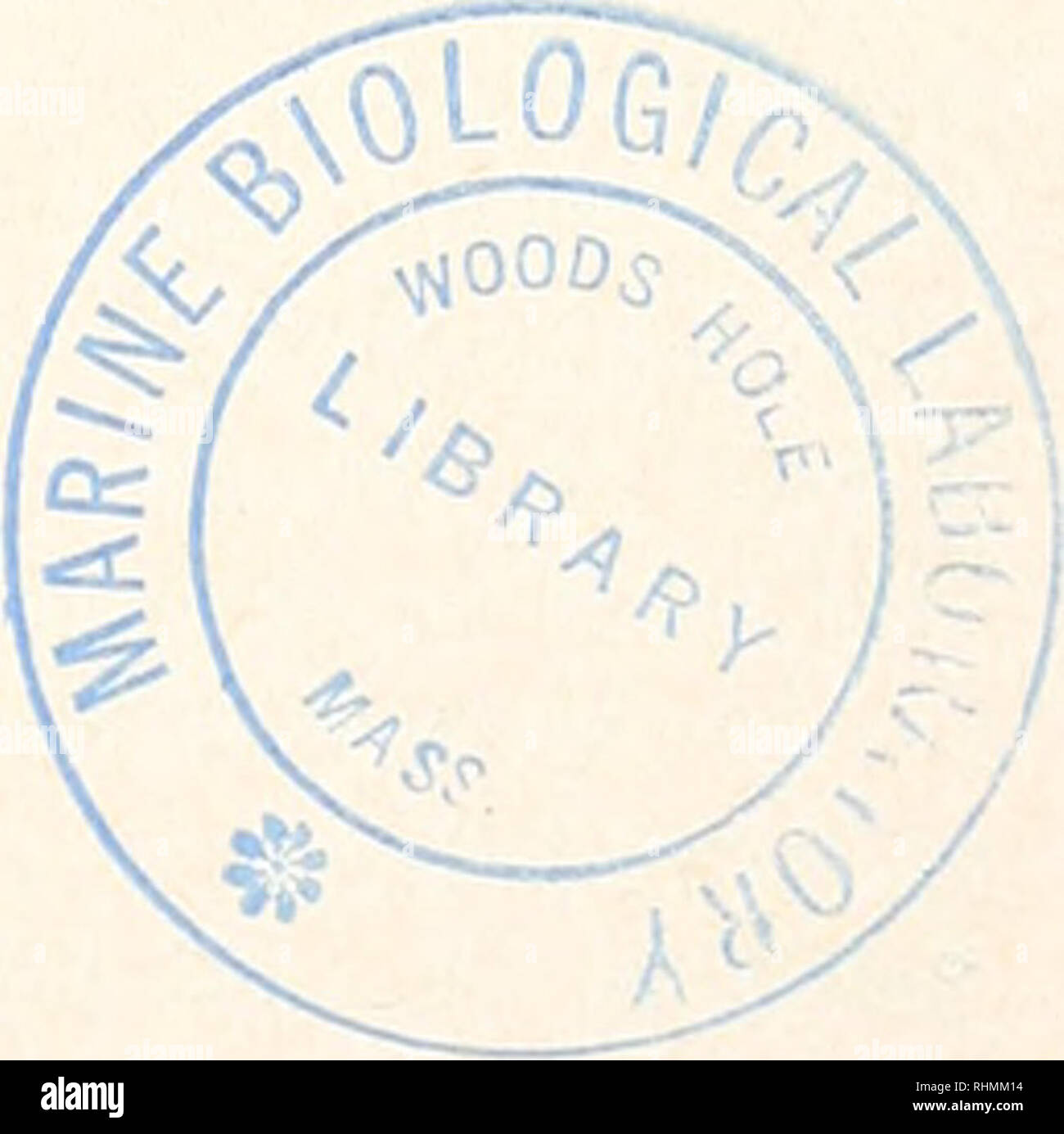 . The Biological bulletin. Biology; Zoology; Biology; Marine Biology. GENETIC INFLUENCE ON PHOTOTAXIS DUKKWACIITER, (i., 1957. Unterschuiigen liber Phototaxis und Geotaxis cinigcr Drosophila— Mutanten narli Aufxucht in vcrschiedenen Lichtbedingungen. Zcitschr. Tier psychologic, 14: 1-28. ERLENMEYER-KIMLING, L., AND J. HIKSCII, 1%1. Measurement of the- relations between chromosomes and behavior. Science. 134: 1068-1069. FAKDOX, J. C., M. J. CARROLL AND V. A. STLLIVAN, 1937. Reflection spectra of eye pigment in I >rt>st>pliilti inclaiini/astcr and its mutants. Stud. Instil. Dri-. Thoin Stock Photohttps://www.alamy.com/image-license-details/?v=1https://www.alamy.com/the-biological-bulletin-biology-zoology-biology-marine-biology-genetic-influence-on-phototaxis-dukkwaciiter-i-1957-unterschuiigen-liber-phototaxis-und-geotaxis-cinigcr-drosophila-mutanten-narli-aufxucht-in-vcrschiedenen-lichtbedingungen-zcitschr-tier-psychologic-14-1-28-erlenmeyer-kimling-l-and-j-hikscii-11-measurement-of-the-relations-between-chromosomes-and-behavior-science-134-1068-1069-fakdox-j-c-m-j-carroll-and-v-a-stllivan-1937-reflection-spectra-of-eye-pigment-in-i-gtrtgtstgtpliilti-inclaiiniastcr-and-its-mutants-stud-instil-dri-thoin-image234638688.html
. The Biological bulletin. Biology; Zoology; Biology; Marine Biology. GENETIC INFLUENCE ON PHOTOTAXIS DUKKWACIITER, (i., 1957. Unterschuiigen liber Phototaxis und Geotaxis cinigcr Drosophila— Mutanten narli Aufxucht in vcrschiedenen Lichtbedingungen. Zcitschr. Tier psychologic, 14: 1-28. ERLENMEYER-KIMLING, L., AND J. HIKSCII, 1%1. Measurement of the- relations between chromosomes and behavior. Science. 134: 1068-1069. FAKDOX, J. C., M. J. CARROLL AND V. A. STLLIVAN, 1937. Reflection spectra of eye pigment in I >rt>st>pliilti inclaiini/astcr and its mutants. Stud. Instil. Dri-. Thoin Stock Photohttps://www.alamy.com/image-license-details/?v=1https://www.alamy.com/the-biological-bulletin-biology-zoology-biology-marine-biology-genetic-influence-on-phototaxis-dukkwaciiter-i-1957-unterschuiigen-liber-phototaxis-und-geotaxis-cinigcr-drosophila-mutanten-narli-aufxucht-in-vcrschiedenen-lichtbedingungen-zcitschr-tier-psychologic-14-1-28-erlenmeyer-kimling-l-and-j-hikscii-11-measurement-of-the-relations-between-chromosomes-and-behavior-science-134-1068-1069-fakdox-j-c-m-j-carroll-and-v-a-stllivan-1937-reflection-spectra-of-eye-pigment-in-i-gtrtgtstgtpliilti-inclaiiniastcr-and-its-mutants-stud-instil-dri-thoin-image234638688.htmlRMRHMM14–. The Biological bulletin. Biology; Zoology; Biology; Marine Biology. GENETIC INFLUENCE ON PHOTOTAXIS DUKKWACIITER, (i., 1957. Unterschuiigen liber Phototaxis und Geotaxis cinigcr Drosophila— Mutanten narli Aufxucht in vcrschiedenen Lichtbedingungen. Zcitschr. Tier psychologic, 14: 1-28. ERLENMEYER-KIMLING, L., AND J. HIKSCII, 1%1. Measurement of the- relations between chromosomes and behavior. Science. 134: 1068-1069. FAKDOX, J. C., M. J. CARROLL AND V. A. STLLIVAN, 1937. Reflection spectra of eye pigment in I >rt>st>pliilti inclaiini/astcr and its mutants. Stud. Instil. Dri-. Thoin
 . The Biological bulletin. Biology; Zoology; Biology; Marine Biology. per 2 per 4+ mt-. 0 0.1 0.2 0.3 CYCLOHEXIMIDE (jig/ml) FIGURE 3. Period lengthening effects of cycloheximide on the wild type mt- and the mutants per 2 mt— and per 4 mt+. The local anesthetics, procaine, tetracaine and dibucaine had no effect on the rhythm when tested at concentrations 1/3, 1/10 and 1/30 times the minimum values that inhibited phototaxis. DISCUSSION Inhibitors of transcription and translation Our survey of the effects of inhibitors of transcription and translation on the Chlamydomonas rhythm support the gene Stock Photohttps://www.alamy.com/image-license-details/?v=1https://www.alamy.com/the-biological-bulletin-biology-zoology-biology-marine-biology-per-2-per-4-mt-0-01-02-03-cycloheximide-jigml-figure-3-period-lengthening-effects-of-cycloheximide-on-the-wild-type-mt-and-the-mutants-per-2-mt-and-per-4-mt-the-local-anesthetics-procaine-tetracaine-and-dibucaine-had-no-effect-on-the-rhythm-when-tested-at-concentrations-13-110-and-130-times-the-minimum-values-that-inhibited-phototaxis-discussion-inhibitors-of-transcription-and-translation-our-survey-of-the-effects-of-inhibitors-of-transcription-and-translation-on-the-chlamydomonas-rhythm-support-the-gene-image234619597.html
. The Biological bulletin. Biology; Zoology; Biology; Marine Biology. per 2 per 4+ mt-. 0 0.1 0.2 0.3 CYCLOHEXIMIDE (jig/ml) FIGURE 3. Period lengthening effects of cycloheximide on the wild type mt- and the mutants per 2 mt— and per 4 mt+. The local anesthetics, procaine, tetracaine and dibucaine had no effect on the rhythm when tested at concentrations 1/3, 1/10 and 1/30 times the minimum values that inhibited phototaxis. DISCUSSION Inhibitors of transcription and translation Our survey of the effects of inhibitors of transcription and translation on the Chlamydomonas rhythm support the gene Stock Photohttps://www.alamy.com/image-license-details/?v=1https://www.alamy.com/the-biological-bulletin-biology-zoology-biology-marine-biology-per-2-per-4-mt-0-01-02-03-cycloheximide-jigml-figure-3-period-lengthening-effects-of-cycloheximide-on-the-wild-type-mt-and-the-mutants-per-2-mt-and-per-4-mt-the-local-anesthetics-procaine-tetracaine-and-dibucaine-had-no-effect-on-the-rhythm-when-tested-at-concentrations-13-110-and-130-times-the-minimum-values-that-inhibited-phototaxis-discussion-inhibitors-of-transcription-and-translation-our-survey-of-the-effects-of-inhibitors-of-transcription-and-translation-on-the-chlamydomonas-rhythm-support-the-gene-image234619597.htmlRMRHKRK9–. The Biological bulletin. Biology; Zoology; Biology; Marine Biology. per 2 per 4+ mt-. 0 0.1 0.2 0.3 CYCLOHEXIMIDE (jig/ml) FIGURE 3. Period lengthening effects of cycloheximide on the wild type mt- and the mutants per 2 mt— and per 4 mt+. The local anesthetics, procaine, tetracaine and dibucaine had no effect on the rhythm when tested at concentrations 1/3, 1/10 and 1/30 times the minimum values that inhibited phototaxis. DISCUSSION Inhibitors of transcription and translation Our survey of the effects of inhibitors of transcription and translation on the Chlamydomonas rhythm support the gene
 . The Biological bulletin. Biology; Zoology; Biology; Marine Biology. ARROW WORM PHOTOTAXIS 427 100 100. 100. Please note that these images are extracted from scanned page images that may have been digitally enhanced for readability - coloration and appearance of these illustrations may not perfectly resemble the original work.. Marine Biological Laboratory (Woods Hole, Mass. ); Marine Biological Laboratory (Woods Hole, Mass. ). Annual report 1907/08-1952; Lillie, Frank Rattray, 1870-1947; Moore, Carl Richard, 1892-; Redfield, Alfred Clarence, 1890-1983. Woods Hole, Mass. : Marine Biological L Stock Photohttps://www.alamy.com/image-license-details/?v=1https://www.alamy.com/the-biological-bulletin-biology-zoology-biology-marine-biology-arrow-worm-phototaxis-427-100-100-100-please-note-that-these-images-are-extracted-from-scanned-page-images-that-may-have-been-digitally-enhanced-for-readability-coloration-and-appearance-of-these-illustrations-may-not-perfectly-resemble-the-original-work-marine-biological-laboratory-woods-hole-mass-marine-biological-laboratory-woods-hole-mass-annual-report-190708-1952-lillie-frank-rattray-1870-1947-moore-carl-richard-1892-redfield-alfred-clarence-1890-1983-woods-hole-mass-marine-biological-l-image234646526.html
. The Biological bulletin. Biology; Zoology; Biology; Marine Biology. ARROW WORM PHOTOTAXIS 427 100 100. 100. Please note that these images are extracted from scanned page images that may have been digitally enhanced for readability - coloration and appearance of these illustrations may not perfectly resemble the original work.. Marine Biological Laboratory (Woods Hole, Mass. ); Marine Biological Laboratory (Woods Hole, Mass. ). Annual report 1907/08-1952; Lillie, Frank Rattray, 1870-1947; Moore, Carl Richard, 1892-; Redfield, Alfred Clarence, 1890-1983. Woods Hole, Mass. : Marine Biological L Stock Photohttps://www.alamy.com/image-license-details/?v=1https://www.alamy.com/the-biological-bulletin-biology-zoology-biology-marine-biology-arrow-worm-phototaxis-427-100-100-100-please-note-that-these-images-are-extracted-from-scanned-page-images-that-may-have-been-digitally-enhanced-for-readability-coloration-and-appearance-of-these-illustrations-may-not-perfectly-resemble-the-original-work-marine-biological-laboratory-woods-hole-mass-marine-biological-laboratory-woods-hole-mass-annual-report-190708-1952-lillie-frank-rattray-1870-1947-moore-carl-richard-1892-redfield-alfred-clarence-1890-1983-woods-hole-mass-marine-biological-l-image234646526.htmlRMRHN212–. The Biological bulletin. Biology; Zoology; Biology; Marine Biology. ARROW WORM PHOTOTAXIS 427 100 100. 100. Please note that these images are extracted from scanned page images that may have been digitally enhanced for readability - coloration and appearance of these illustrations may not perfectly resemble the original work.. Marine Biological Laboratory (Woods Hole, Mass. ); Marine Biological Laboratory (Woods Hole, Mass. ). Annual report 1907/08-1952; Lillie, Frank Rattray, 1870-1947; Moore, Carl Richard, 1892-; Redfield, Alfred Clarence, 1890-1983. Woods Hole, Mass. : Marine Biological L
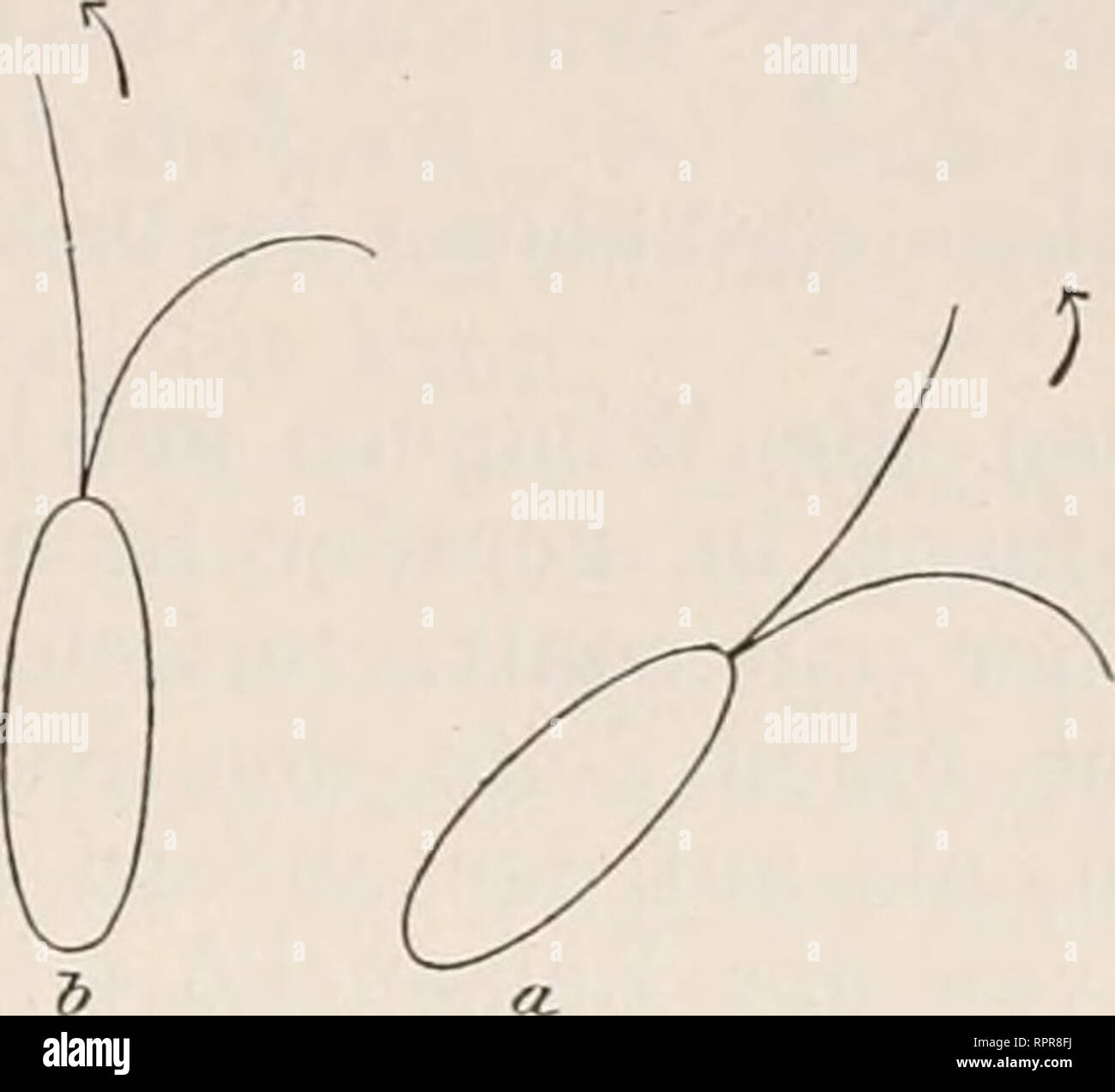 . Allgemeine Physiologie. Ein Grundriss der Lehre vom Leben. Physiology, Comparative. Fig. 256. Schema der Axeneinstellung einer Infusorienzelle mit zwei Geissein bei coutractorischer Erregung von rechts her. Die stärkere Con- cavität der einen Geissei deutet die stärkere contractorisclie Erregung an. Die Pfeile be- zcicliuen die Drehungsrichtung. lange der Reiz andauert, geradeaus. So ergiebt sich eine negative Chemotaxis, Phototaxis etc. bei eingeisseligen Bakterien und Flagel- laten als nothwendige Folge einer einseitigen contractorischen Erregung des Geisselschlages. Hiernach ist es sehr l Stock Photohttps://www.alamy.com/image-license-details/?v=1https://www.alamy.com/allgemeine-physiologie-ein-grundriss-der-lehre-vom-leben-physiology-comparative-fig-256-schema-der-axeneinstellung-einer-infusorienzelle-mit-zwei-geissein-bei-coutractorischer-erregung-von-rechts-her-die-strkere-con-cavitt-der-einen-geissei-deutet-die-strkere-contractorisclie-erregung-an-die-pfeile-be-zcicliuen-die-drehungsrichtung-lange-der-reiz-andauert-geradeaus-so-ergiebt-sich-eine-negative-chemotaxis-phototaxis-etc-bei-eingeisseligen-bakterien-und-flagel-laten-als-nothwendige-folge-einer-einseitigen-contractorischen-erregung-des-geisselschlages-hiernach-ist-es-sehr-l-image237768822.html
. Allgemeine Physiologie. Ein Grundriss der Lehre vom Leben. Physiology, Comparative. Fig. 256. Schema der Axeneinstellung einer Infusorienzelle mit zwei Geissein bei coutractorischer Erregung von rechts her. Die stärkere Con- cavität der einen Geissei deutet die stärkere contractorisclie Erregung an. Die Pfeile be- zcicliuen die Drehungsrichtung. lange der Reiz andauert, geradeaus. So ergiebt sich eine negative Chemotaxis, Phototaxis etc. bei eingeisseligen Bakterien und Flagel- laten als nothwendige Folge einer einseitigen contractorischen Erregung des Geisselschlages. Hiernach ist es sehr l Stock Photohttps://www.alamy.com/image-license-details/?v=1https://www.alamy.com/allgemeine-physiologie-ein-grundriss-der-lehre-vom-leben-physiology-comparative-fig-256-schema-der-axeneinstellung-einer-infusorienzelle-mit-zwei-geissein-bei-coutractorischer-erregung-von-rechts-her-die-strkere-con-cavitt-der-einen-geissei-deutet-die-strkere-contractorisclie-erregung-an-die-pfeile-be-zcicliuen-die-drehungsrichtung-lange-der-reiz-andauert-geradeaus-so-ergiebt-sich-eine-negative-chemotaxis-phototaxis-etc-bei-eingeisseligen-bakterien-und-flagel-laten-als-nothwendige-folge-einer-einseitigen-contractorischen-erregung-des-geisselschlages-hiernach-ist-es-sehr-l-image237768822.htmlRMRPR8FJ–. Allgemeine Physiologie. Ein Grundriss der Lehre vom Leben. Physiology, Comparative. Fig. 256. Schema der Axeneinstellung einer Infusorienzelle mit zwei Geissein bei coutractorischer Erregung von rechts her. Die stärkere Con- cavität der einen Geissei deutet die stärkere contractorisclie Erregung an. Die Pfeile be- zcicliuen die Drehungsrichtung. lange der Reiz andauert, geradeaus. So ergiebt sich eine negative Chemotaxis, Phototaxis etc. bei eingeisseligen Bakterien und Flagel- laten als nothwendige Folge einer einseitigen contractorischen Erregung des Geisselschlages. Hiernach ist es sehr l
 . The Biological bulletin. Biology; Zoology; Biology; Marine Biology. SIZE AND PHOTOTAXIS IN DICTYOSTELIUM RESULTS 53 As can be seen from Table I and Figure 2, the experiment was run at three different distances, 1, 6, and 18 feet. Although the standard deviations show considerable variability in the response, it is clear that at one foot the larger sorocarps responded while the smaller ones did not. At 18 feet there was no 3.0 .. 0.2 . + 80 +60 +40 +20 0 -20 -40 -60 Angle of orientation FIGURE 2. response, even of the largest sorocarp. In fact this agrees with a control run in the total darkn Stock Photohttps://www.alamy.com/image-license-details/?v=1https://www.alamy.com/the-biological-bulletin-biology-zoology-biology-marine-biology-size-and-phototaxis-in-dictyostelium-results-53-as-can-be-seen-from-table-i-and-figure-2-the-experiment-was-run-at-three-different-distances-1-6-and-18-feet-although-the-standard-deviations-show-considerable-variability-in-the-response-it-is-clear-that-at-one-foot-the-larger-sorocarps-responded-while-the-smaller-ones-did-not-at-18-feet-there-was-no-30-02-80-60-40-20-0-20-40-60-angle-of-orientation-figure-2-response-even-of-the-largest-sorocarp-in-fact-this-agrees-with-a-control-run-in-the-total-darkn-image234663628.html
. The Biological bulletin. Biology; Zoology; Biology; Marine Biology. SIZE AND PHOTOTAXIS IN DICTYOSTELIUM RESULTS 53 As can be seen from Table I and Figure 2, the experiment was run at three different distances, 1, 6, and 18 feet. Although the standard deviations show considerable variability in the response, it is clear that at one foot the larger sorocarps responded while the smaller ones did not. At 18 feet there was no 3.0 .. 0.2 . + 80 +60 +40 +20 0 -20 -40 -60 Angle of orientation FIGURE 2. response, even of the largest sorocarp. In fact this agrees with a control run in the total darkn Stock Photohttps://www.alamy.com/image-license-details/?v=1https://www.alamy.com/the-biological-bulletin-biology-zoology-biology-marine-biology-size-and-phototaxis-in-dictyostelium-results-53-as-can-be-seen-from-table-i-and-figure-2-the-experiment-was-run-at-three-different-distances-1-6-and-18-feet-although-the-standard-deviations-show-considerable-variability-in-the-response-it-is-clear-that-at-one-foot-the-larger-sorocarps-responded-while-the-smaller-ones-did-not-at-18-feet-there-was-no-30-02-80-60-40-20-0-20-40-60-angle-of-orientation-figure-2-response-even-of-the-largest-sorocarp-in-fact-this-agrees-with-a-control-run-in-the-total-darkn-image234663628.htmlRMRHNRRT–. The Biological bulletin. Biology; Zoology; Biology; Marine Biology. SIZE AND PHOTOTAXIS IN DICTYOSTELIUM RESULTS 53 As can be seen from Table I and Figure 2, the experiment was run at three different distances, 1, 6, and 18 feet. Although the standard deviations show considerable variability in the response, it is clear that at one foot the larger sorocarps responded while the smaller ones did not. At 18 feet there was no 3.0 .. 0.2 . + 80 +60 +40 +20 0 -20 -40 -60 Angle of orientation FIGURE 2. response, even of the largest sorocarp. In fact this agrees with a control run in the total darkn
![. The Biological bulletin. Biology; Zoology; Biology; Marine Biology. 300 400 500 600 Wavelength [nm] 700 Figure 2. Spectral sensitivity of Calanopia americana. The percentage of copepods displaying positive phototaxis (upward swimming ± 30°) is plotted as a function of wavelength. All other symbols are as described for Figure 1. (Fig. 2). Positive phototactic responses significantly greater than the control value were found in the UVA (350, 380, 400 nm), with even greater response values from 420 to 580 nm (one-factor RM ANOVA. P < 0.001; Dunnett's test, P 0.05). The reverse migrator, Anom Stock Photo . The Biological bulletin. Biology; Zoology; Biology; Marine Biology. 300 400 500 600 Wavelength [nm] 700 Figure 2. Spectral sensitivity of Calanopia americana. The percentage of copepods displaying positive phototaxis (upward swimming ± 30°) is plotted as a function of wavelength. All other symbols are as described for Figure 1. (Fig. 2). Positive phototactic responses significantly greater than the control value were found in the UVA (350, 380, 400 nm), with even greater response values from 420 to 580 nm (one-factor RM ANOVA. P < 0.001; Dunnett's test, P 0.05). The reverse migrator, Anom Stock Photo](https://c8.alamy.com/comp/RHM84K/the-biological-bulletin-biology-zoology-biology-marine-biology-300-400-500-600-wavelength-nm-700-figure-2-spectral-sensitivity-of-calanopia-americana-the-percentage-of-copepods-displaying-positive-phototaxis-upward-swimming-30-is-plotted-as-a-function-of-wavelength-all-other-symbols-are-as-described-for-figure-1-fig-2-positive-phototactic-responses-significantly-greater-than-the-control-value-were-found-in-the-uva-350-380-400-nm-with-even-greater-response-values-from-420-to-580-nm-one-factor-rm-anova-p-lt-0001-dunnetts-test-p-005-the-reverse-migrator-anom-RHM84K.jpg) . The Biological bulletin. Biology; Zoology; Biology; Marine Biology. 300 400 500 600 Wavelength [nm] 700 Figure 2. Spectral sensitivity of Calanopia americana. The percentage of copepods displaying positive phototaxis (upward swimming ± 30°) is plotted as a function of wavelength. All other symbols are as described for Figure 1. (Fig. 2). Positive phototactic responses significantly greater than the control value were found in the UVA (350, 380, 400 nm), with even greater response values from 420 to 580 nm (one-factor RM ANOVA. P < 0.001; Dunnett's test, P 0.05). The reverse migrator, Anom Stock Photohttps://www.alamy.com/image-license-details/?v=1https://www.alamy.com/the-biological-bulletin-biology-zoology-biology-marine-biology-300-400-500-600-wavelength-nm-700-figure-2-spectral-sensitivity-of-calanopia-americana-the-percentage-of-copepods-displaying-positive-phototaxis-upward-swimming-30-is-plotted-as-a-function-of-wavelength-all-other-symbols-are-as-described-for-figure-1-fig-2-positive-phototactic-responses-significantly-greater-than-the-control-value-were-found-in-the-uva-350-380-400-nm-with-even-greater-response-values-from-420-to-580-nm-one-factor-rm-anova-p-lt-0001-dunnetts-test-p-005-the-reverse-migrator-anom-image234629379.html
. The Biological bulletin. Biology; Zoology; Biology; Marine Biology. 300 400 500 600 Wavelength [nm] 700 Figure 2. Spectral sensitivity of Calanopia americana. The percentage of copepods displaying positive phototaxis (upward swimming ± 30°) is plotted as a function of wavelength. All other symbols are as described for Figure 1. (Fig. 2). Positive phototactic responses significantly greater than the control value were found in the UVA (350, 380, 400 nm), with even greater response values from 420 to 580 nm (one-factor RM ANOVA. P < 0.001; Dunnett's test, P 0.05). The reverse migrator, Anom Stock Photohttps://www.alamy.com/image-license-details/?v=1https://www.alamy.com/the-biological-bulletin-biology-zoology-biology-marine-biology-300-400-500-600-wavelength-nm-700-figure-2-spectral-sensitivity-of-calanopia-americana-the-percentage-of-copepods-displaying-positive-phototaxis-upward-swimming-30-is-plotted-as-a-function-of-wavelength-all-other-symbols-are-as-described-for-figure-1-fig-2-positive-phototactic-responses-significantly-greater-than-the-control-value-were-found-in-the-uva-350-380-400-nm-with-even-greater-response-values-from-420-to-580-nm-one-factor-rm-anova-p-lt-0001-dunnetts-test-p-005-the-reverse-migrator-anom-image234629379.htmlRMRHM84K–. The Biological bulletin. Biology; Zoology; Biology; Marine Biology. 300 400 500 600 Wavelength [nm] 700 Figure 2. Spectral sensitivity of Calanopia americana. The percentage of copepods displaying positive phototaxis (upward swimming ± 30°) is plotted as a function of wavelength. All other symbols are as described for Figure 1. (Fig. 2). Positive phototactic responses significantly greater than the control value were found in the UVA (350, 380, 400 nm), with even greater response values from 420 to 580 nm (one-factor RM ANOVA. P < 0.001; Dunnett's test, P 0.05). The reverse migrator, Anom
 . The Biological bulletin. Biology; Zoology; Biology; Marine Biology. ARROW WORM PHOTOTAXIS 423. FIGURE 5. Photograph taken by a 3 s continuous exposure, showing an arrow worm's pattern of target-aiming swimming. Light (50,000 lux) directed from the right was reduced by 90%. Note that the worm, which had been inclined toward the left, changed its body axis to the right almost instantaneously: No trail linking the left-oriented posture to the right appears on the photograph, indicating a very quick change sequence. Scale: 1 cm. In each experiment, a light-adapted worm was placed in a trough 20 Stock Photohttps://www.alamy.com/image-license-details/?v=1https://www.alamy.com/the-biological-bulletin-biology-zoology-biology-marine-biology-arrow-worm-phototaxis-423-figure-5-photograph-taken-by-a-3-s-continuous-exposure-showing-an-arrow-worms-pattern-of-target-aiming-swimming-light-50000-lux-directed-from-the-right-was-reduced-by-90-note-that-the-worm-which-had-been-inclined-toward-the-left-changed-its-body-axis-to-the-right-almost-instantaneously-no-trail-linking-the-left-oriented-posture-to-the-right-appears-on-the-photograph-indicating-a-very-quick-change-sequence-scale-1-cm-in-each-experiment-a-light-adapted-worm-was-placed-in-a-trough-20-image234646629.html
. The Biological bulletin. Biology; Zoology; Biology; Marine Biology. ARROW WORM PHOTOTAXIS 423. FIGURE 5. Photograph taken by a 3 s continuous exposure, showing an arrow worm's pattern of target-aiming swimming. Light (50,000 lux) directed from the right was reduced by 90%. Note that the worm, which had been inclined toward the left, changed its body axis to the right almost instantaneously: No trail linking the left-oriented posture to the right appears on the photograph, indicating a very quick change sequence. Scale: 1 cm. In each experiment, a light-adapted worm was placed in a trough 20 Stock Photohttps://www.alamy.com/image-license-details/?v=1https://www.alamy.com/the-biological-bulletin-biology-zoology-biology-marine-biology-arrow-worm-phototaxis-423-figure-5-photograph-taken-by-a-3-s-continuous-exposure-showing-an-arrow-worms-pattern-of-target-aiming-swimming-light-50000-lux-directed-from-the-right-was-reduced-by-90-note-that-the-worm-which-had-been-inclined-toward-the-left-changed-its-body-axis-to-the-right-almost-instantaneously-no-trail-linking-the-left-oriented-posture-to-the-right-appears-on-the-photograph-indicating-a-very-quick-change-sequence-scale-1-cm-in-each-experiment-a-light-adapted-worm-was-placed-in-a-trough-20-image234646629.htmlRMRHN24N–. The Biological bulletin. Biology; Zoology; Biology; Marine Biology. ARROW WORM PHOTOTAXIS 423. FIGURE 5. Photograph taken by a 3 s continuous exposure, showing an arrow worm's pattern of target-aiming swimming. Light (50,000 lux) directed from the right was reduced by 90%. Note that the worm, which had been inclined toward the left, changed its body axis to the right almost instantaneously: No trail linking the left-oriented posture to the right appears on the photograph, indicating a very quick change sequence. Scale: 1 cm. In each experiment, a light-adapted worm was placed in a trough 20
 . The Biological bulletin. Biology; Zoology; Biology; Marine Biology. 290 T. W. CRONIN AND R. B. FORWARD, JR. larvae always swam more slowly than fed larvae; the difference, as tested by a t-test (one-tailed) for each day, was significant for stage I, day 1 ; stage II, day 2; and stage IV, day 3. During positive phototaxis, swimming speeds of fed larvae again usually exceeded those of starved larvae, but the effect was only significant for larvae in stage III, day 1. Swimming speeds of fed larvae during negative phototaxis were also usually higher than those of starved larvae; the difference w Stock Photohttps://www.alamy.com/image-license-details/?v=1https://www.alamy.com/the-biological-bulletin-biology-zoology-biology-marine-biology-290-t-w-cronin-and-r-b-forward-jr-larvae-always-swam-more-slowly-than-fed-larvae-the-difference-as-tested-by-a-t-test-one-tailed-for-each-day-was-significant-for-stage-i-day-1-stage-ii-day-2-and-stage-iv-day-3-during-positive-phototaxis-swimming-speeds-of-fed-larvae-again-usually-exceeded-those-of-starved-larvae-but-the-effect-was-only-significant-for-larvae-in-stage-iii-day-1-swimming-speeds-of-fed-larvae-during-negative-phototaxis-were-also-usually-higher-than-those-of-starved-larvae-the-difference-w-image234619630.html
. The Biological bulletin. Biology; Zoology; Biology; Marine Biology. 290 T. W. CRONIN AND R. B. FORWARD, JR. larvae always swam more slowly than fed larvae; the difference, as tested by a t-test (one-tailed) for each day, was significant for stage I, day 1 ; stage II, day 2; and stage IV, day 3. During positive phototaxis, swimming speeds of fed larvae again usually exceeded those of starved larvae, but the effect was only significant for larvae in stage III, day 1. Swimming speeds of fed larvae during negative phototaxis were also usually higher than those of starved larvae; the difference w Stock Photohttps://www.alamy.com/image-license-details/?v=1https://www.alamy.com/the-biological-bulletin-biology-zoology-biology-marine-biology-290-t-w-cronin-and-r-b-forward-jr-larvae-always-swam-more-slowly-than-fed-larvae-the-difference-as-tested-by-a-t-test-one-tailed-for-each-day-was-significant-for-stage-i-day-1-stage-ii-day-2-and-stage-iv-day-3-during-positive-phototaxis-swimming-speeds-of-fed-larvae-again-usually-exceeded-those-of-starved-larvae-but-the-effect-was-only-significant-for-larvae-in-stage-iii-day-1-swimming-speeds-of-fed-larvae-during-negative-phototaxis-were-also-usually-higher-than-those-of-starved-larvae-the-difference-w-image234619630.htmlRMRHKRME–. The Biological bulletin. Biology; Zoology; Biology; Marine Biology. 290 T. W. CRONIN AND R. B. FORWARD, JR. larvae always swam more slowly than fed larvae; the difference, as tested by a t-test (one-tailed) for each day, was significant for stage I, day 1 ; stage II, day 2; and stage IV, day 3. During positive phototaxis, swimming speeds of fed larvae again usually exceeded those of starved larvae, but the effect was only significant for larvae in stage III, day 1. Swimming speeds of fed larvae during negative phototaxis were also usually higher than those of starved larvae; the difference w
 . The Biological bulletin. Biology; Zoology; Biology; Marine Biology. GENETIC INFLUENCE ON PHOTOTAXIS 265 the maze each individual makes 15 consecutive light/dark choices. The animals emerge in 16 collecting tubes, each containing a plug of culture medium. The collecting tube into which a fly emerges establishes how many light or dark choices it has made in passing through the maze. A "Plexiglas" cone (Hirsch, 1959) is inserted in each arm of a Y-unit to minimize re-tracing. A maze of Ar units has A'( A' + 1 ) '2 Y-units. .V(AT + 1 ) cones and ( A' + 1) collecting tubes. The structur Stock Photohttps://www.alamy.com/image-license-details/?v=1https://www.alamy.com/the-biological-bulletin-biology-zoology-biology-marine-biology-genetic-influence-on-phototaxis-265-the-maze-each-individual-makes-15-consecutive-lightdark-choices-the-animals-emerge-in-16-collecting-tubes-each-containing-a-plug-of-culture-medium-the-collecting-tube-into-which-a-fly-emerges-establishes-how-many-light-or-dark-choices-it-has-made-in-passing-through-the-maze-a-quotplexiglasquot-cone-hirsch-1959-is-inserted-in-each-arm-of-a-y-unit-to-minimize-re-tracing-a-maze-of-ar-units-has-a-a-1-2-y-units-vat-1-cones-and-a-1-collecting-tubes-the-structur-image234638730.html
. The Biological bulletin. Biology; Zoology; Biology; Marine Biology. GENETIC INFLUENCE ON PHOTOTAXIS 265 the maze each individual makes 15 consecutive light/dark choices. The animals emerge in 16 collecting tubes, each containing a plug of culture medium. The collecting tube into which a fly emerges establishes how many light or dark choices it has made in passing through the maze. A "Plexiglas" cone (Hirsch, 1959) is inserted in each arm of a Y-unit to minimize re-tracing. A maze of Ar units has A'( A' + 1 ) '2 Y-units. .V(AT + 1 ) cones and ( A' + 1) collecting tubes. The structur Stock Photohttps://www.alamy.com/image-license-details/?v=1https://www.alamy.com/the-biological-bulletin-biology-zoology-biology-marine-biology-genetic-influence-on-phototaxis-265-the-maze-each-individual-makes-15-consecutive-lightdark-choices-the-animals-emerge-in-16-collecting-tubes-each-containing-a-plug-of-culture-medium-the-collecting-tube-into-which-a-fly-emerges-establishes-how-many-light-or-dark-choices-it-has-made-in-passing-through-the-maze-a-quotplexiglasquot-cone-hirsch-1959-is-inserted-in-each-arm-of-a-y-unit-to-minimize-re-tracing-a-maze-of-ar-units-has-a-a-1-2-y-units-vat-1-cones-and-a-1-collecting-tubes-the-structur-image234638730.htmlRMRHMM2J–. The Biological bulletin. Biology; Zoology; Biology; Marine Biology. GENETIC INFLUENCE ON PHOTOTAXIS 265 the maze each individual makes 15 consecutive light/dark choices. The animals emerge in 16 collecting tubes, each containing a plug of culture medium. The collecting tube into which a fly emerges establishes how many light or dark choices it has made in passing through the maze. A "Plexiglas" cone (Hirsch, 1959) is inserted in each arm of a Y-unit to minimize re-tracing. A maze of Ar units has A'( A' + 1 ) '2 Y-units. .V(AT + 1 ) cones and ( A' + 1) collecting tubes. The structur
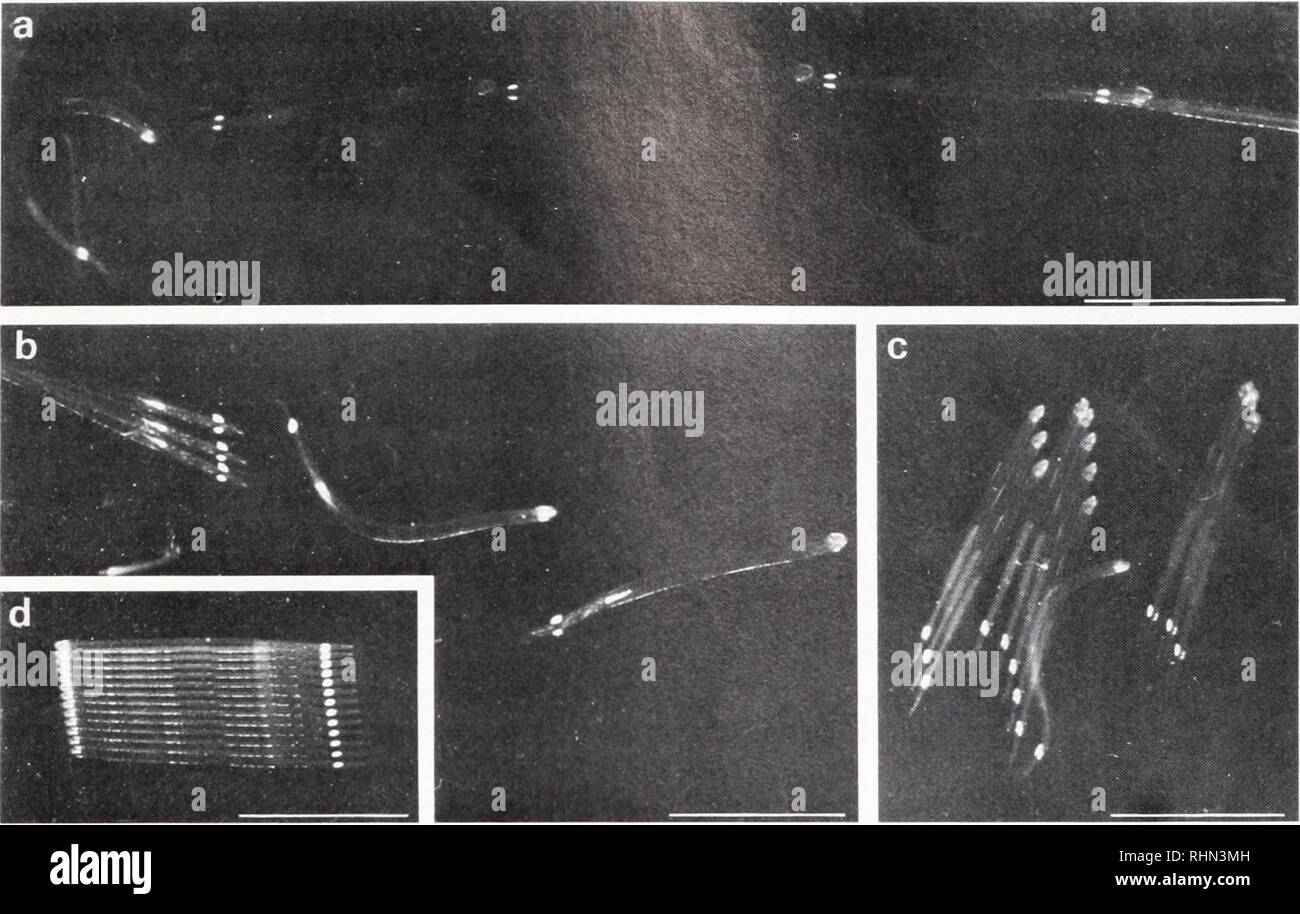 . The Biological bulletin. Biology; Zoology; Biology; Marine Biology. EYE AND CNS IN SAGITTA PHOTOTAXIS 87. FIGURE 3. Examples of profiles of Sagilta showing QTA responses (a and b), ST response (c) and passive sinking (d). The target light source was to the right. Scale bars indicate 0.5 cm. a: The bending profile of stroke to the left is followed by gliding profiles with horizontal dorso-ventral plane, b: Passively sinking worm to the left points to the right with a bending profile in the middle, c: Three shots to the left and five in the middle show lateral profiles and three to the right s Stock Photohttps://www.alamy.com/image-license-details/?v=1https://www.alamy.com/the-biological-bulletin-biology-zoology-biology-marine-biology-eye-and-cns-in-sagitta-phototaxis-87-figure-3-examples-of-profiles-of-sagilta-showing-qta-responses-a-and-b-st-response-c-and-passive-sinking-d-the-target-light-source-was-to-the-right-scale-bars-indicate-05-cm-a-the-bending-profile-of-stroke-to-the-left-is-followed-by-gliding-profiles-with-horizontal-dorso-ventral-plane-b-passively-sinking-worm-to-the-left-points-to-the-right-with-a-bending-profile-in-the-middle-c-three-shots-to-the-left-and-five-in-the-middle-show-lateral-profiles-and-three-to-the-right-s-image234647857.html
. The Biological bulletin. Biology; Zoology; Biology; Marine Biology. EYE AND CNS IN SAGITTA PHOTOTAXIS 87. FIGURE 3. Examples of profiles of Sagilta showing QTA responses (a and b), ST response (c) and passive sinking (d). The target light source was to the right. Scale bars indicate 0.5 cm. a: The bending profile of stroke to the left is followed by gliding profiles with horizontal dorso-ventral plane, b: Passively sinking worm to the left points to the right with a bending profile in the middle, c: Three shots to the left and five in the middle show lateral profiles and three to the right s Stock Photohttps://www.alamy.com/image-license-details/?v=1https://www.alamy.com/the-biological-bulletin-biology-zoology-biology-marine-biology-eye-and-cns-in-sagitta-phototaxis-87-figure-3-examples-of-profiles-of-sagilta-showing-qta-responses-a-and-b-st-response-c-and-passive-sinking-d-the-target-light-source-was-to-the-right-scale-bars-indicate-05-cm-a-the-bending-profile-of-stroke-to-the-left-is-followed-by-gliding-profiles-with-horizontal-dorso-ventral-plane-b-passively-sinking-worm-to-the-left-points-to-the-right-with-a-bending-profile-in-the-middle-c-three-shots-to-the-left-and-five-in-the-middle-show-lateral-profiles-and-three-to-the-right-s-image234647857.htmlRMRHN3MH–. The Biological bulletin. Biology; Zoology; Biology; Marine Biology. EYE AND CNS IN SAGITTA PHOTOTAXIS 87. FIGURE 3. Examples of profiles of Sagilta showing QTA responses (a and b), ST response (c) and passive sinking (d). The target light source was to the right. Scale bars indicate 0.5 cm. a: The bending profile of stroke to the left is followed by gliding profiles with horizontal dorso-ventral plane, b: Passively sinking worm to the left points to the right with a bending profile in the middle, c: Three shots to the left and five in the middle show lateral profiles and three to the right s
 . Allgemeine Physiologie; ein Grundriss der Lehre vom Leben. Physiology; Biology. Fig. 276. /Negative Chemotaxis von Paramaecium. Schwimmbahn eines einzelnen Paramaeciums in einem Tropfen schwacher Säurelösung, zu der es positiv chemotaktisch ist. //Negative Phototaxis von Stentor. Reaktion eines Indi- viduums bei Berührung der Grenze von Dunkel zu Hell in vier aufeinanderfolgenden Stadien. Nach Jennings. So ergeben sich die interessanten und im gesamten organischen Leben so überaus wichtigen Tatsachen der positiven und negativen Chemotaxis, Barotaxis, Thermo- taxis, Phototaxis und Galvanotaxi Stock Photohttps://www.alamy.com/image-license-details/?v=1https://www.alamy.com/allgemeine-physiologie-ein-grundriss-der-lehre-vom-leben-physiology-biology-fig-276-negative-chemotaxis-von-paramaecium-schwimmbahn-eines-einzelnen-paramaeciums-in-einem-tropfen-schwacher-surelsung-zu-der-es-positiv-chemotaktisch-ist-negative-phototaxis-von-stentor-reaktion-eines-indi-viduums-bei-berhrung-der-grenze-von-dunkel-zu-hell-in-vier-aufeinanderfolgenden-stadien-nach-jennings-so-ergeben-sich-die-interessanten-und-im-gesamten-organischen-leben-so-beraus-wichtigen-tatsachen-der-positiven-und-negativen-chemotaxis-barotaxis-thermo-taxis-phototaxis-und-galvanotaxi-image237769885.html
. Allgemeine Physiologie; ein Grundriss der Lehre vom Leben. Physiology; Biology. Fig. 276. /Negative Chemotaxis von Paramaecium. Schwimmbahn eines einzelnen Paramaeciums in einem Tropfen schwacher Säurelösung, zu der es positiv chemotaktisch ist. //Negative Phototaxis von Stentor. Reaktion eines Indi- viduums bei Berührung der Grenze von Dunkel zu Hell in vier aufeinanderfolgenden Stadien. Nach Jennings. So ergeben sich die interessanten und im gesamten organischen Leben so überaus wichtigen Tatsachen der positiven und negativen Chemotaxis, Barotaxis, Thermo- taxis, Phototaxis und Galvanotaxi Stock Photohttps://www.alamy.com/image-license-details/?v=1https://www.alamy.com/allgemeine-physiologie-ein-grundriss-der-lehre-vom-leben-physiology-biology-fig-276-negative-chemotaxis-von-paramaecium-schwimmbahn-eines-einzelnen-paramaeciums-in-einem-tropfen-schwacher-surelsung-zu-der-es-positiv-chemotaktisch-ist-negative-phototaxis-von-stentor-reaktion-eines-indi-viduums-bei-berhrung-der-grenze-von-dunkel-zu-hell-in-vier-aufeinanderfolgenden-stadien-nach-jennings-so-ergeben-sich-die-interessanten-und-im-gesamten-organischen-leben-so-beraus-wichtigen-tatsachen-der-positiven-und-negativen-chemotaxis-barotaxis-thermo-taxis-phototaxis-und-galvanotaxi-image237769885.htmlRMRPR9WH–. Allgemeine Physiologie; ein Grundriss der Lehre vom Leben. Physiology; Biology. Fig. 276. /Negative Chemotaxis von Paramaecium. Schwimmbahn eines einzelnen Paramaeciums in einem Tropfen schwacher Säurelösung, zu der es positiv chemotaktisch ist. //Negative Phototaxis von Stentor. Reaktion eines Indi- viduums bei Berührung der Grenze von Dunkel zu Hell in vier aufeinanderfolgenden Stadien. Nach Jennings. So ergeben sich die interessanten und im gesamten organischen Leben so überaus wichtigen Tatsachen der positiven und negativen Chemotaxis, Barotaxis, Thermo- taxis, Phototaxis und Galvanotaxi
 . Allgemeine Physiologie; ein Grundriss der Lehre vom Leben. Physiology; Biology. 614 Sechstes Kapitel. rader Richtung von der Reizquelle fort. So ergibt sich schließlich auch bei AVimperinfusorien negative Chemo-, Baro-. Thermo-, Photo- taxis aus einseitiger kontraktorischer Erregung. Ebenso einfach ist die Kontraktion des Mechanismus der Aclisen- einstellung bei der positiven Chemo-, Thermo-, Phototaxis etc. der Flimmerzellen. Die Achseneinstellung bei diesen Reizwirkungen kann z. B. hervorgerufen werden durch eine einseitige expansorische Er- regung. Denken wir uns, daß ein Reiz von einer S Stock Photohttps://www.alamy.com/image-license-details/?v=1https://www.alamy.com/allgemeine-physiologie-ein-grundriss-der-lehre-vom-leben-physiology-biology-614-sechstes-kapitel-rader-richtung-von-der-reizquelle-fort-so-ergibt-sich-schlielich-auch-bei-avimperinfusorien-negative-chemo-baro-thermo-photo-taxis-aus-einseitiger-kontraktorischer-erregung-ebenso-einfach-ist-die-kontraktion-des-mechanismus-der-aclisen-einstellung-bei-der-positiven-chemo-thermo-phototaxis-etc-der-flimmerzellen-die-achseneinstellung-bei-diesen-reizwirkungen-kann-z-b-hervorgerufen-werden-durch-eine-einseitige-expansorische-er-regung-denken-wir-uns-da-ein-reiz-von-einer-s-image237770056.html
. Allgemeine Physiologie; ein Grundriss der Lehre vom Leben. Physiology; Biology. 614 Sechstes Kapitel. rader Richtung von der Reizquelle fort. So ergibt sich schließlich auch bei AVimperinfusorien negative Chemo-, Baro-. Thermo-, Photo- taxis aus einseitiger kontraktorischer Erregung. Ebenso einfach ist die Kontraktion des Mechanismus der Aclisen- einstellung bei der positiven Chemo-, Thermo-, Phototaxis etc. der Flimmerzellen. Die Achseneinstellung bei diesen Reizwirkungen kann z. B. hervorgerufen werden durch eine einseitige expansorische Er- regung. Denken wir uns, daß ein Reiz von einer S Stock Photohttps://www.alamy.com/image-license-details/?v=1https://www.alamy.com/allgemeine-physiologie-ein-grundriss-der-lehre-vom-leben-physiology-biology-614-sechstes-kapitel-rader-richtung-von-der-reizquelle-fort-so-ergibt-sich-schlielich-auch-bei-avimperinfusorien-negative-chemo-baro-thermo-photo-taxis-aus-einseitiger-kontraktorischer-erregung-ebenso-einfach-ist-die-kontraktion-des-mechanismus-der-aclisen-einstellung-bei-der-positiven-chemo-thermo-phototaxis-etc-der-flimmerzellen-die-achseneinstellung-bei-diesen-reizwirkungen-kann-z-b-hervorgerufen-werden-durch-eine-einseitige-expansorische-er-regung-denken-wir-uns-da-ein-reiz-von-einer-s-image237770056.htmlRMRPRA3M–. Allgemeine Physiologie; ein Grundriss der Lehre vom Leben. Physiology; Biology. 614 Sechstes Kapitel. rader Richtung von der Reizquelle fort. So ergibt sich schließlich auch bei AVimperinfusorien negative Chemo-, Baro-. Thermo-, Photo- taxis aus einseitiger kontraktorischer Erregung. Ebenso einfach ist die Kontraktion des Mechanismus der Aclisen- einstellung bei der positiven Chemo-, Thermo-, Phototaxis etc. der Flimmerzellen. Die Achseneinstellung bei diesen Reizwirkungen kann z. B. hervorgerufen werden durch eine einseitige expansorische Er- regung. Denken wir uns, daß ein Reiz von einer S
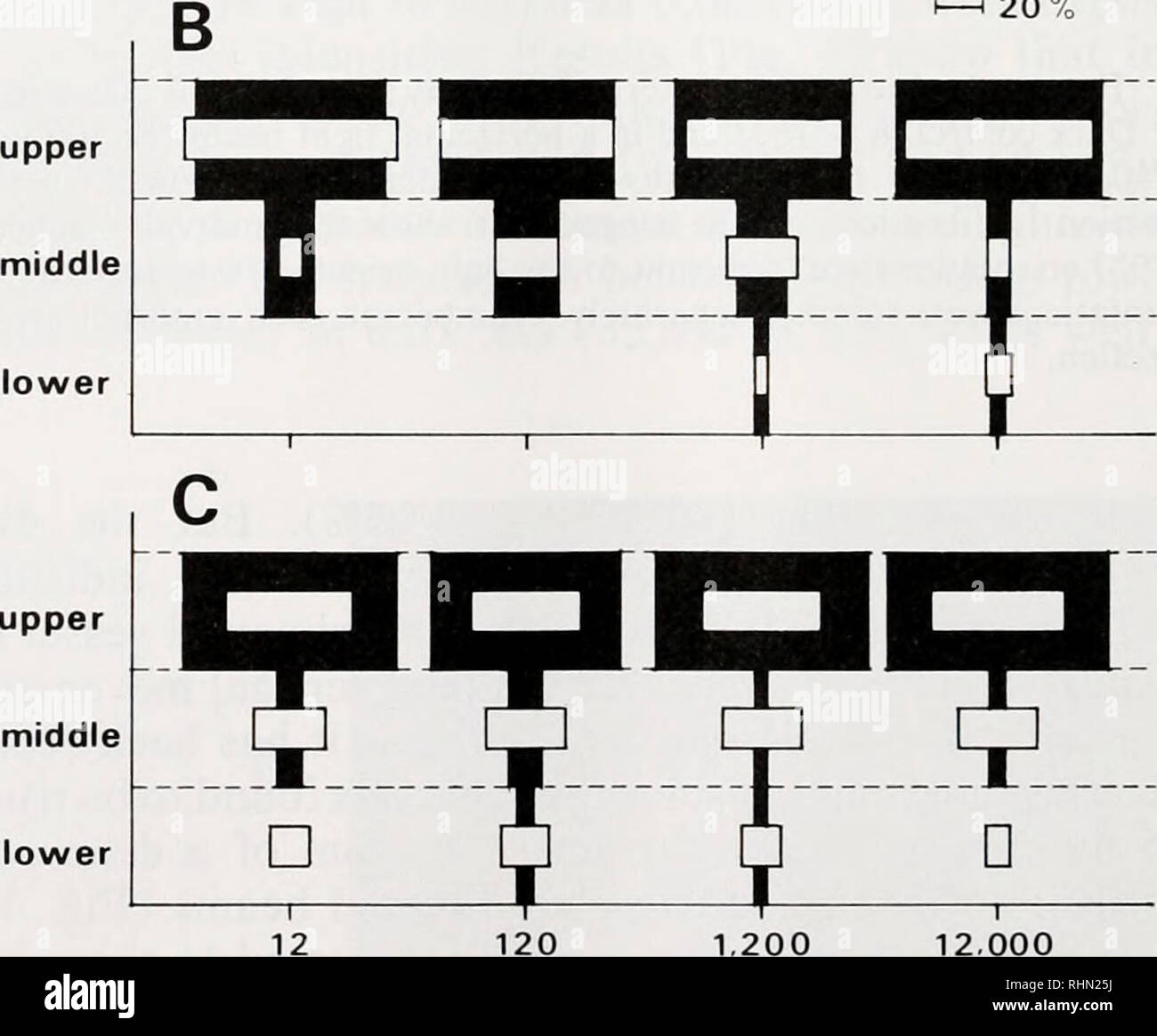 . The Biological bulletin. Biology; Zoology; Biology; Marine Biology. 12 120 1.200 12.000 Light intensity (lux). upper middle lower 120 1.200 Light intensity (lux) 12.000 FIGURE 4. Phototaxis in vertical light beams. A: Percentages of worms (n = 20) which reached the water surface at least once with a downward directed beam, curve a, or the bottom of the tank with an upward directed beam, curve b. B and C: Vertical distribution patterns at the beginning (initial, black bars) and end (final, white bars) of a 10 min illumination period with either downward (B) or upward (C) directed beams after Stock Photohttps://www.alamy.com/image-license-details/?v=1https://www.alamy.com/the-biological-bulletin-biology-zoology-biology-marine-biology-12-120-1200-12000-light-intensity-lux-upper-middle-lower-120-1200-light-intensity-lux-12000-figure-4-phototaxis-in-vertical-light-beams-a-percentages-of-worms-n-=-20-which-reached-the-water-surface-at-least-once-with-a-downward-directed-beam-curve-a-or-the-bottom-of-the-tank-with-an-upward-directed-beam-curve-b-b-and-c-vertical-distribution-patterns-at-the-beginning-initial-black-bars-and-end-final-white-bars-of-a-10-min-illumination-period-with-either-downward-b-or-upward-c-directed-beams-after-image234646654.html
. The Biological bulletin. Biology; Zoology; Biology; Marine Biology. 12 120 1.200 12.000 Light intensity (lux). upper middle lower 120 1.200 Light intensity (lux) 12.000 FIGURE 4. Phototaxis in vertical light beams. A: Percentages of worms (n = 20) which reached the water surface at least once with a downward directed beam, curve a, or the bottom of the tank with an upward directed beam, curve b. B and C: Vertical distribution patterns at the beginning (initial, black bars) and end (final, white bars) of a 10 min illumination period with either downward (B) or upward (C) directed beams after Stock Photohttps://www.alamy.com/image-license-details/?v=1https://www.alamy.com/the-biological-bulletin-biology-zoology-biology-marine-biology-12-120-1200-12000-light-intensity-lux-upper-middle-lower-120-1200-light-intensity-lux-12000-figure-4-phototaxis-in-vertical-light-beams-a-percentages-of-worms-n-=-20-which-reached-the-water-surface-at-least-once-with-a-downward-directed-beam-curve-a-or-the-bottom-of-the-tank-with-an-upward-directed-beam-curve-b-b-and-c-vertical-distribution-patterns-at-the-beginning-initial-black-bars-and-end-final-white-bars-of-a-10-min-illumination-period-with-either-downward-b-or-upward-c-directed-beams-after-image234646654.htmlRMRHN25J–. The Biological bulletin. Biology; Zoology; Biology; Marine Biology. 12 120 1.200 12.000 Light intensity (lux). upper middle lower 120 1.200 Light intensity (lux) 12.000 FIGURE 4. Phototaxis in vertical light beams. A: Percentages of worms (n = 20) which reached the water surface at least once with a downward directed beam, curve a, or the bottom of the tank with an upward directed beam, curve b. B and C: Vertical distribution patterns at the beginning (initial, black bars) and end (final, white bars) of a 10 min illumination period with either downward (B) or upward (C) directed beams after
 . The Biological bulletin. Biology; Zoology; Biology; Marine Biology. POLAROTAXIS IN CRAB LARVAE 261 UJ CO z o Q. CO LJ cr 12 10 8 6 4 2-. 400 450 500 550 WAVELENGTH (nm) i i i i r 600 650 FIGURE 7. Spectral sensitivity for polarotaxis. Points represent the percentage of swimming perpendicular to the e-vector (ordinate) at the stimulus wavelengths (abscissa). The horizontal arrow shows the expected percentage response for random swimming. Phototaxis vs. polarotaxis In these tests the experimental vessel was surrounded by a collar of alternating black and white quadrants. Under depolarized ligh Stock Photohttps://www.alamy.com/image-license-details/?v=1https://www.alamy.com/the-biological-bulletin-biology-zoology-biology-marine-biology-polarotaxis-in-crab-larvae-261-uj-co-z-o-q-co-lj-cr-12-10-8-6-4-2-400-450-500-550-wavelength-nm-i-i-i-i-r-600-650-figure-7-spectral-sensitivity-for-polarotaxis-points-represent-the-percentage-of-swimming-perpendicular-to-the-e-vector-ordinate-at-the-stimulus-wavelengths-abscissa-the-horizontal-arrow-shows-the-expected-percentage-response-for-random-swimming-phototaxis-vs-polarotaxis-in-these-tests-the-experimental-vessel-was-surrounded-by-a-collar-of-alternating-black-and-white-quadrants-under-depolarized-ligh-image234637664.html
. The Biological bulletin. Biology; Zoology; Biology; Marine Biology. POLAROTAXIS IN CRAB LARVAE 261 UJ CO z o Q. CO LJ cr 12 10 8 6 4 2-. 400 450 500 550 WAVELENGTH (nm) i i i i r 600 650 FIGURE 7. Spectral sensitivity for polarotaxis. Points represent the percentage of swimming perpendicular to the e-vector (ordinate) at the stimulus wavelengths (abscissa). The horizontal arrow shows the expected percentage response for random swimming. Phototaxis vs. polarotaxis In these tests the experimental vessel was surrounded by a collar of alternating black and white quadrants. Under depolarized ligh Stock Photohttps://www.alamy.com/image-license-details/?v=1https://www.alamy.com/the-biological-bulletin-biology-zoology-biology-marine-biology-polarotaxis-in-crab-larvae-261-uj-co-z-o-q-co-lj-cr-12-10-8-6-4-2-400-450-500-550-wavelength-nm-i-i-i-i-r-600-650-figure-7-spectral-sensitivity-for-polarotaxis-points-represent-the-percentage-of-swimming-perpendicular-to-the-e-vector-ordinate-at-the-stimulus-wavelengths-abscissa-the-horizontal-arrow-shows-the-expected-percentage-response-for-random-swimming-phototaxis-vs-polarotaxis-in-these-tests-the-experimental-vessel-was-surrounded-by-a-collar-of-alternating-black-and-white-quadrants-under-depolarized-ligh-image234637664.htmlRMRHMJMG–. The Biological bulletin. Biology; Zoology; Biology; Marine Biology. POLAROTAXIS IN CRAB LARVAE 261 UJ CO z o Q. CO LJ cr 12 10 8 6 4 2-. 400 450 500 550 WAVELENGTH (nm) i i i i r 600 650 FIGURE 7. Spectral sensitivity for polarotaxis. Points represent the percentage of swimming perpendicular to the e-vector (ordinate) at the stimulus wavelengths (abscissa). The horizontal arrow shows the expected percentage response for random swimming. Phototaxis vs. polarotaxis In these tests the experimental vessel was surrounded by a collar of alternating black and white quadrants. Under depolarized ligh
 . The Biological bulletin. Biology; Zoology; Biology; Marine Biology. B 100 50 100 150 TIME(MIN) 200 250 QUINPIROLE. 100 150 TIME(MIN) 200 250 Figure 2. Percentage of larvae ofBugitla ncrilina that were pholo- • after timed exposure to varying concentrations of (A) dopa- and (B) quinpirole. Each point represents the mean (±1 SEM) of ic trials. I •, i .nation of symbols as in Figure 1. •of larvae of B. neritina at concentrations of 10 5 to ;. but was clearly toxic to the larvae. The D: DA >r agonist quinpirole, however, mimicked the effect o ) in prolonging positive phototaxis. The per- cen Stock Photohttps://www.alamy.com/image-license-details/?v=1https://www.alamy.com/the-biological-bulletin-biology-zoology-biology-marine-biology-b-100-50-100-150-timemin-200-250-quinpirole-100-150-timemin-200-250-figure-2-percentage-of-larvae-ofbugitla-ncrilina-that-were-pholo-after-timed-exposure-to-varying-concentrations-of-a-dopa-and-b-quinpirole-each-point-represents-the-mean-1-sem-of-ic-trials-i-i-nation-of-symbols-as-in-figure-1-of-larvae-of-b-neritina-at-concentrations-of-10-5-to-but-was-clearly-toxic-to-the-larvae-the-d-da-gtr-agonist-quinpirole-however-mimicked-the-effect-o-in-prolonging-positive-phototaxis-the-per-cen-image234617104.html
. The Biological bulletin. Biology; Zoology; Biology; Marine Biology. B 100 50 100 150 TIME(MIN) 200 250 QUINPIROLE. 100 150 TIME(MIN) 200 250 Figure 2. Percentage of larvae ofBugitla ncrilina that were pholo- • after timed exposure to varying concentrations of (A) dopa- and (B) quinpirole. Each point represents the mean (±1 SEM) of ic trials. I •, i .nation of symbols as in Figure 1. •of larvae of B. neritina at concentrations of 10 5 to ;. but was clearly toxic to the larvae. The D: DA >r agonist quinpirole, however, mimicked the effect o ) in prolonging positive phototaxis. The per- cen Stock Photohttps://www.alamy.com/image-license-details/?v=1https://www.alamy.com/the-biological-bulletin-biology-zoology-biology-marine-biology-b-100-50-100-150-timemin-200-250-quinpirole-100-150-timemin-200-250-figure-2-percentage-of-larvae-ofbugitla-ncrilina-that-were-pholo-after-timed-exposure-to-varying-concentrations-of-a-dopa-and-b-quinpirole-each-point-represents-the-mean-1-sem-of-ic-trials-i-i-nation-of-symbols-as-in-figure-1-of-larvae-of-b-neritina-at-concentrations-of-10-5-to-but-was-clearly-toxic-to-the-larvae-the-d-da-gtr-agonist-quinpirole-however-mimicked-the-effect-o-in-prolonging-positive-phototaxis-the-per-cen-image234617104.htmlRMRHKME8–. The Biological bulletin. Biology; Zoology; Biology; Marine Biology. B 100 50 100 150 TIME(MIN) 200 250 QUINPIROLE. 100 150 TIME(MIN) 200 250 Figure 2. Percentage of larvae ofBugitla ncrilina that were pholo- • after timed exposure to varying concentrations of (A) dopa- and (B) quinpirole. Each point represents the mean (±1 SEM) of ic trials. I •, i .nation of symbols as in Figure 1. •of larvae of B. neritina at concentrations of 10 5 to ;. but was clearly toxic to the larvae. The D: DA >r agonist quinpirole, however, mimicked the effect o ) in prolonging positive phototaxis. The per- cen
 . The Biological bulletin. Biology; Zoology; Biology; Marine Biology. Negative Phototaxis. 1 2 Stage I 2 3 Stage IK Day 1 2 3 Stage IV FIGURE 3. Per cent phototaxis (ordinate) vs. stage and day (abscissa) for the zoeal stages of crab larvae fed (closed circles, solid lines) or starved (open circles, dashed lines) for various amounts of time. Each point shows the standard error for, usually, 3 broods of larvae (see text). Positive phototaxis is shown in A, negative phototaxis in B. Significantly different responses between fed and starved larvae (one-tailed t-test) are indicated by asterisks ab Stock Photohttps://www.alamy.com/image-license-details/?v=1https://www.alamy.com/the-biological-bulletin-biology-zoology-biology-marine-biology-negative-phototaxis-1-2-stage-i-2-3-stage-ik-day-1-2-3-stage-iv-figure-3-per-cent-phototaxis-ordinate-vs-stage-and-day-abscissa-for-the-zoeal-stages-of-crab-larvae-fed-closed-circles-solid-lines-or-starved-open-circles-dashed-lines-for-various-amounts-of-time-each-point-shows-the-standard-error-for-usually-3-broods-of-larvae-see-text-positive-phototaxis-is-shown-in-a-negative-phototaxis-in-b-significantly-different-responses-between-fed-and-starved-larvae-one-tailed-t-test-are-indicated-by-asterisks-ab-image234619705.html
. The Biological bulletin. Biology; Zoology; Biology; Marine Biology. Negative Phototaxis. 1 2 Stage I 2 3 Stage IK Day 1 2 3 Stage IV FIGURE 3. Per cent phototaxis (ordinate) vs. stage and day (abscissa) for the zoeal stages of crab larvae fed (closed circles, solid lines) or starved (open circles, dashed lines) for various amounts of time. Each point shows the standard error for, usually, 3 broods of larvae (see text). Positive phototaxis is shown in A, negative phototaxis in B. Significantly different responses between fed and starved larvae (one-tailed t-test) are indicated by asterisks ab Stock Photohttps://www.alamy.com/image-license-details/?v=1https://www.alamy.com/the-biological-bulletin-biology-zoology-biology-marine-biology-negative-phototaxis-1-2-stage-i-2-3-stage-ik-day-1-2-3-stage-iv-figure-3-per-cent-phototaxis-ordinate-vs-stage-and-day-abscissa-for-the-zoeal-stages-of-crab-larvae-fed-closed-circles-solid-lines-or-starved-open-circles-dashed-lines-for-various-amounts-of-time-each-point-shows-the-standard-error-for-usually-3-broods-of-larvae-see-text-positive-phototaxis-is-shown-in-a-negative-phototaxis-in-b-significantly-different-responses-between-fed-and-starved-larvae-one-tailed-t-test-are-indicated-by-asterisks-ab-image234619705.htmlRMRHKRR5–. The Biological bulletin. Biology; Zoology; Biology; Marine Biology. Negative Phototaxis. 1 2 Stage I 2 3 Stage IK Day 1 2 3 Stage IV FIGURE 3. Per cent phototaxis (ordinate) vs. stage and day (abscissa) for the zoeal stages of crab larvae fed (closed circles, solid lines) or starved (open circles, dashed lines) for various amounts of time. Each point shows the standard error for, usually, 3 broods of larvae (see text). Positive phototaxis is shown in A, negative phototaxis in B. Significantly different responses between fed and starved larvae (one-tailed t-test) are indicated by asterisks ab
 . Das botanische praktikum, anleitung zum selbststudium der mikroskopischen botanik für anfänger und geübtere, zugleich ein handbuch der mikroskopischen technik. Plant physiology; Botany; Microscopy. 486 XXII. Gameten von Protosiphon: Phototaxis, Photometrie, Kopulation. Tropfens an ^j, d. h. an dem Band, der dem Fenster zugekehrt ist. Drehen wir das Präparat um 180", so sehen wir alle Gameten sofort in gerader Rich- tung nach dem nunmehrigen Lichtrand des Tropfens hineilen. Diese Grameten sind somit positiv phototaktisch, denn sie werden in bestimmter Weise durch den Lichtstrahl gerichte Stock Photohttps://www.alamy.com/image-license-details/?v=1https://www.alamy.com/das-botanische-praktikum-anleitung-zum-selbststudium-der-mikroskopischen-botanik-fr-anfnger-und-gebtere-zugleich-ein-handbuch-der-mikroskopischen-technik-plant-physiology-botany-microscopy-486-xxii-gameten-von-protosiphon-phototaxis-photometrie-kopulation-tropfens-an-j-d-h-an-dem-band-der-dem-fenster-zugekehrt-ist-drehen-wir-das-prparat-um-180quot-so-sehen-wir-alle-gameten-sofort-in-gerader-rich-tung-nach-dem-nunmehrigen-lichtrand-des-tropfens-hineilen-diese-grameten-sind-somit-positiv-phototaktisch-denn-sie-werden-in-bestimmter-weise-durch-den-lichtstrahl-gerichte-image231779993.html
. Das botanische praktikum, anleitung zum selbststudium der mikroskopischen botanik für anfänger und geübtere, zugleich ein handbuch der mikroskopischen technik. Plant physiology; Botany; Microscopy. 486 XXII. Gameten von Protosiphon: Phototaxis, Photometrie, Kopulation. Tropfens an ^j, d. h. an dem Band, der dem Fenster zugekehrt ist. Drehen wir das Präparat um 180", so sehen wir alle Gameten sofort in gerader Rich- tung nach dem nunmehrigen Lichtrand des Tropfens hineilen. Diese Grameten sind somit positiv phototaktisch, denn sie werden in bestimmter Weise durch den Lichtstrahl gerichte Stock Photohttps://www.alamy.com/image-license-details/?v=1https://www.alamy.com/das-botanische-praktikum-anleitung-zum-selbststudium-der-mikroskopischen-botanik-fr-anfnger-und-gebtere-zugleich-ein-handbuch-der-mikroskopischen-technik-plant-physiology-botany-microscopy-486-xxii-gameten-von-protosiphon-phototaxis-photometrie-kopulation-tropfens-an-j-d-h-an-dem-band-der-dem-fenster-zugekehrt-ist-drehen-wir-das-prparat-um-180quot-so-sehen-wir-alle-gameten-sofort-in-gerader-rich-tung-nach-dem-nunmehrigen-lichtrand-des-tropfens-hineilen-diese-grameten-sind-somit-positiv-phototaktisch-denn-sie-werden-in-bestimmter-weise-durch-den-lichtstrahl-gerichte-image231779993.htmlRMRD2DMW–. Das botanische praktikum, anleitung zum selbststudium der mikroskopischen botanik für anfänger und geübtere, zugleich ein handbuch der mikroskopischen technik. Plant physiology; Botany; Microscopy. 486 XXII. Gameten von Protosiphon: Phototaxis, Photometrie, Kopulation. Tropfens an ^j, d. h. an dem Band, der dem Fenster zugekehrt ist. Drehen wir das Präparat um 180", so sehen wir alle Gameten sofort in gerader Rich- tung nach dem nunmehrigen Lichtrand des Tropfens hineilen. Diese Grameten sind somit positiv phototaktisch, denn sie werden in bestimmter Weise durch den Lichtstrahl gerichte
 . Allgemeine Biologie. Biology; Cells. IUI). Untersuchung der einzelnen Reizarten. 175 stimmten Richtung veranlaßt werden, in älmlieher Weise wie durch den Lichtstrald (Phototaxis). ..Bringt man auf einen Objektträger zwischen zwei unpolarisierbare Elektroden einen Tropfen, welcher Paramäcium aurelia in möglichst großer Individuenzald enthält, und schließt dann den kon- stanten galvanischen Strom, so sieht man im Augenblick der Schließung sämtlidie Paramäcien die Anode verlassen und als dichten Schwärm auf die Kathode zueilen, wo sie sich in großen Mengen ansammeln. Nach wenigen Sekunden ist d Stock Photohttps://www.alamy.com/image-license-details/?v=1https://www.alamy.com/allgemeine-biologie-biology-cells-iui-untersuchung-der-einzelnen-reizarten-175-stimmten-richtung-veranlat-werden-in-lmlieher-weise-wie-durch-den-lichtstrald-phototaxis-bringt-man-auf-einen-objekttrger-zwischen-zwei-unpolarisierbare-elektroden-einen-tropfen-welcher-paramcium-aurelia-in-mglichst-groer-individuenzald-enthlt-und-schliet-dann-den-kon-stanten-galvanischen-strom-so-sieht-man-im-augenblick-der-schlieung-smtlidie-paramcien-die-anode-verlassen-und-als-dichten-schwrm-auf-die-kathode-zueilen-wo-sie-sich-in-groen-mengen-ansammeln-nach-wenigen-sekunden-ist-d-image237808064.html
. Allgemeine Biologie. Biology; Cells. IUI). Untersuchung der einzelnen Reizarten. 175 stimmten Richtung veranlaßt werden, in älmlieher Weise wie durch den Lichtstrald (Phototaxis). ..Bringt man auf einen Objektträger zwischen zwei unpolarisierbare Elektroden einen Tropfen, welcher Paramäcium aurelia in möglichst großer Individuenzald enthält, und schließt dann den kon- stanten galvanischen Strom, so sieht man im Augenblick der Schließung sämtlidie Paramäcien die Anode verlassen und als dichten Schwärm auf die Kathode zueilen, wo sie sich in großen Mengen ansammeln. Nach wenigen Sekunden ist d Stock Photohttps://www.alamy.com/image-license-details/?v=1https://www.alamy.com/allgemeine-biologie-biology-cells-iui-untersuchung-der-einzelnen-reizarten-175-stimmten-richtung-veranlat-werden-in-lmlieher-weise-wie-durch-den-lichtstrald-phototaxis-bringt-man-auf-einen-objekttrger-zwischen-zwei-unpolarisierbare-elektroden-einen-tropfen-welcher-paramcium-aurelia-in-mglichst-groer-individuenzald-enthlt-und-schliet-dann-den-kon-stanten-galvanischen-strom-so-sieht-man-im-augenblick-der-schlieung-smtlidie-paramcien-die-anode-verlassen-und-als-dichten-schwrm-auf-die-kathode-zueilen-wo-sie-sich-in-groen-mengen-ansammeln-nach-wenigen-sekunden-ist-d-image237808064.htmlRMRPW2H4–. Allgemeine Biologie. Biology; Cells. IUI). Untersuchung der einzelnen Reizarten. 175 stimmten Richtung veranlaßt werden, in älmlieher Weise wie durch den Lichtstrald (Phototaxis). ..Bringt man auf einen Objektträger zwischen zwei unpolarisierbare Elektroden einen Tropfen, welcher Paramäcium aurelia in möglichst großer Individuenzald enthält, und schließt dann den kon- stanten galvanischen Strom, so sieht man im Augenblick der Schließung sämtlidie Paramäcien die Anode verlassen und als dichten Schwärm auf die Kathode zueilen, wo sie sich in großen Mengen ansammeln. Nach wenigen Sekunden ist d
 . The Biological bulletin. Biology; Zoology; Biology; Marine Biology. C 10 Q Q-o 10-' Intensity (Wm 2) 5% C 20% C. -r- - 40 %o C 8 I CURE 2. Stage IV: per cent response of positive and negative phototaxis to various intensities of 500-nm light upon sudden exposure to salinities of 5%c (A), 20r/Co (B), and 40%c (C) for larvae acclimated to 20%c. The figure is plotted as described for Figure 1. Sample size for each point was 60. At the intensity (1.9X1Q-* Wnr2) that induces the greatest. Please note that these images are extracted from scanned page images that may have been digitally enhanced fo Stock Photohttps://www.alamy.com/image-license-details/?v=1https://www.alamy.com/the-biological-bulletin-biology-zoology-biology-marine-biology-c-10-q-q-o-10-intensity-wm-2-5-c-20-c-r-40-o-c-8-i-cure-2-stage-iv-per-cent-response-of-positive-and-negative-phototaxis-to-various-intensities-of-500-nm-light-upon-sudden-exposure-to-salinities-of-5c-a-20rco-b-and-40c-c-for-larvae-acclimated-to-20c-the-figure-is-plotted-as-described-for-figure-1-sample-size-for-each-point-was-60-at-the-intensity-19x1q-wnr2-that-induces-the-greatest-please-note-that-these-images-are-extracted-from-scanned-page-images-that-may-have-been-digitally-enhanced-fo-image234637375.html
. The Biological bulletin. Biology; Zoology; Biology; Marine Biology. C 10 Q Q-o 10-' Intensity (Wm 2) 5% C 20% C. -r- - 40 %o C 8 I CURE 2. Stage IV: per cent response of positive and negative phototaxis to various intensities of 500-nm light upon sudden exposure to salinities of 5%c (A), 20r/Co (B), and 40%c (C) for larvae acclimated to 20%c. The figure is plotted as described for Figure 1. Sample size for each point was 60. At the intensity (1.9X1Q-* Wnr2) that induces the greatest. Please note that these images are extracted from scanned page images that may have been digitally enhanced fo Stock Photohttps://www.alamy.com/image-license-details/?v=1https://www.alamy.com/the-biological-bulletin-biology-zoology-biology-marine-biology-c-10-q-q-o-10-intensity-wm-2-5-c-20-c-r-40-o-c-8-i-cure-2-stage-iv-per-cent-response-of-positive-and-negative-phototaxis-to-various-intensities-of-500-nm-light-upon-sudden-exposure-to-salinities-of-5c-a-20rco-b-and-40c-c-for-larvae-acclimated-to-20c-the-figure-is-plotted-as-described-for-figure-1-sample-size-for-each-point-was-60-at-the-intensity-19x1q-wnr2-that-induces-the-greatest-please-note-that-these-images-are-extracted-from-scanned-page-images-that-may-have-been-digitally-enhanced-fo-image234637375.htmlRMRHMJA7–. The Biological bulletin. Biology; Zoology; Biology; Marine Biology. C 10 Q Q-o 10-' Intensity (Wm 2) 5% C 20% C. -r- - 40 %o C 8 I CURE 2. Stage IV: per cent response of positive and negative phototaxis to various intensities of 500-nm light upon sudden exposure to salinities of 5%c (A), 20r/Co (B), and 40%c (C) for larvae acclimated to 20%c. The figure is plotted as described for Figure 1. Sample size for each point was 60. At the intensity (1.9X1Q-* Wnr2) that induces the greatest. Please note that these images are extracted from scanned page images that may have been digitally enhanced fo
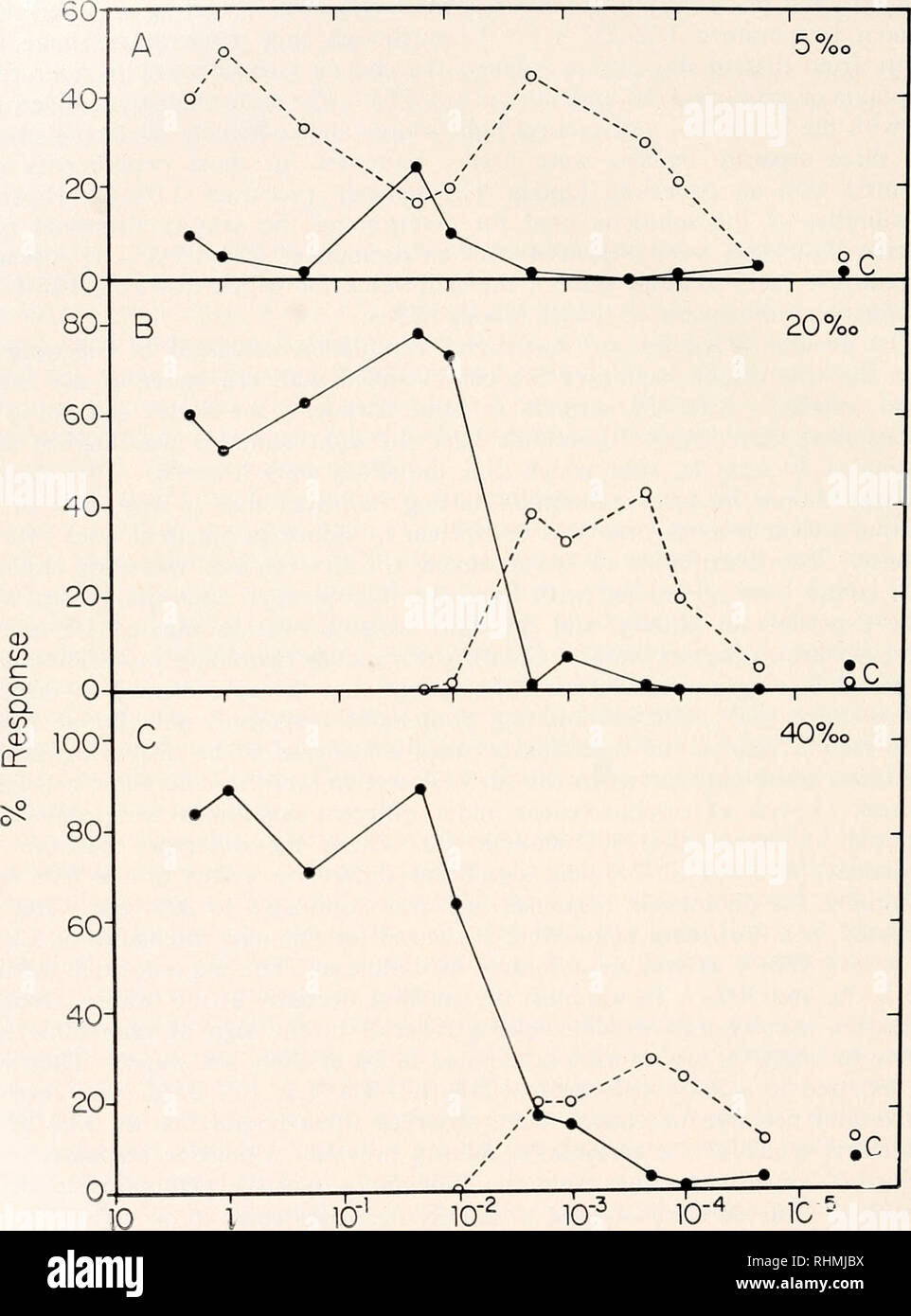 . The Biological bulletin. Biology; Zoology; Biology; Marine Biology. 166 M. I. LATZ AND R. B. FORWARD. Intensity (Wm 2) FIGURE 1. Stage I: per cent response (ordinate) of positive (solid dot-solid line) and negative (open dot-dashed line) phototaxis to various stimulation intensities of 500-nm light (absi isa) upon sudden exposure to salinities of S%o (A), 2Q% (B), and 40#« (C) for larvae acclimated t Random swimming in the positive (solid circle) and negative (open circle) direction wms determined with no stimuli present. Sample size for each point was 60 individuals. In 5%c sea water (A), t Stock Photohttps://www.alamy.com/image-license-details/?v=1https://www.alamy.com/the-biological-bulletin-biology-zoology-biology-marine-biology-166-m-i-latz-and-r-b-forward-intensity-wm-2-figure-1-stage-i-per-cent-response-ordinate-of-positive-solid-dot-solid-line-and-negative-open-dot-dashed-line-phototaxis-to-various-stimulation-intensities-of-500-nm-light-absi-isa-upon-sudden-exposure-to-salinities-of-so-a-2q-b-and-40-c-for-larvae-acclimated-t-random-swimming-in-the-positive-solid-circle-and-negative-open-circle-direction-wms-determined-with-no-stimuli-present-sample-size-for-each-point-was-60-individuals-in-5c-sea-water-a-t-image234637422.html
. The Biological bulletin. Biology; Zoology; Biology; Marine Biology. 166 M. I. LATZ AND R. B. FORWARD. Intensity (Wm 2) FIGURE 1. Stage I: per cent response (ordinate) of positive (solid dot-solid line) and negative (open dot-dashed line) phototaxis to various stimulation intensities of 500-nm light (absi isa) upon sudden exposure to salinities of S%o (A), 2Q% (B), and 40#« (C) for larvae acclimated t Random swimming in the positive (solid circle) and negative (open circle) direction wms determined with no stimuli present. Sample size for each point was 60 individuals. In 5%c sea water (A), t Stock Photohttps://www.alamy.com/image-license-details/?v=1https://www.alamy.com/the-biological-bulletin-biology-zoology-biology-marine-biology-166-m-i-latz-and-r-b-forward-intensity-wm-2-figure-1-stage-i-per-cent-response-ordinate-of-positive-solid-dot-solid-line-and-negative-open-dot-dashed-line-phototaxis-to-various-stimulation-intensities-of-500-nm-light-absi-isa-upon-sudden-exposure-to-salinities-of-so-a-2q-b-and-40-c-for-larvae-acclimated-t-random-swimming-in-the-positive-solid-circle-and-negative-open-circle-direction-wms-determined-with-no-stimuli-present-sample-size-for-each-point-was-60-individuals-in-5c-sea-water-a-t-image234637422.htmlRMRHMJBX–. The Biological bulletin. Biology; Zoology; Biology; Marine Biology. 166 M. I. LATZ AND R. B. FORWARD. Intensity (Wm 2) FIGURE 1. Stage I: per cent response (ordinate) of positive (solid dot-solid line) and negative (open dot-dashed line) phototaxis to various stimulation intensities of 500-nm light (absi isa) upon sudden exposure to salinities of S%o (A), 2Q% (B), and 40#« (C) for larvae acclimated t Random swimming in the positive (solid circle) and negative (open circle) direction wms determined with no stimuli present. Sample size for each point was 60 individuals. In 5%c sea water (A), t
![. The Biological bulletin. Biology; Zoology; Biology; Marine Biology. COPEPOD SPECTRAL SENSITIVITY 311 o o .c a. in O a.. 300 400 500 600 Wavelength [nm] 700 Figure 2. Spectral sensitivity of Calanopia americana. The percentage of copepods displaying positive phototaxis (upward swimming ± 30°) is plotted as a function of wavelength. All other symbols are as described for Figure 1. (Fig. 2). Positive phototactic responses significantly greater than the control value were found in the UVA (350, 380, 400 nm), with even greater response values from 420 to 580 nm (one-factor RM ANOVA. P < 0.001; Stock Photo . The Biological bulletin. Biology; Zoology; Biology; Marine Biology. COPEPOD SPECTRAL SENSITIVITY 311 o o .c a. in O a.. 300 400 500 600 Wavelength [nm] 700 Figure 2. Spectral sensitivity of Calanopia americana. The percentage of copepods displaying positive phototaxis (upward swimming ± 30°) is plotted as a function of wavelength. All other symbols are as described for Figure 1. (Fig. 2). Positive phototactic responses significantly greater than the control value were found in the UVA (350, 380, 400 nm), with even greater response values from 420 to 580 nm (one-factor RM ANOVA. P < 0.001; Stock Photo](https://c8.alamy.com/comp/RHM85E/the-biological-bulletin-biology-zoology-biology-marine-biology-copepod-spectral-sensitivity-311-o-o-c-a-in-o-a-300-400-500-600-wavelength-nm-700-figure-2-spectral-sensitivity-of-calanopia-americana-the-percentage-of-copepods-displaying-positive-phototaxis-upward-swimming-30-is-plotted-as-a-function-of-wavelength-all-other-symbols-are-as-described-for-figure-1-fig-2-positive-phototactic-responses-significantly-greater-than-the-control-value-were-found-in-the-uva-350-380-400-nm-with-even-greater-response-values-from-420-to-580-nm-one-factor-rm-anova-p-lt-0001-RHM85E.jpg) . The Biological bulletin. Biology; Zoology; Biology; Marine Biology. COPEPOD SPECTRAL SENSITIVITY 311 o o .c a. in O a.. 300 400 500 600 Wavelength [nm] 700 Figure 2. Spectral sensitivity of Calanopia americana. The percentage of copepods displaying positive phototaxis (upward swimming ± 30°) is plotted as a function of wavelength. All other symbols are as described for Figure 1. (Fig. 2). Positive phototactic responses significantly greater than the control value were found in the UVA (350, 380, 400 nm), with even greater response values from 420 to 580 nm (one-factor RM ANOVA. P < 0.001; Stock Photohttps://www.alamy.com/image-license-details/?v=1https://www.alamy.com/the-biological-bulletin-biology-zoology-biology-marine-biology-copepod-spectral-sensitivity-311-o-o-c-a-in-o-a-300-400-500-600-wavelength-nm-700-figure-2-spectral-sensitivity-of-calanopia-americana-the-percentage-of-copepods-displaying-positive-phototaxis-upward-swimming-30-is-plotted-as-a-function-of-wavelength-all-other-symbols-are-as-described-for-figure-1-fig-2-positive-phototactic-responses-significantly-greater-than-the-control-value-were-found-in-the-uva-350-380-400-nm-with-even-greater-response-values-from-420-to-580-nm-one-factor-rm-anova-p-lt-0001-image234629402.html
. The Biological bulletin. Biology; Zoology; Biology; Marine Biology. COPEPOD SPECTRAL SENSITIVITY 311 o o .c a. in O a.. 300 400 500 600 Wavelength [nm] 700 Figure 2. Spectral sensitivity of Calanopia americana. The percentage of copepods displaying positive phototaxis (upward swimming ± 30°) is plotted as a function of wavelength. All other symbols are as described for Figure 1. (Fig. 2). Positive phototactic responses significantly greater than the control value were found in the UVA (350, 380, 400 nm), with even greater response values from 420 to 580 nm (one-factor RM ANOVA. P < 0.001; Stock Photohttps://www.alamy.com/image-license-details/?v=1https://www.alamy.com/the-biological-bulletin-biology-zoology-biology-marine-biology-copepod-spectral-sensitivity-311-o-o-c-a-in-o-a-300-400-500-600-wavelength-nm-700-figure-2-spectral-sensitivity-of-calanopia-americana-the-percentage-of-copepods-displaying-positive-phototaxis-upward-swimming-30-is-plotted-as-a-function-of-wavelength-all-other-symbols-are-as-described-for-figure-1-fig-2-positive-phototactic-responses-significantly-greater-than-the-control-value-were-found-in-the-uva-350-380-400-nm-with-even-greater-response-values-from-420-to-580-nm-one-factor-rm-anova-p-lt-0001-image234629402.htmlRMRHM85E–. The Biological bulletin. Biology; Zoology; Biology; Marine Biology. COPEPOD SPECTRAL SENSITIVITY 311 o o .c a. in O a.. 300 400 500 600 Wavelength [nm] 700 Figure 2. Spectral sensitivity of Calanopia americana. The percentage of copepods displaying positive phototaxis (upward swimming ± 30°) is plotted as a function of wavelength. All other symbols are as described for Figure 1. (Fig. 2). Positive phototactic responses significantly greater than the control value were found in the UVA (350, 380, 400 nm), with even greater response values from 420 to 580 nm (one-factor RM ANOVA. P < 0.001;
 . Allgemeine Physiologie. Ein Grundriss der Lehre vom Leben. Biology; Physiology. Tis. 223. Fig. 224. Fig. 223. Pliototaxis der Diatomeen. In einem Tropfen liegt in der Mitte ein Schlamm- fetzen , der mit Diatomeen dicht besetzt war. Die Diatomeen sind sämmtlich nach dem der Sonne zugekehrten Tropfenrande gekrochen. Fig. 224. Phototaxis von Closterium. Das Licht fällt von rechts her ein. Der Pfeil giebt die Gleitrichtung des Closteriums an. sind. So finden wir, dass die Phototaxis unter den einzelligen Or- ganismen, soweit sie überhaupt durch Lichtstrahlen reizbar sind, eine weit verbreitete E Stock Photohttps://www.alamy.com/image-license-details/?v=1https://www.alamy.com/allgemeine-physiologie-ein-grundriss-der-lehre-vom-leben-biology-physiology-tis-223-fig-224-fig-223-pliototaxis-der-diatomeen-in-einem-tropfen-liegt-in-der-mitte-ein-schlamm-fetzen-der-mit-diatomeen-dicht-besetzt-war-die-diatomeen-sind-smmtlich-nach-dem-der-sonne-zugekehrten-tropfenrande-gekrochen-fig-224-phototaxis-von-closterium-das-licht-fllt-von-rechts-her-ein-der-pfeil-giebt-die-gleitrichtung-des-closteriums-an-sind-so-finden-wir-dass-die-phototaxis-unter-den-einzelligen-or-ganismen-soweit-sie-berhaupt-durch-lichtstrahlen-reizbar-sind-eine-weit-verbreitete-e-image237772595.html
. Allgemeine Physiologie. Ein Grundriss der Lehre vom Leben. Biology; Physiology. Tis. 223. Fig. 224. Fig. 223. Pliototaxis der Diatomeen. In einem Tropfen liegt in der Mitte ein Schlamm- fetzen , der mit Diatomeen dicht besetzt war. Die Diatomeen sind sämmtlich nach dem der Sonne zugekehrten Tropfenrande gekrochen. Fig. 224. Phototaxis von Closterium. Das Licht fällt von rechts her ein. Der Pfeil giebt die Gleitrichtung des Closteriums an. sind. So finden wir, dass die Phototaxis unter den einzelligen Or- ganismen, soweit sie überhaupt durch Lichtstrahlen reizbar sind, eine weit verbreitete E Stock Photohttps://www.alamy.com/image-license-details/?v=1https://www.alamy.com/allgemeine-physiologie-ein-grundriss-der-lehre-vom-leben-biology-physiology-tis-223-fig-224-fig-223-pliototaxis-der-diatomeen-in-einem-tropfen-liegt-in-der-mitte-ein-schlamm-fetzen-der-mit-diatomeen-dicht-besetzt-war-die-diatomeen-sind-smmtlich-nach-dem-der-sonne-zugekehrten-tropfenrande-gekrochen-fig-224-phototaxis-von-closterium-das-licht-fllt-von-rechts-her-ein-der-pfeil-giebt-die-gleitrichtung-des-closteriums-an-sind-so-finden-wir-dass-die-phototaxis-unter-den-einzelligen-or-ganismen-soweit-sie-berhaupt-durch-lichtstrahlen-reizbar-sind-eine-weit-verbreitete-e-image237772595.htmlRMRPRDAB–. Allgemeine Physiologie. Ein Grundriss der Lehre vom Leben. Biology; Physiology. Tis. 223. Fig. 224. Fig. 223. Pliototaxis der Diatomeen. In einem Tropfen liegt in der Mitte ein Schlamm- fetzen , der mit Diatomeen dicht besetzt war. Die Diatomeen sind sämmtlich nach dem der Sonne zugekehrten Tropfenrande gekrochen. Fig. 224. Phototaxis von Closterium. Das Licht fällt von rechts her ein. Der Pfeil giebt die Gleitrichtung des Closteriums an. sind. So finden wir, dass die Phototaxis unter den einzelligen Or- ganismen, soweit sie überhaupt durch Lichtstrahlen reizbar sind, eine weit verbreitete E
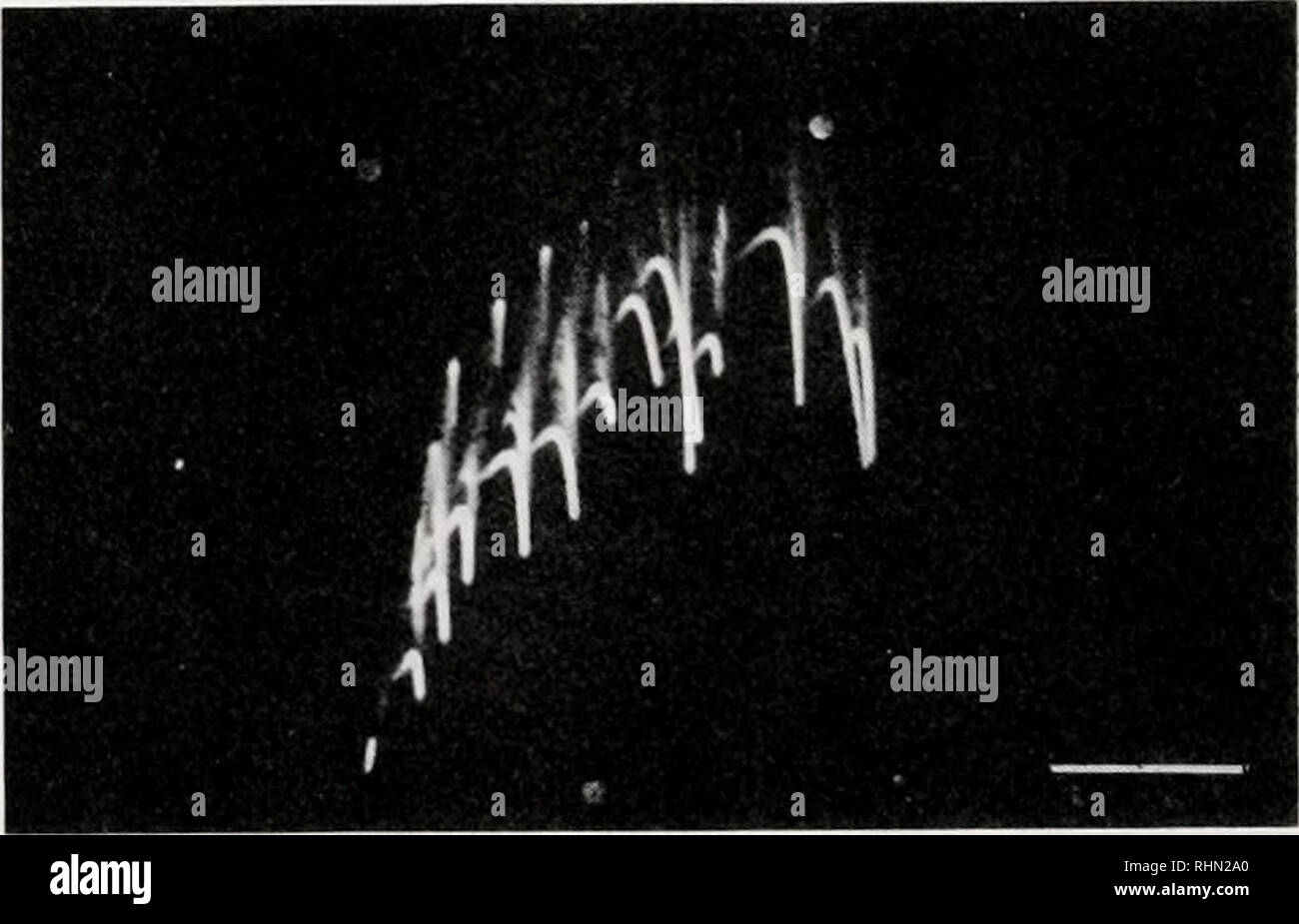 . The Biological bulletin. Biology; Zoology; Biology; Marine Biology. 10 c si - 0 50 500 5000 Light intensity (lux) 50000. FIGURE I. (Left) Phototaxis in a horizontal light beam. A: Percentages of positively photatactic worms (n = 20). B: Time required for the positively responded worms to reach the illuminated end. Vertical bars: Standard deviation. FIGURE 2. (Right) Photograph taken by 30 s continuous exposure, showing a typical phototactic trail of an arrow worm in a thin tank (8 X 1.5 cm, 6 cm deep). Light (5000 lux) entering from the right. Scale: I cm.. Please note that these images are Stock Photohttps://www.alamy.com/image-license-details/?v=1https://www.alamy.com/the-biological-bulletin-biology-zoology-biology-marine-biology-10-c-si-0-50-500-5000-light-intensity-lux-50000-figure-i-left-phototaxis-in-a-horizontal-light-beam-a-percentages-of-positively-photatactic-worms-n-=-20-b-time-required-for-the-positively-responded-worms-to-reach-the-illuminated-end-vertical-bars-standard-deviation-figure-2-right-photograph-taken-by-30-s-continuous-exposure-showing-a-typical-phototactic-trail-of-an-arrow-worm-in-a-thin-tank-8-x-15-cm-6-cm-deep-light-5000-lux-entering-from-the-right-scale-i-cm-please-note-that-these-images-are-image234646776.html
. The Biological bulletin. Biology; Zoology; Biology; Marine Biology. 10 c si - 0 50 500 5000 Light intensity (lux) 50000. FIGURE I. (Left) Phototaxis in a horizontal light beam. A: Percentages of positively photatactic worms (n = 20). B: Time required for the positively responded worms to reach the illuminated end. Vertical bars: Standard deviation. FIGURE 2. (Right) Photograph taken by 30 s continuous exposure, showing a typical phototactic trail of an arrow worm in a thin tank (8 X 1.5 cm, 6 cm deep). Light (5000 lux) entering from the right. Scale: I cm.. Please note that these images are Stock Photohttps://www.alamy.com/image-license-details/?v=1https://www.alamy.com/the-biological-bulletin-biology-zoology-biology-marine-biology-10-c-si-0-50-500-5000-light-intensity-lux-50000-figure-i-left-phototaxis-in-a-horizontal-light-beam-a-percentages-of-positively-photatactic-worms-n-=-20-b-time-required-for-the-positively-responded-worms-to-reach-the-illuminated-end-vertical-bars-standard-deviation-figure-2-right-photograph-taken-by-30-s-continuous-exposure-showing-a-typical-phototactic-trail-of-an-arrow-worm-in-a-thin-tank-8-x-15-cm-6-cm-deep-light-5000-lux-entering-from-the-right-scale-i-cm-please-note-that-these-images-are-image234646776.htmlRMRHN2A0–. The Biological bulletin. Biology; Zoology; Biology; Marine Biology. 10 c si - 0 50 500 5000 Light intensity (lux) 50000. FIGURE I. (Left) Phototaxis in a horizontal light beam. A: Percentages of positively photatactic worms (n = 20). B: Time required for the positively responded worms to reach the illuminated end. Vertical bars: Standard deviation. FIGURE 2. (Right) Photograph taken by 30 s continuous exposure, showing a typical phototactic trail of an arrow worm in a thin tank (8 X 1.5 cm, 6 cm deep). Light (5000 lux) entering from the right. Scale: I cm.. Please note that these images are
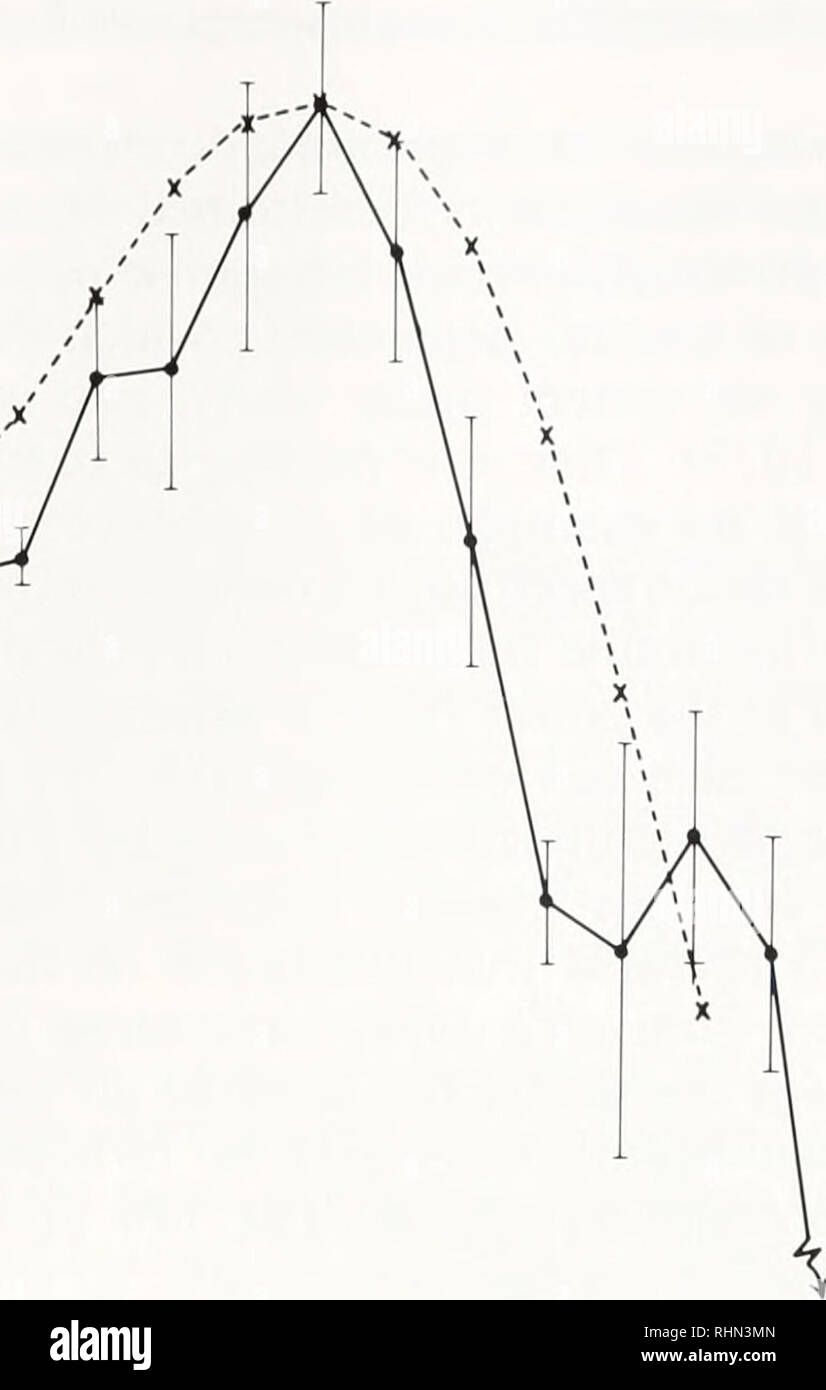 . The Biological bulletin. Biology; Zoology; Biology; Marine Biology. 36 A. J. SWEATT AND R. B. FORWARD, JR. I.OO-i 0.80- 0.60- 0.40- !> 0.20- tfi 0) CO o> 0.10 — B 0.08- O) rr 0.06- 0.04- OO?- 0.01-. 400 440 480 520 560 Wavelength (nm) 600 640 FIGURE 2. Action spectrum for positive phototaxis by 5. hispida. For each wavelength the reciprocal of the quanta! flux required to elicit 30% phototaxis was calculated. Each value was then divided by the value obtained at 500 nm, where sensitivity was maximal. This quotient is shown as the relative sensitivity. Error bars were calculated similarl Stock Photohttps://www.alamy.com/image-license-details/?v=1https://www.alamy.com/the-biological-bulletin-biology-zoology-biology-marine-biology-36-a-j-sweatt-and-r-b-forward-jr-ioo-i-080-060-040-!gt-020-tfi-0-co-ogt-010-b-008-o-rr-006-004-oo-001-400-440-480-520-560-wavelength-nm-600-640-figure-2-action-spectrum-for-positive-phototaxis-by-5-hispida-for-each-wavelength-the-reciprocal-of-the-quanta!-flux-required-to-elicit-30-phototaxis-was-calculated-each-value-was-then-divided-by-the-value-obtained-at-500-nm-where-sensitivity-was-maximal-this-quotient-is-shown-as-the-relative-sensitivity-error-bars-were-calculated-similarl-image234647861.html
. The Biological bulletin. Biology; Zoology; Biology; Marine Biology. 36 A. J. SWEATT AND R. B. FORWARD, JR. I.OO-i 0.80- 0.60- 0.40- !> 0.20- tfi 0) CO o> 0.10 — B 0.08- O) rr 0.06- 0.04- OO?- 0.01-. 400 440 480 520 560 Wavelength (nm) 600 640 FIGURE 2. Action spectrum for positive phototaxis by 5. hispida. For each wavelength the reciprocal of the quanta! flux required to elicit 30% phototaxis was calculated. Each value was then divided by the value obtained at 500 nm, where sensitivity was maximal. This quotient is shown as the relative sensitivity. Error bars were calculated similarl Stock Photohttps://www.alamy.com/image-license-details/?v=1https://www.alamy.com/the-biological-bulletin-biology-zoology-biology-marine-biology-36-a-j-sweatt-and-r-b-forward-jr-ioo-i-080-060-040-!gt-020-tfi-0-co-ogt-010-b-008-o-rr-006-004-oo-001-400-440-480-520-560-wavelength-nm-600-640-figure-2-action-spectrum-for-positive-phototaxis-by-5-hispida-for-each-wavelength-the-reciprocal-of-the-quanta!-flux-required-to-elicit-30-phototaxis-was-calculated-each-value-was-then-divided-by-the-value-obtained-at-500-nm-where-sensitivity-was-maximal-this-quotient-is-shown-as-the-relative-sensitivity-error-bars-were-calculated-similarl-image234647861.htmlRMRHN3MN–. The Biological bulletin. Biology; Zoology; Biology; Marine Biology. 36 A. J. SWEATT AND R. B. FORWARD, JR. I.OO-i 0.80- 0.60- 0.40- !> 0.20- tfi 0) CO o> 0.10 — B 0.08- O) rr 0.06- 0.04- OO?- 0.01-. 400 440 480 520 560 Wavelength (nm) 600 640 FIGURE 2. Action spectrum for positive phototaxis by 5. hispida. For each wavelength the reciprocal of the quanta! flux required to elicit 30% phototaxis was calculated. Each value was then divided by the value obtained at 500 nm, where sensitivity was maximal. This quotient is shown as the relative sensitivity. Error bars were calculated similarl